Le Livre de la chasse
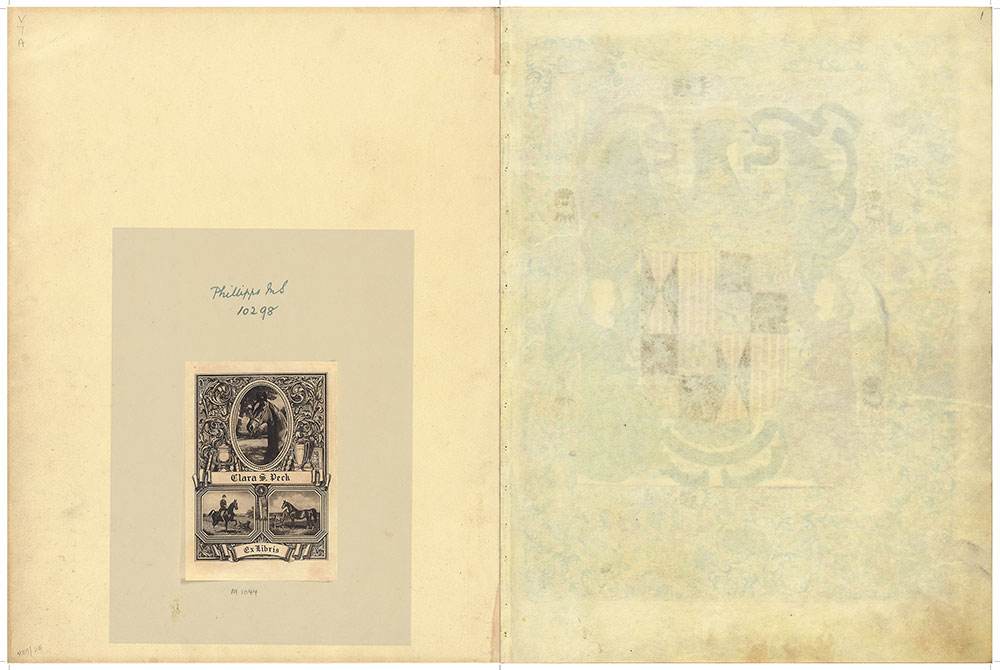
Livre de la chasse
Bequest of Clara S. Peck, 1983
Image courtesy of Faksimile Verlag Luzern
MS M.1044, fols. 1v–2r
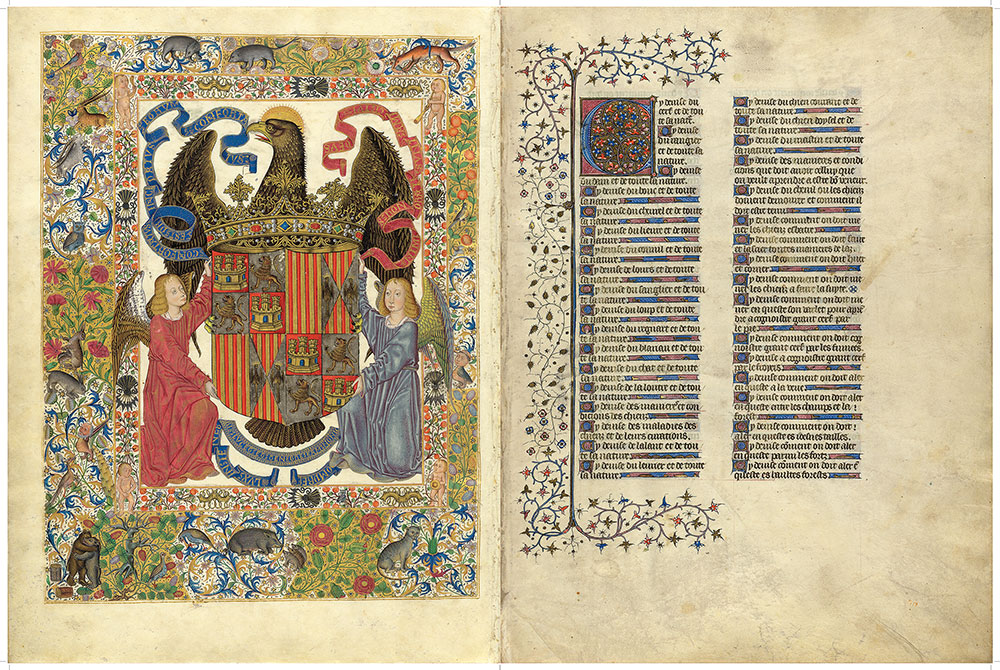
Livre de la chasse
Bequest of Clara S. Peck, 1983
Ex Libris of King Ferdinand II of Aragon and Queen Isabella of Spain
The Morgan Phoebus, a book fit for a king, was given to Ferdinand and Isabella a few years before 1492, when they retook Granada and added the pomegranate (its symbol) to their coat of arms. As a sign of their ownership, they commissioned a Castilian artist connected with Juan de Carrion to add this splendid ex libris to the manuscript. The emblems in the inner border reflect the monarchs' conjugal bond, for each used the one belonging to the initial of the other: Ferdinand, the yoke (iugo, the I) and Isabella, the arrow (flecha, the F). The animals in the outer border offer a prelude to the manuscript, as they are quoted from its miniatures.
Table of Contents
Tables of contents, or chapter headings, have a long history, as examples from antiquity attest. They became increasingly popular during the later Middle Ages, especially in secular manuscripts. Here, for example, are the headings for chapters one to thirty-five. Those for the remaining fifty chapters are on the next two pages. The heading for the first chapter is Cy devise du cerf et de toute sa nature (Here is discussed the stag and all its nature). This heading is repeated in red as the rubric for the text that follows the miniature depicting stags (shown in the case to the right). This pattern of miniature, chapter heading (rubric), and text is followed throughout the manuscript.
Image courtesy of Faksimile Verlag Luzern
MS M.1044, fols. 2v–3r
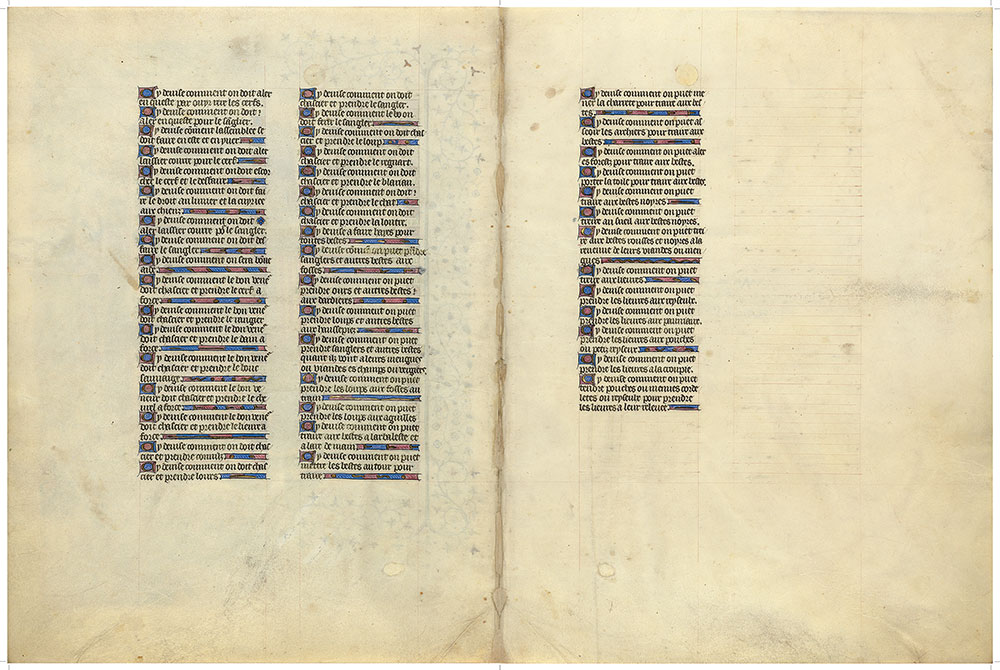
Livre de la chasse
Bequest of Clara S. Peck, 1983
Image courtesy of Faksimile Verlag Luzern
MS M.1044, fols. 3v–4r
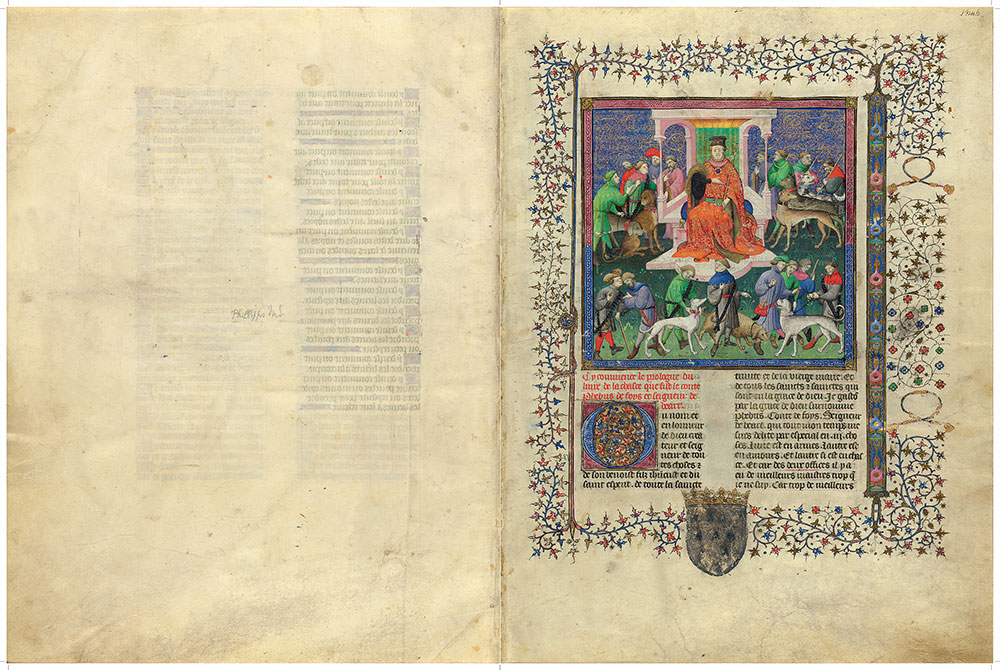
Livre de la chasse
Bequest of Clara S. Peck, 1983
Final Instructions Before The Hunt
Following a long medieval tradition going back to antiquity, the manuscript begins with an author portrait. Gaston Phoebus, however, is not shown writing, as might be expected, but giving final instructions before the hunt commences. He, as the rubric for the author's prologue states, was the Count of Foix and Viscount of Béarn. Here he is seated on an elaborate throne, in a composition that has been likened to a Maiestas Domini. Instead of nine angelic choirs, however, there are nine hunters and dogs instead of the symbols of the evangelists. At the bottom are eight more hunters (three are beaters) and three dogs. Among the dogs are beagles, greyhounds, spaniels, and alants. The miniature precedes the prologue, in which Phoebus invoked the Trinity and the Mother of God, gave Phoebus as his nickname, and spoke about the virtues of hunting. By overcoming idleness, the hunter avoided the seven deadly sins, could savor the fresh morning air, would experience the joy of a successful hunt, would enjoy the celebratory meal, and would sleep peacefully, undisturbed by bad dreams. Hunters would also live longer and enter Paradise when they die. The arms of the first owner at the bottom of the page have been replaced by those of the second, probably Francis II, Duke of Brittany (r. 1458–88), who first adopted the cordelière as an emblem.
Image courtesy of Faksimile Verlag Luzern
MS M.1044, fols. 4v–5r
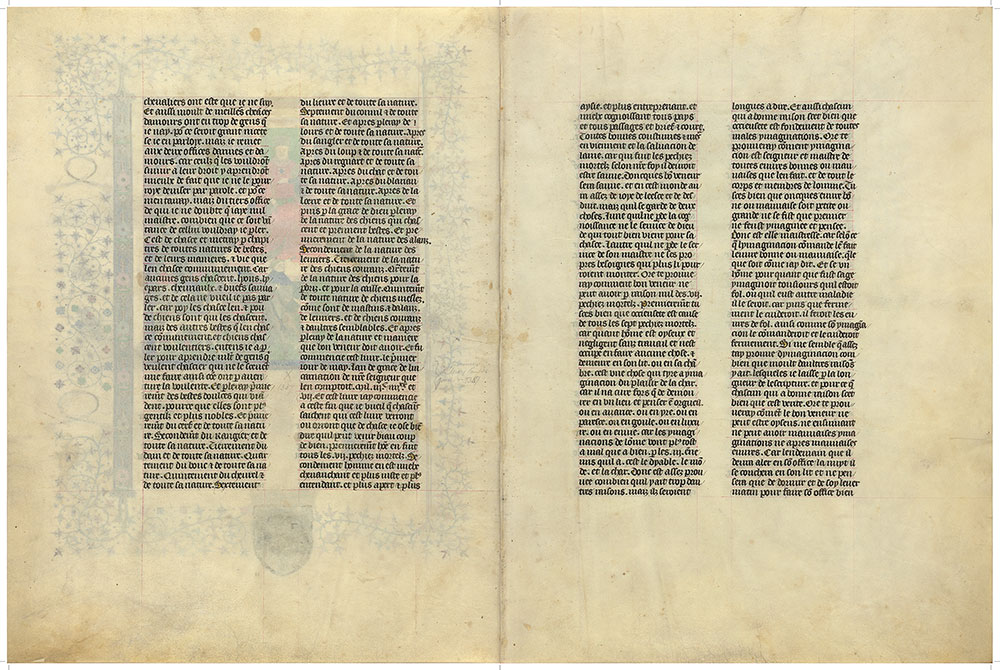
Livre de la chasse
Bequest of Clara S. Peck, 1983
Image courtesy of Faksimile Verlag Luzern
MS M.1044, fols. 5v–6r
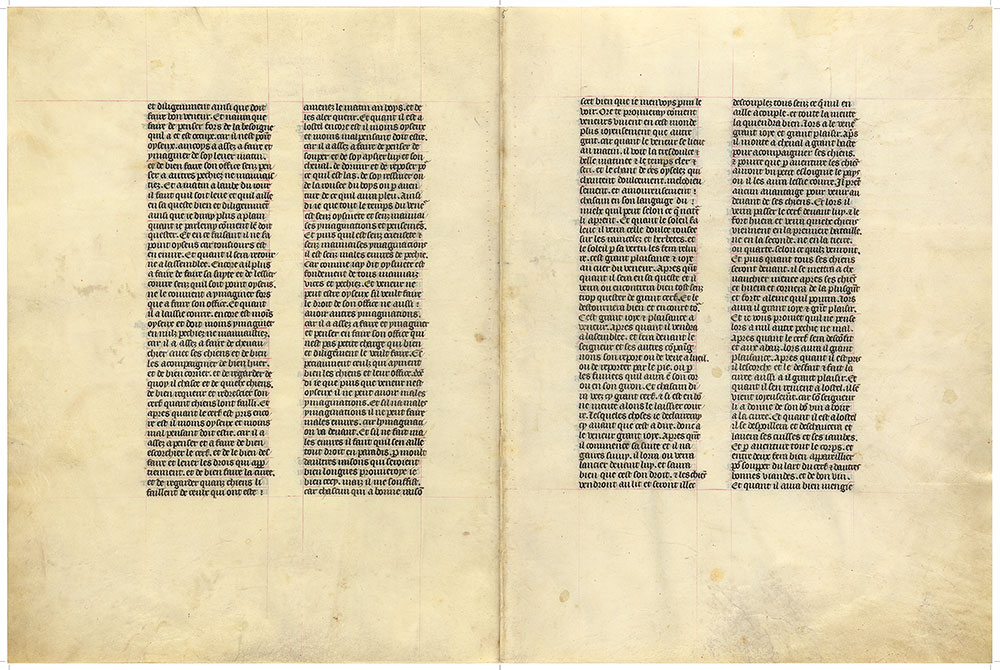
Livre de la chasse
Bequest of Clara S. Peck, 1983
Image courtesy of Faksimile Verlag Luzern
MS M.1044, fols. 6v–7r
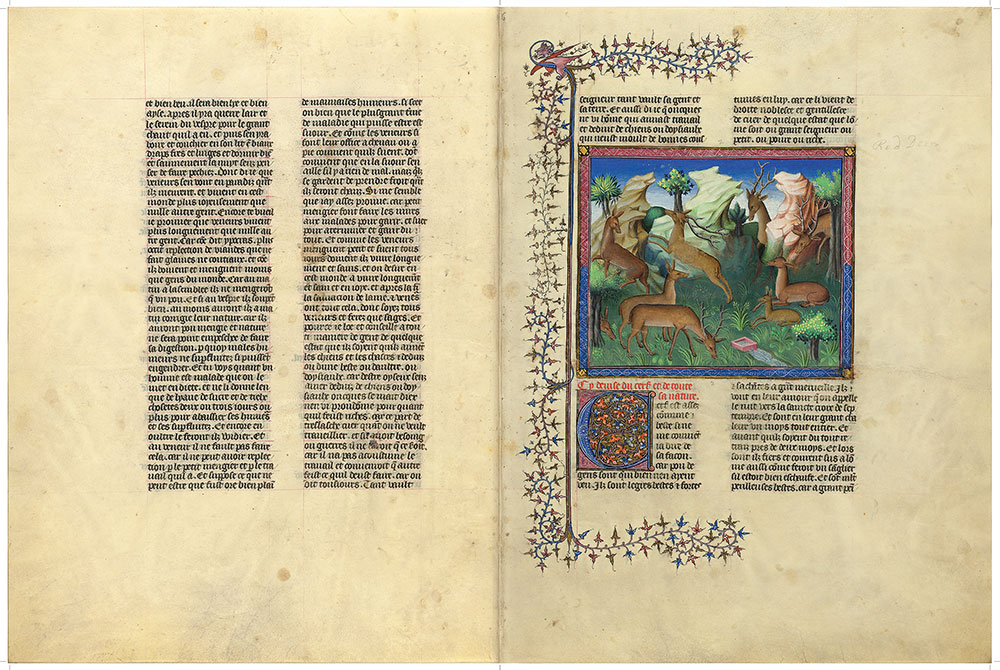
Livre de la chasse
Bequest of Clara S. Peck, 1983
Image courtesy of Faksimile Verlag Luzern
MS M.1044, fols. 7v–8r

Livre de la chasse
Bequest of Clara S. Peck, 1983
The Hart
The hart, or stag, was the favorite and most noble game for the French hunter, and thus Phoebus began his manual with it. Because of its strength, fleetness, and cunning, it was an ideal candidate for the hunt. King Modus specified that stag hunting season fell between the two feasts of the Holy Cross (May 3 and September 14), but that sometime around the feast day of Mary Magdalene (July 22) was best, for then the stags were in great condition. According to earlier legends repeated by Phoebus, stags could live a hundred years and their antlers, as well as a special bone in the heart, had the power to heal.
The miniatures for each animal usually depict both male and female specimens and their young. Here are four great old stags, four hinds, and a calf. The animals are shown in a clearing in the woods with a blue sky in the background. The miniatures precede the texts for each chapter.
Image courtesy of Faksimile Verlag Luzern
MS M.1044, fols. 8v–9r
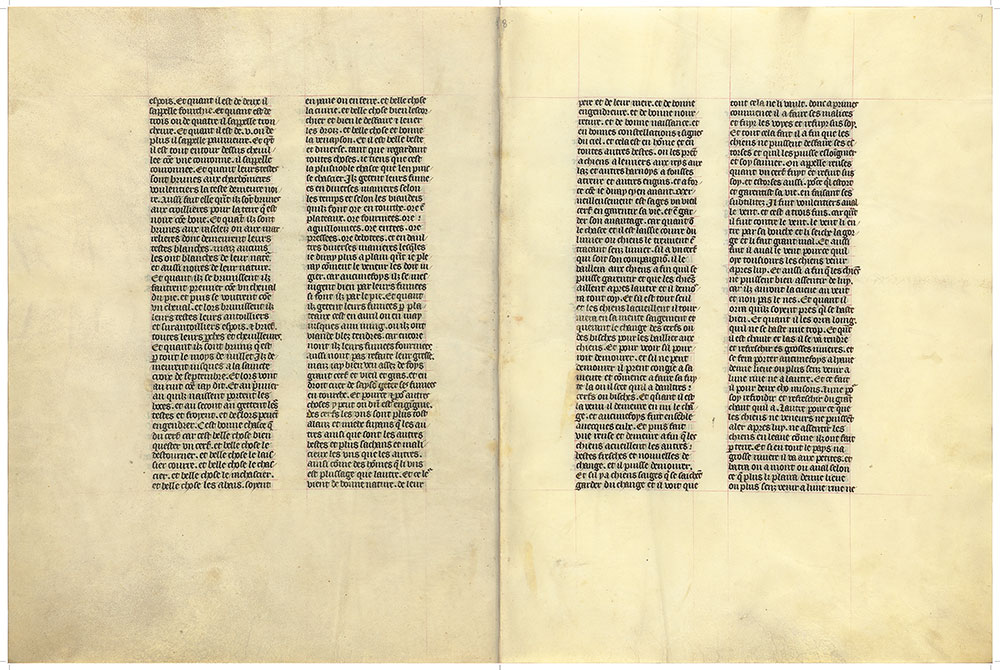
Livre de la chasse
Bequest of Clara S. Peck, 1983
Image courtesy of Faksimile Verlag Luzern
MS M.1044, fols. 9v–10r
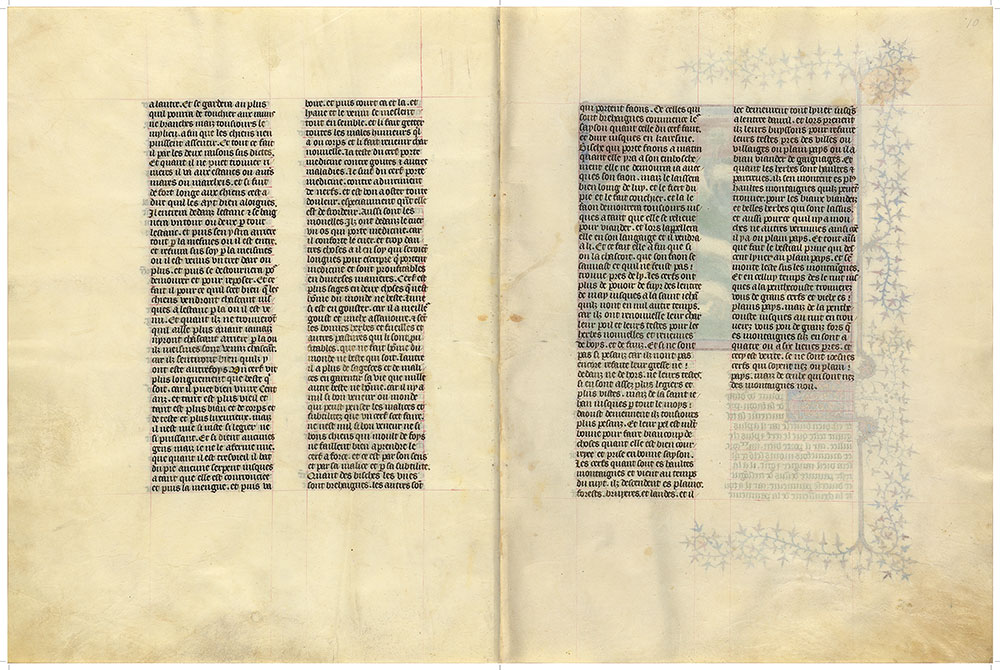
Livre de la chasse
Bequest of Clara S. Peck, 1983
Image courtesy of Faksimile Verlag Luzern
MS M.1044, fols. 10v–11r
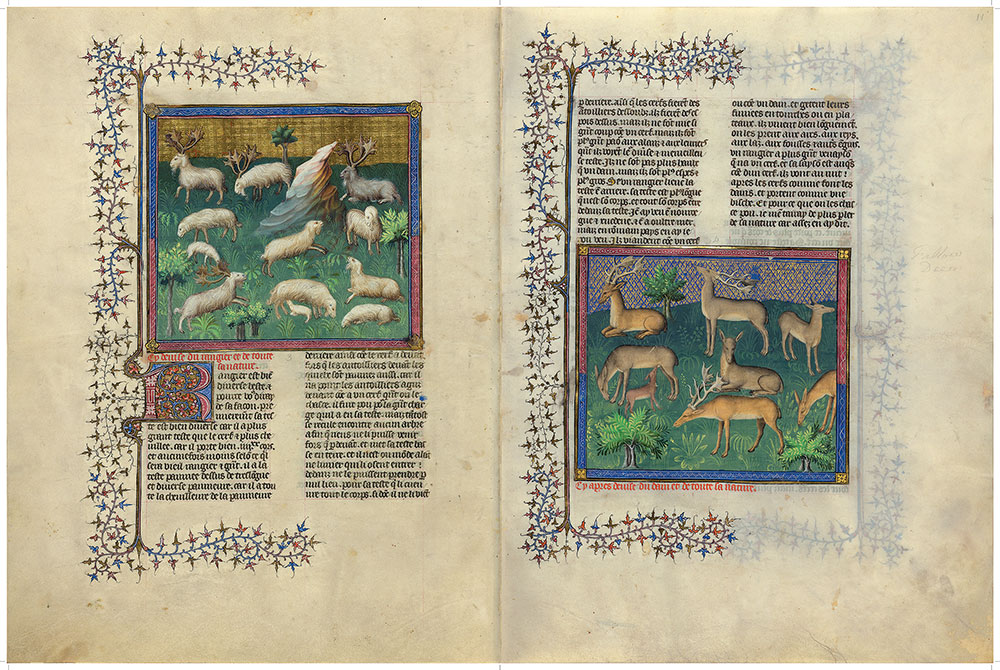
Livre de la chasse
Bequest of Clara S. Peck, 1983
The Reindeer
Phoebus had traveled to Norway and Sweden, where he claimed to have seen and hunted this "rather peculiar" deer. He was amazed by its many branched antlers, which were protective and could, he said, extend the entire length of its body. Phoebus included them for the sake of completeness. Georges Buffon (1707–1788), the French naturalist, mistakenly assumed, based on Phoebus, that reindeer could still be found in the Pyrenees in the late fourteenth century. The miniature, however, clearly shows it was not the case, as the artist apparently never saw one and depicted them as wool-bearing creatures. Some of them are correctly shown eating grass, which they ate in great quantities during the summer months.
Image courtesy of Faksimile Verlag Luzern
MS M.1044, fols. 11v–12r
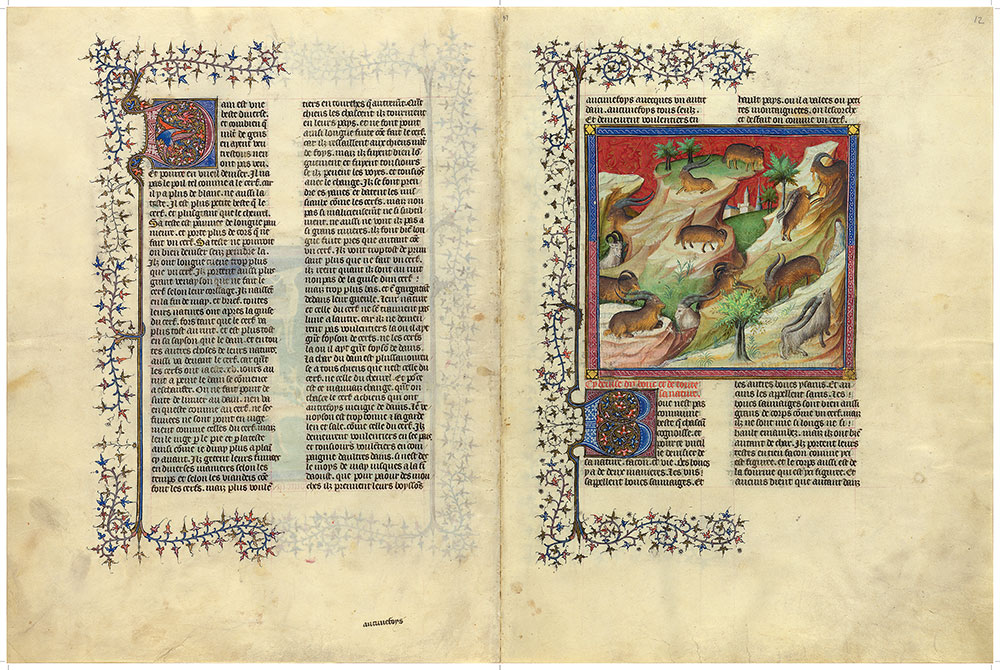
Livre de la chasse
Bequest of Clara S. Peck, 1983
The Wild Goat
Phoebus identified two kinds of wild goats, the ibex and the Pyrenean chamois, which he mistakenly thought were related. The latter was distinguished by its shorter, hooked horns. Both were capable of breaking a high jump with their horns rather than their legs. Peasants used their skins for making clothing and shoes, and, if nothing better was available, ate their flesh for food. Phoebus despised goat meat, claiming it caused fever. Since these animals lived in high, craggy places and they could outpace dogs, it was difficult to hunt them. In the background are the roofs and towers of a small Pyrenean village.
Image courtesy of Faksimile Verlag Luzern
MS M.1044, fols. 12v–13r
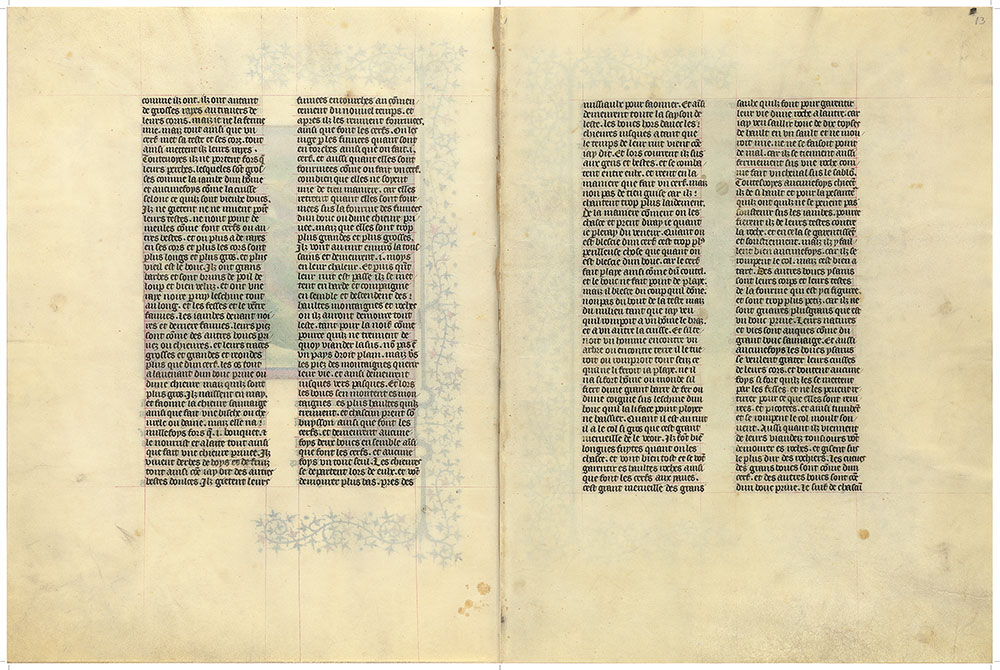
Livre de la chasse
Bequest of Clara S. Peck, 1983
Image courtesy of Faksimile Verlag Luzern
MS M.1044, fols. 13v–14r
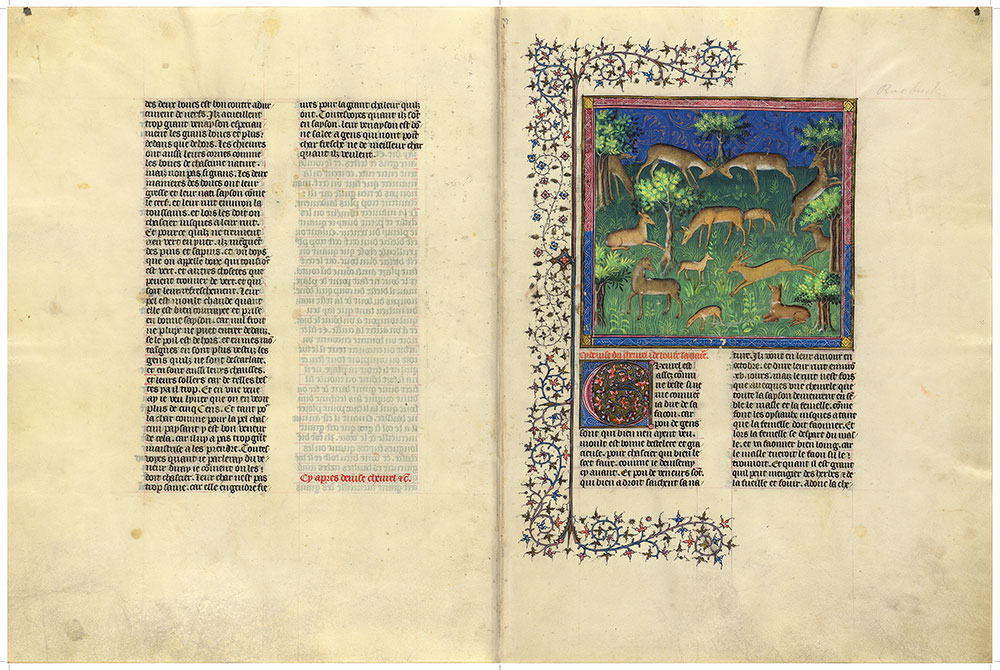
Livre de la chasse
Bequest of Clara S. Peck, 1983
The Roe
The roebuck, because of its small size, was graceful and swift and thus better able to elude the hunter. It was the most common game and could be hunted throughout the year. The roe's monogamy was greatly appreciated by hunters, who spared the doe until her kids no longer depended on her for survival. After the kids were weaned, the doe would rejoin the buck, and they remained together until death. The doe's maternal devotion made it an occasional symbol of chastity in art. Although not depicted here, the roe's rump would bristle and turn white when pursued, sending an alarm to other roes in the vicinity
Image courtesy of Faksimile Verlag Luzern
MS M.1044, fols. 14v–15r
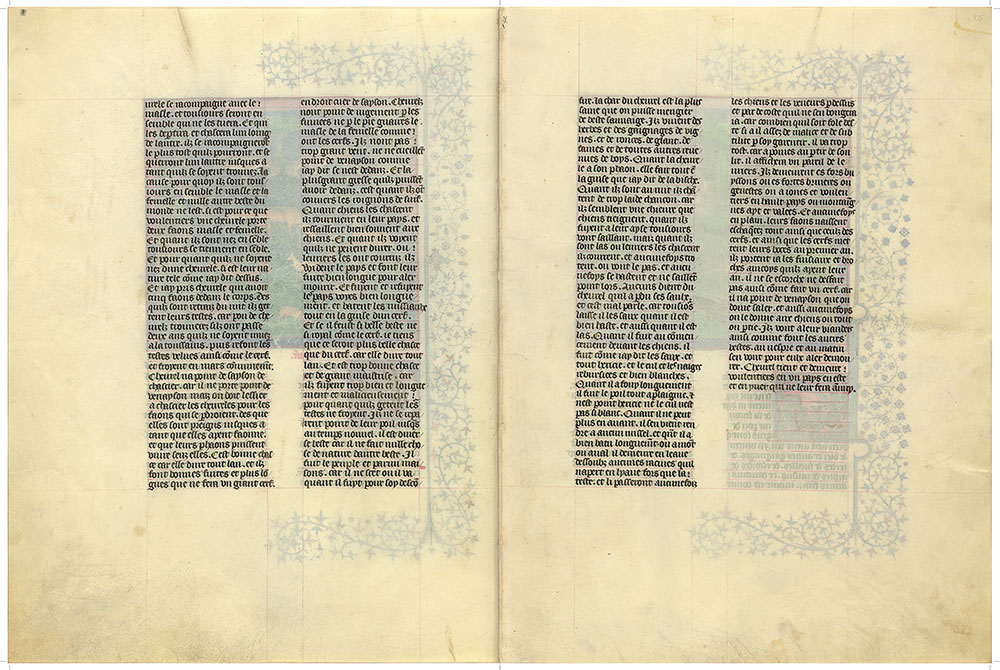
Livre de la chasse
Bequest of Clara S. Peck, 1983
Image courtesy of Faksimile Verlag Luzern
MS M.1044, fols. 15v–16r
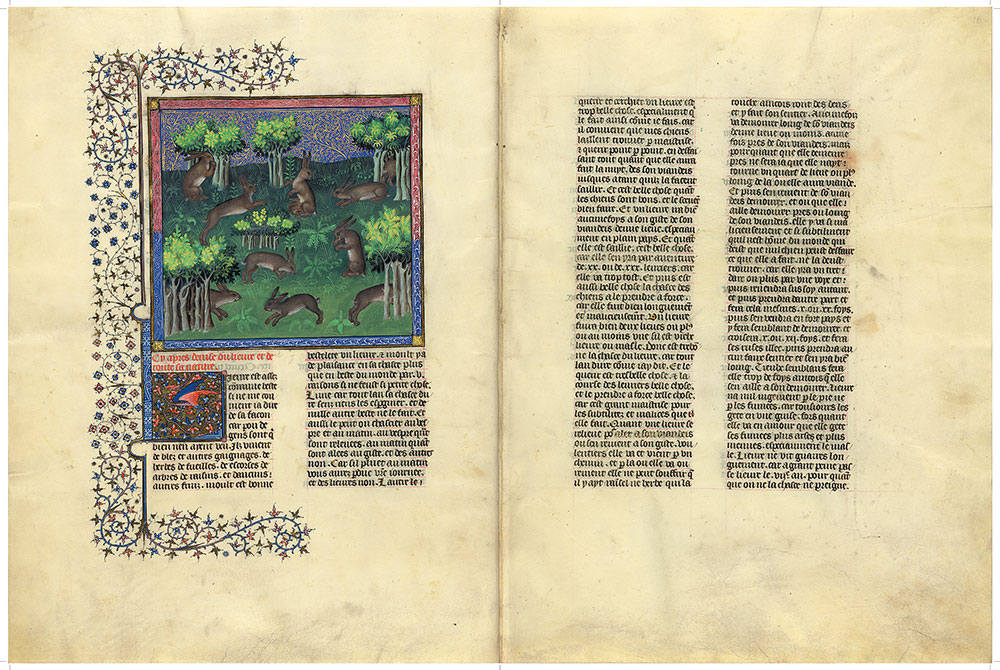
Livre de la chasse
Bequest of Clara S. Peck, 1983
The Hare
Hares lived in droves of five or six and, having spent the day sleeping, would leave their abodes at sunset for pastures of wild thyme, mint, and clover. They would mate year-round, and the female would usually give birth to two leverets, but could have up to six. The ability of dogs tracking hares was severely tested because hares' tracks crisscrossed, their ears were sensitive to the slightest sound, and their quivering noses were quick to detect suspect scents. The hare was frequently depicted in the margins of medieval manuscripts as part of the world upside-down theme, where by he would become the hunter–—blowing a horn, chasing a hound or wolf, or even hunting a man.
Image courtesy of Faksimile Verlag Luzern
MS M.1044, fols. 16v–17r

Livre de la chasse
Bequest of Clara S. Peck, 1983
Image courtesy of Faksimile Verlag Luzern
MS M.1044, fols. 17v–18r
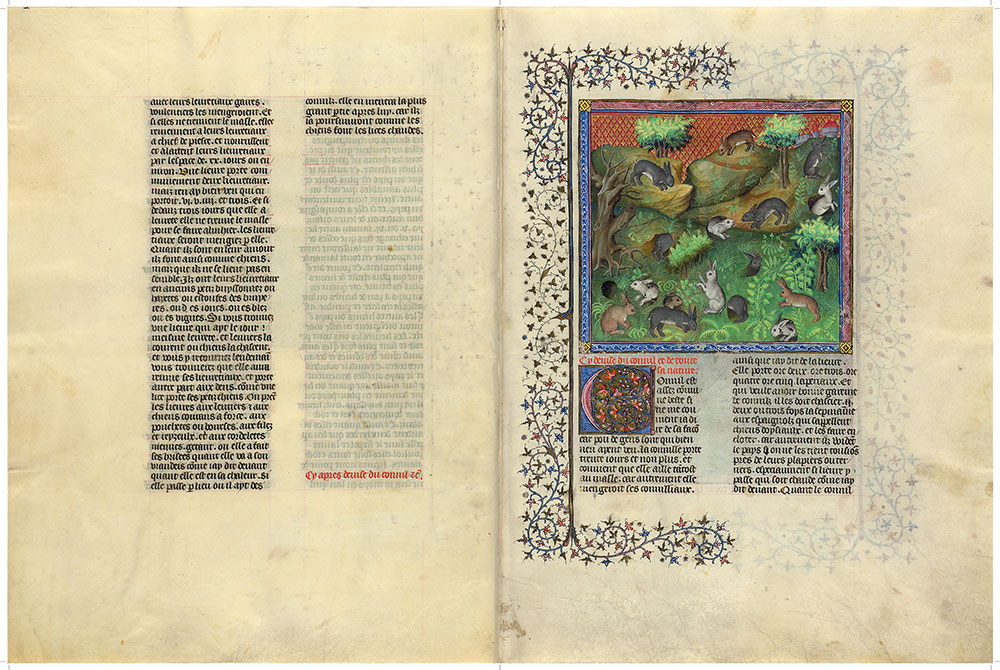
Livre de la chasse
Bequest of Clara S. Peck, 1983
Image courtesy of Faksimile Verlag Luzern
MS M.1044, fols. 18v–19r
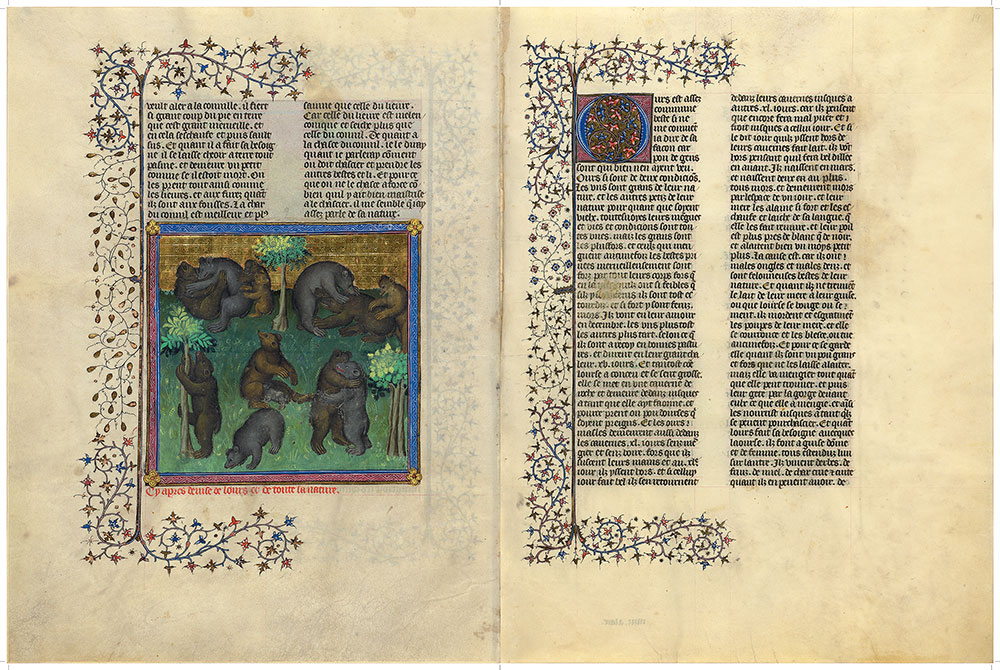
Livre de la chasse
Bequest of Clara S. Peck, 1983
The Bear
Bears were generally afraid of humans, but when injured, because of their strong teeth and arms, could bite or maul them to death. Consequently Phoebus did not recommend that hunters attempt to kill a bear by themselves. (It is ironic that Phoebus died while washing his hands after an arduous bear hunt.) In the miniature, black and brown bears are engaged in various activities with each other or their cubs. One climbs a fruit tree, while a pair seems to illustrate Phoebus's observation that "when the bear has his way with the she bear, they do it like man and woman." He further added that the cubs were stillborn in March, after which their mother licked them into shape and life. Oppian, the second-century Cilician, had written that the female so lusted for continual mating that she brought forth her cubs as half-formed shapeless flesh, making it necessary for her to lick them into existence.
Image courtesy of Faksimile Verlag Luzern
MS M.1044, fols. 19v–20r
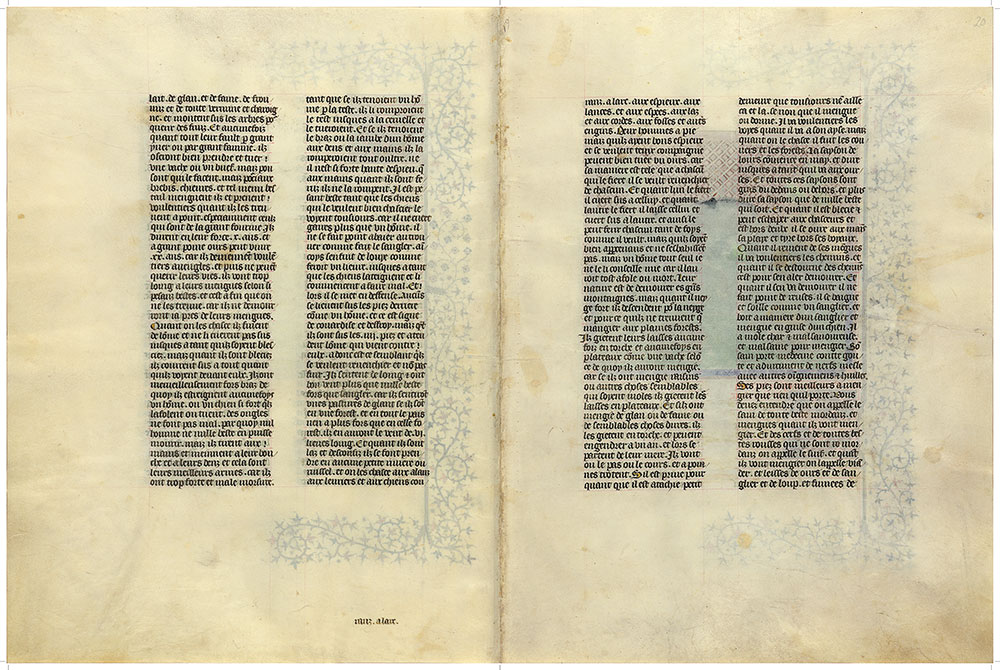
Livre de la chasse
Bequest of Clara S. Peck, 1983
Image courtesy of Faksimile Verlag Luzern
MS M.1044, fols. 20v–21r
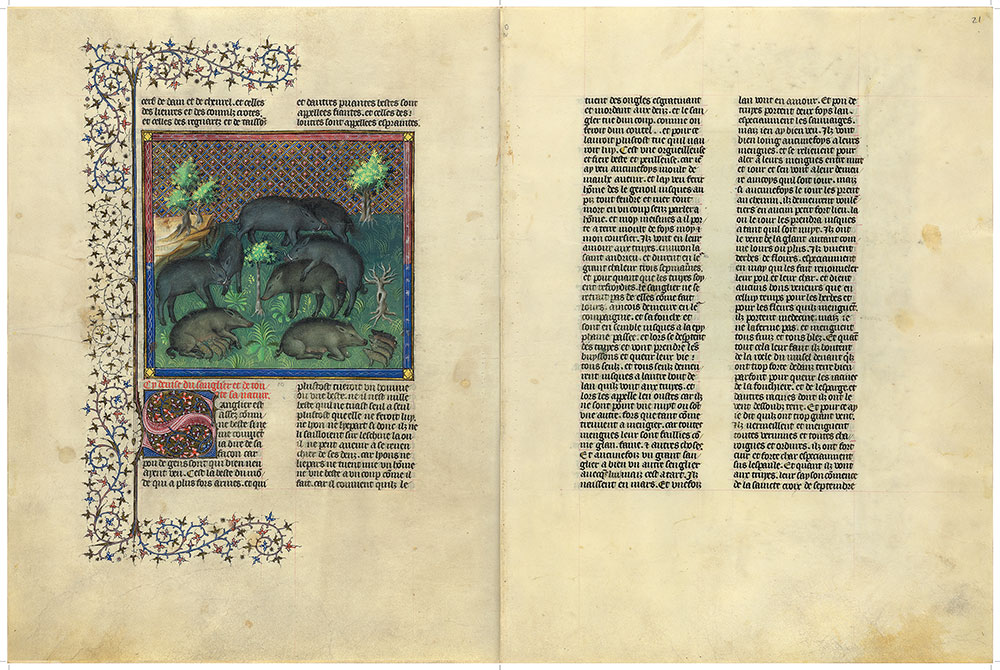
Livre de la chasse
Bequest of Clara S. Peck, 1983
The Wild Boar
The boar, to medieval man, was the polar opposite of the stag. The former was massive, ugly, ferocious, and represented evil, while the latter was elegant and timid, representing virtue. For Phoebus, the boar was the most dangerous animal in the world. Its upper tusks were used to keep the lower ones sharp and cutting. The hunting season went from Holy Cross Day (September 14), or from Michaelmas (September 30), when boars were fleshiest, to St. Andrew's Day (November 30), when they found sows for mating. The boar, like the stag, was hunted with dogs. The boar had a definite sexual element and one pair in the miniature is depicted copulating. Some hunters prized its testicles as a delicacy. Tristan's heraldic device was the boar; it played a role in Majadoc's dream regarding Tristan's seduction of Isolde, wife of King Mark. In the dream, a fearsome boar, foaming at the mouth, broke into the king's bedchamber, fouling the royal linen with its foam.
Image courtesy of Faksimile Verlag Luzern
MS M.1044, fols. 21v–22r
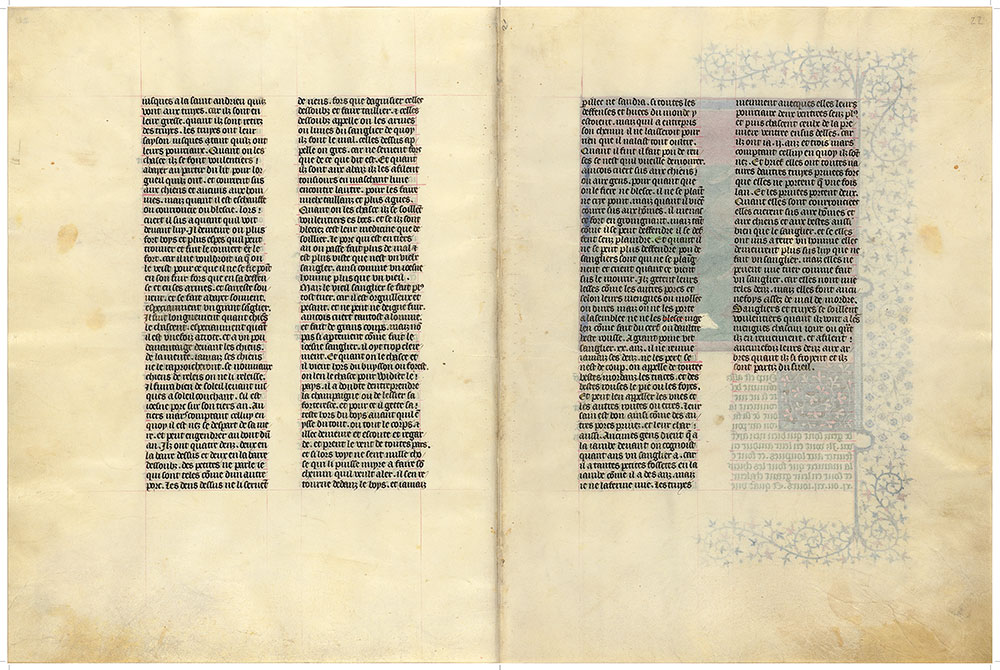
Livre de la chasse
Bequest of Clara S. Peck, 1983
Image courtesy of Faksimile Verlag Luzern
MS M.1044, fols. 22v–23r
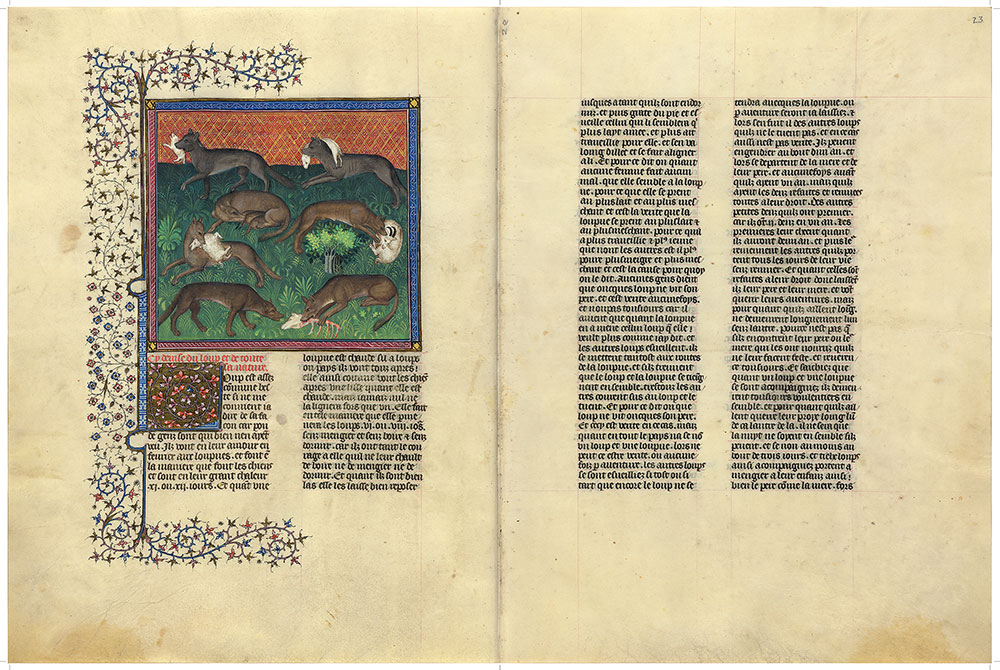
Livre de la chasse
Bequest of Clara S. Peck, 1983
The Wolf
The wolf was probably the most feared and hated animal. According to Phoebus, the wolf could kill an animal as large as a cow and could run away with a sheep or goat in its mouth. It was a menace because it could kill a flock of sheep before eating one of them. Even worse, it used humans as a food source, following armies and eating dead soldiers. Wolves were also cruel to other wolves. After a she wolf had selected a mate he was put to death by his jealous fellows. Thus no wolf ever saw his father. Queen Ratio criticized fourteenth-century parish priests who were supposed to protect their flocks, but who, like wolves, preyed on them instead. According to the Book of St. Albans, the wolf was hunted from the Nativity of the Virgin Mary (September 8) to the Annunciation (March 25).
Image courtesy of Faksimile Verlag Luzern
MS M.1044, fols. 23v–24r
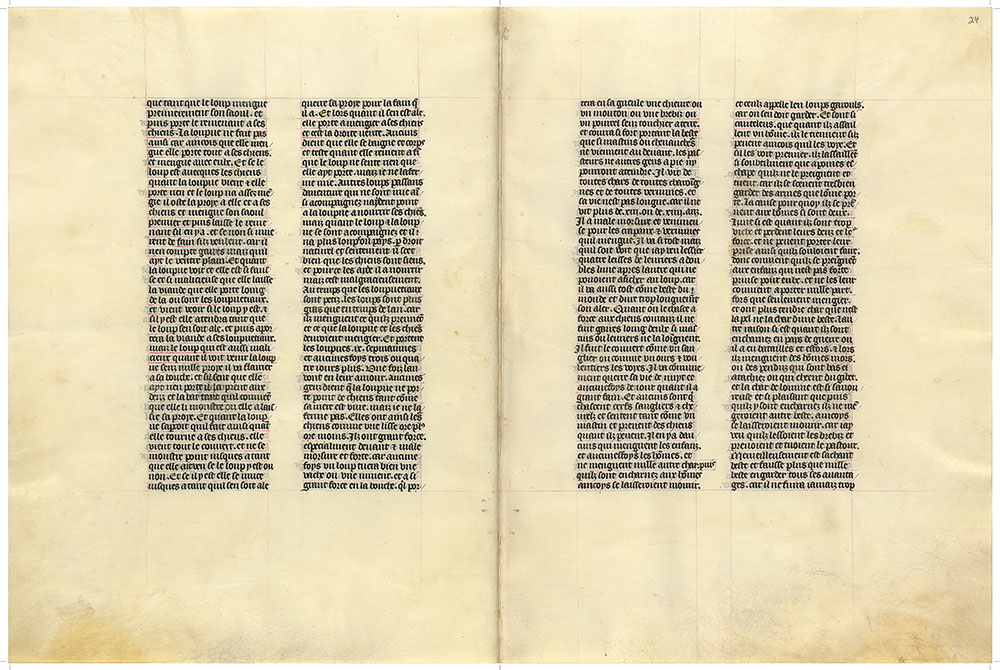
Livre de la chasse
Bequest of Clara S. Peck, 1983
Image courtesy of Faksimile Verlag Luzern
MS M.1044, fols. 24v–25r
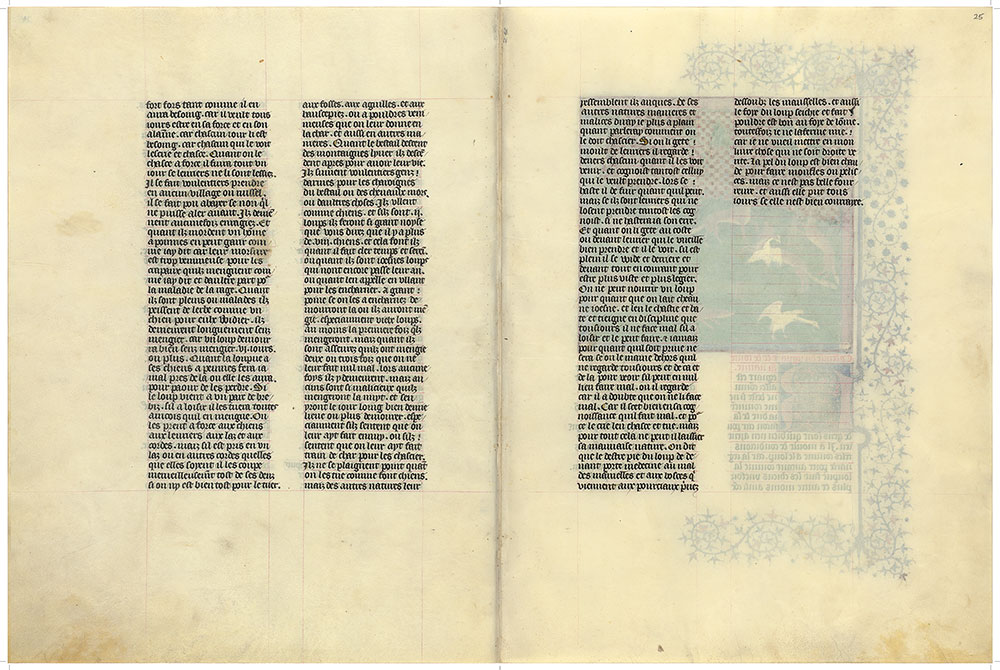
Livre de la chasse
Bequest of Clara S. Peck, 1983
Image courtesy of Faksimile Verlag Luzern
MS M.1044, fols. 25v–26r
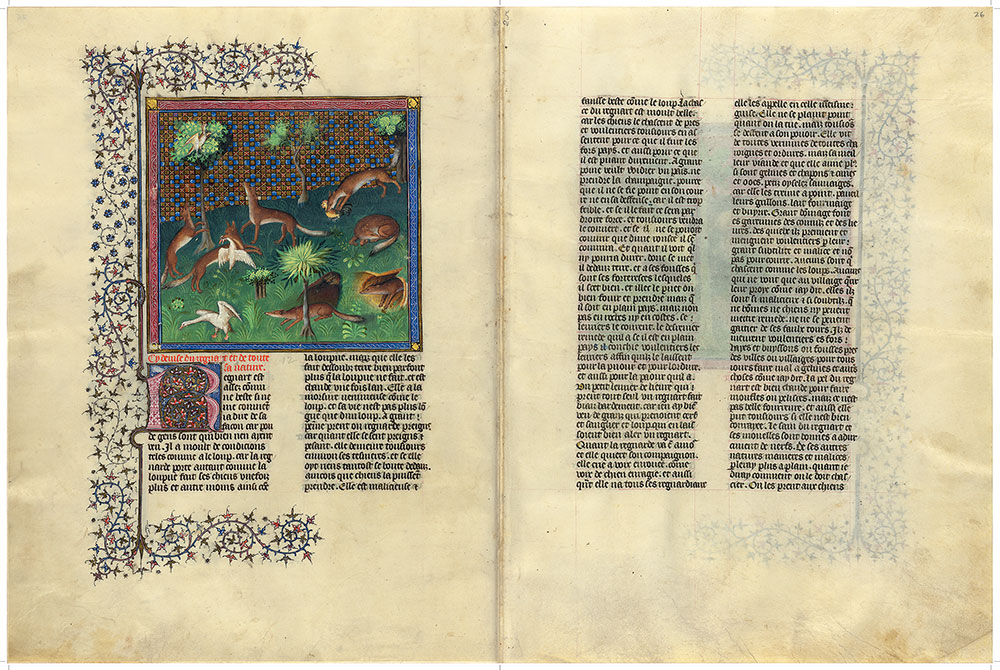
Livre de la chasse
Bequest of Clara S. Peck, 1983
Image courtesy of Faksimile Verlag Luzern
MS M.1044, fols. 26v–27r
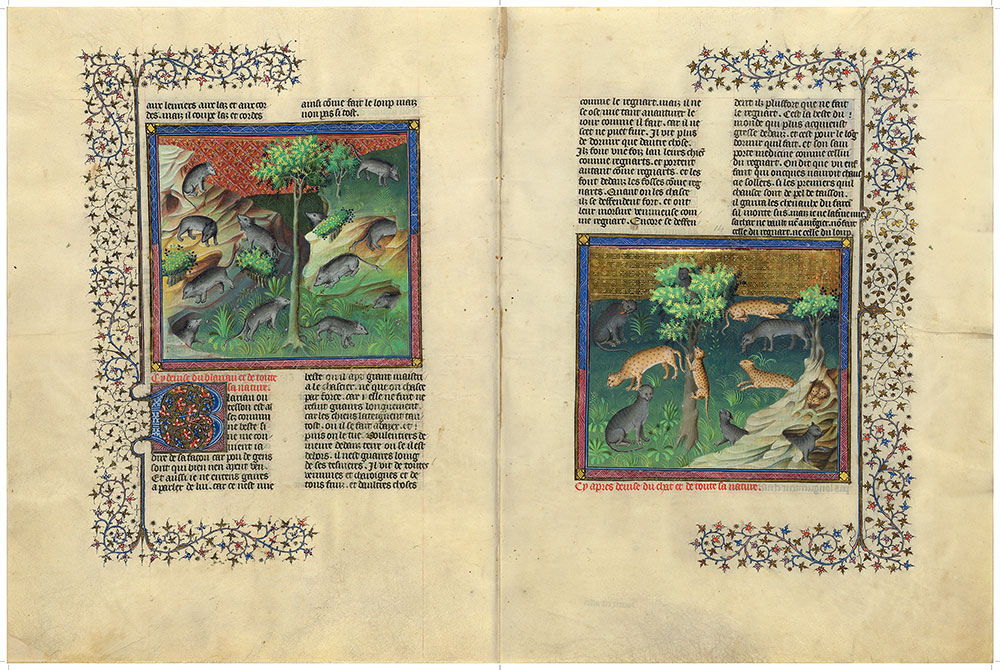
Livre de la chasse
Bequest of Clara S. Peck, 1983
The Badger
During the day the badger would sleep in his hole, which was connected to many underground passages. At night he would hunt vermin, field mice, and voles for food but loved cherries and apples when in season. Because of his short legs, excess body fat, and characteristic fetid odor, he was rarely tracked by hounds. On account of the animal's shortcomings, Phoebus did not regard it as fair game. The badger lived, he said, "more on sleep than anything else." Not particularly edible, the badger's skin was often used for shoe leather by peasants. Here twelve badgers are shown in the woods and on cliffs but not far from the entrances to their burrows.
Wild Cats
In order to be comprehensive, Phoebus discussed several kinds of cats, including the lynx, which he called a cat-leopard. Lynx were usually hunted by dogs that happened upon them as they were pursuing other game. The cats, because of their speed and ability to change directions quickly, provided an enjoyable challenge. When they took to the trees, however, they became easy targets for bowmen. Here a lynx has climbed partway a tree; another type of cat is already among its branches. To the right a gray cat has captured a field mouse, and four kittens can be seen peering out of a cave.
Image courtesy of Faksimile Verlag Luzern
MS M.1044, fols. 27v–28r
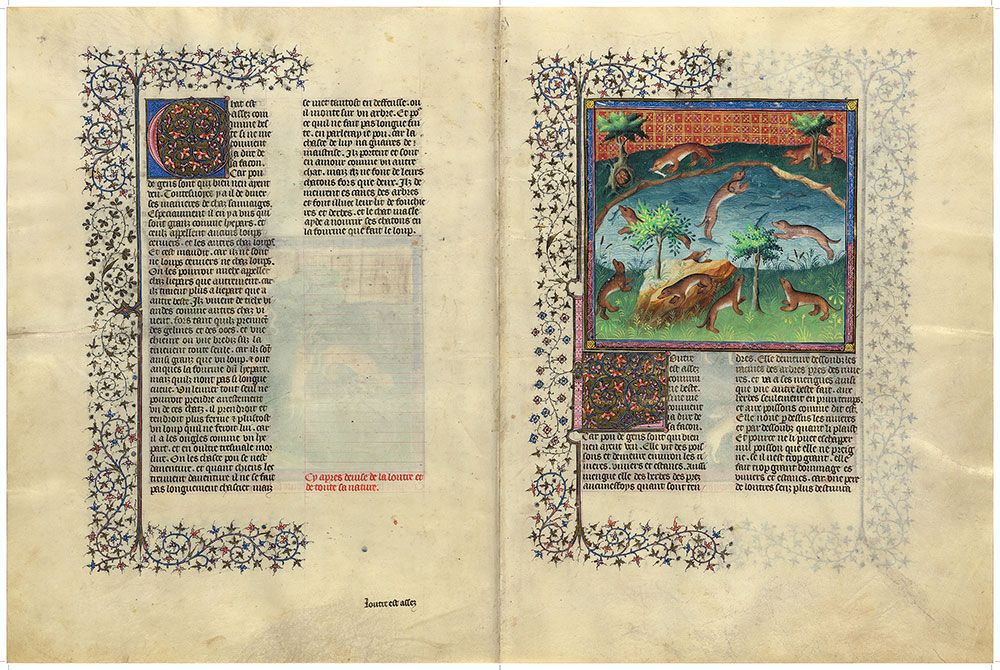
Livre de la chasse
Bequest of Clara S. Peck, 1983
Image courtesy of Faksimile Verlag Luzern
MS M.1044, fols. 28v–29r
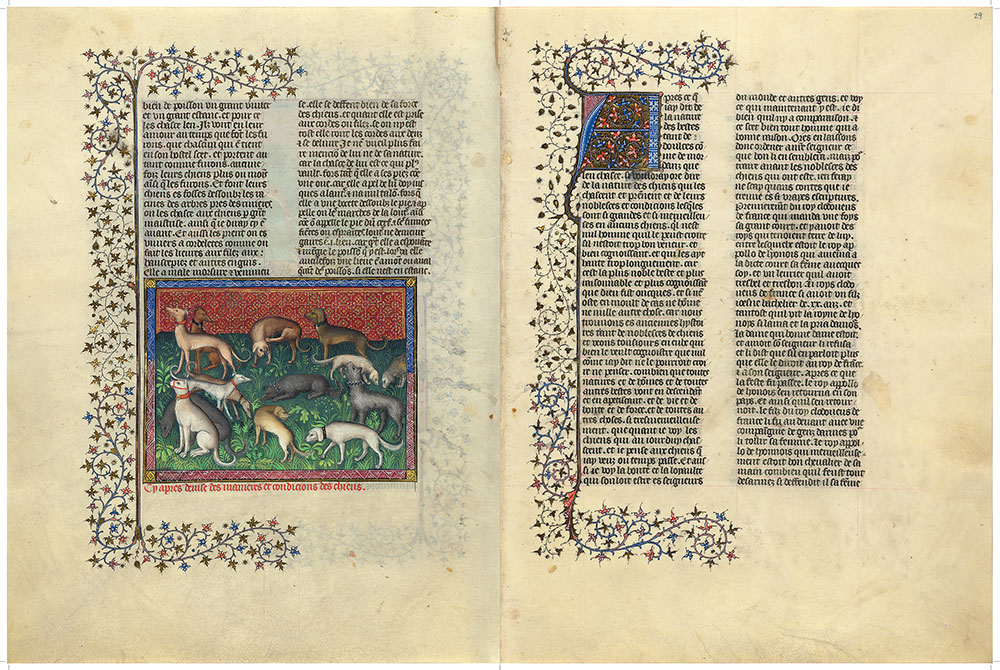
Livre de la chasse
Bequest of Clara S. Peck, 1983
Image courtesy of Faksimile Verlag Luzern
MS M.1044, fols. 29v–30r
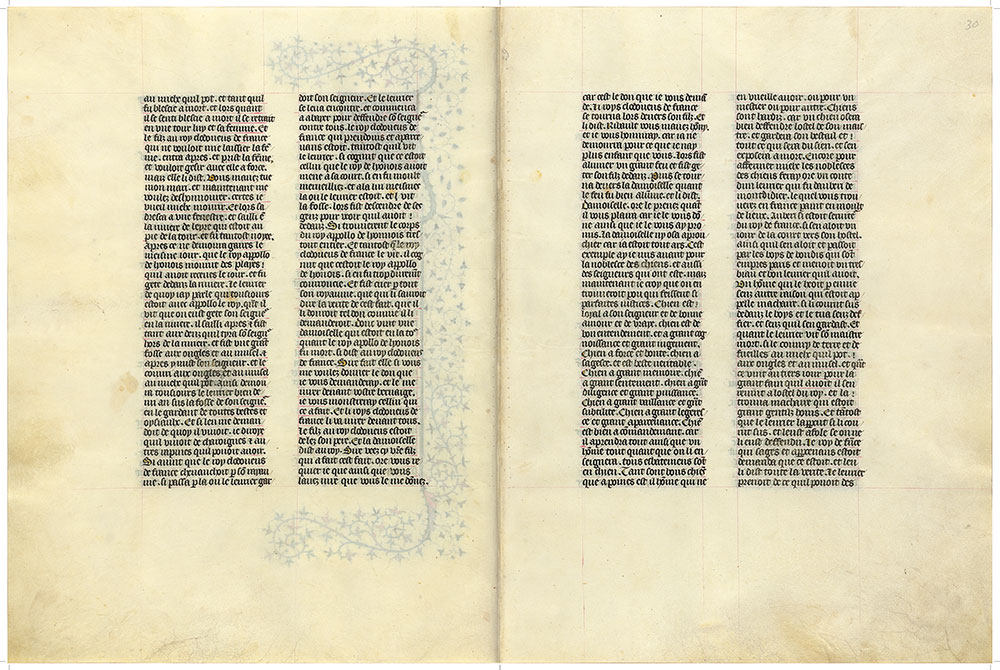
Livre de la chasse
Bequest of Clara S. Peck, 1983
Image courtesy of Faksimile Verlag Luzern
MS M.1044, fols. 30v–31r
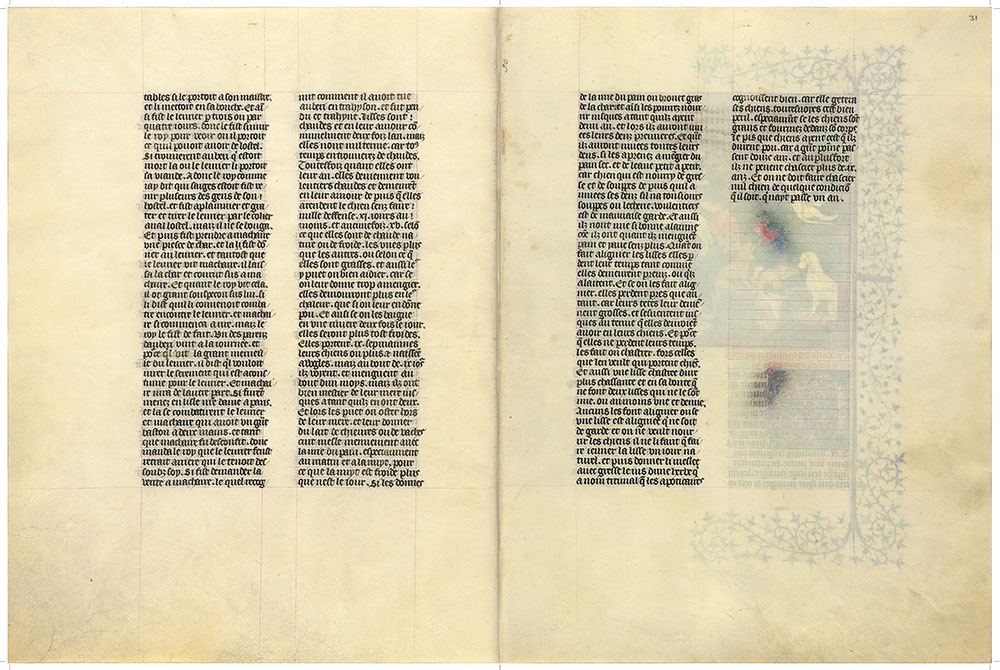
Livre de la chasse
Bequest of Clara S. Peck, 1983
Image courtesy of Faksimile Verlag Luzern
MS M.1044, fols. 31v–32r
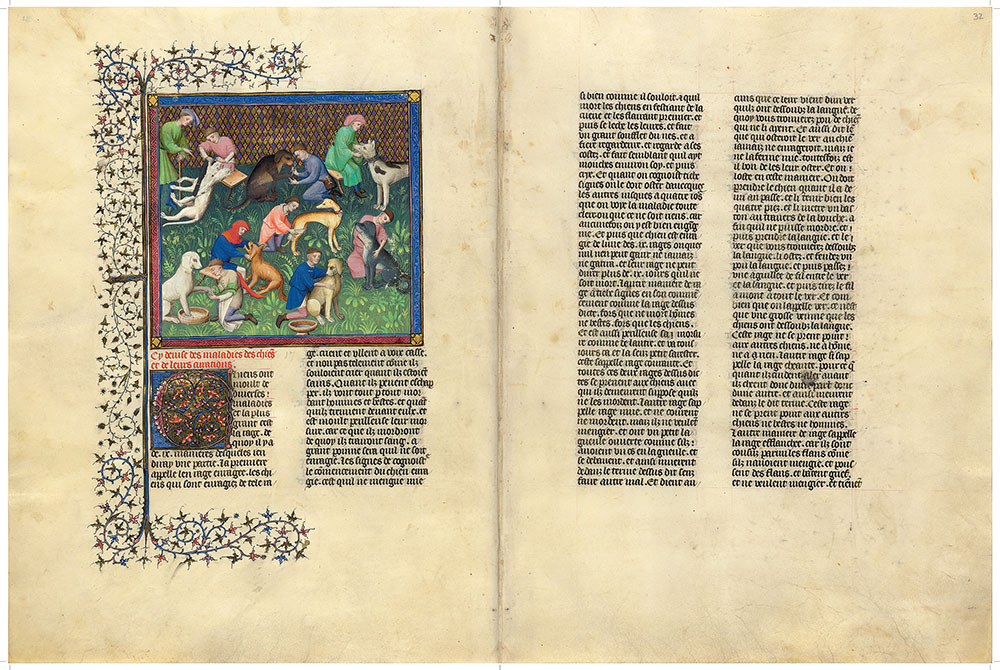
Livre de la chasse
Bequest of Clara S. Peck, 1983
Caring for Hounds
Healthy hounds were essential to the successful hunt, therefore Phoebus devoted a long chapter to their diseases and remedies. Dogs were susceptible to madness and a variety of rabies, all fatal. Men bitten by dogs had to be treated at once: they could wade into the sea and let waves roll over their head nine times, or they could set the vent of an old cock on the wound to extract the venom. If the cock died, the hound was mad!
In the miniature, dogs are cared for in various ways. At the top, a kennel man examines a dog's mouth, while others trim a paw or examine an eye. At the bottom, dogs receive a foot bath (to harden the balls of the feet), undergo an ear exam, have a leg set, are washed, and are then inspected to make certain that they are free of thorns and parasites.
Image courtesy of Faksimile Verlag Luzern
MS M.1044, fols. 32v–33r
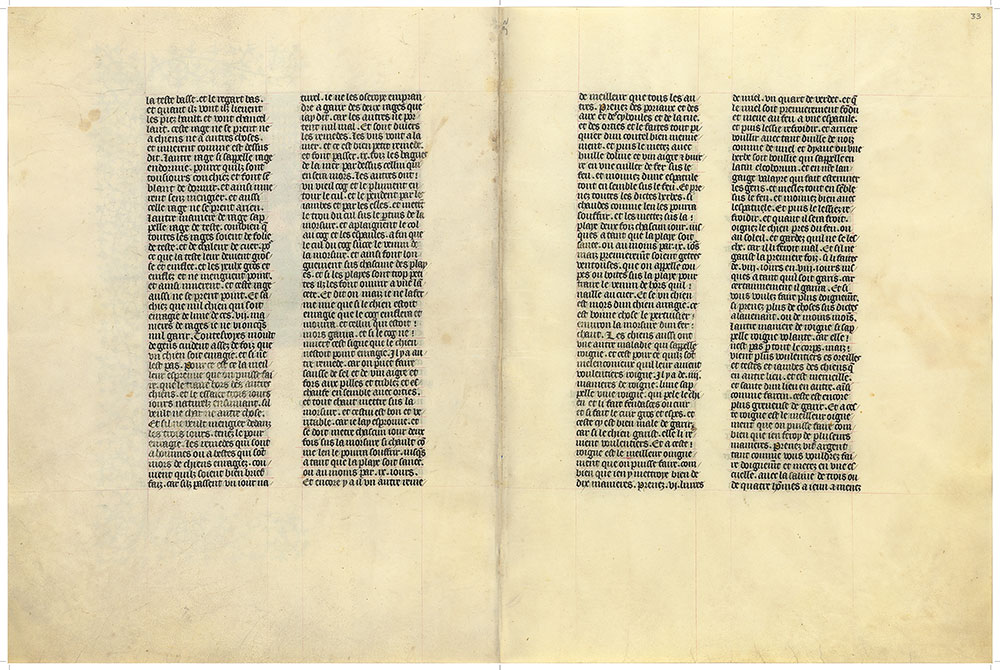
Livre de la chasse
Bequest of Clara S. Peck, 1983
Image courtesy of Faksimile Verlag Luzern
MS M.1044, fols. 33v–34r
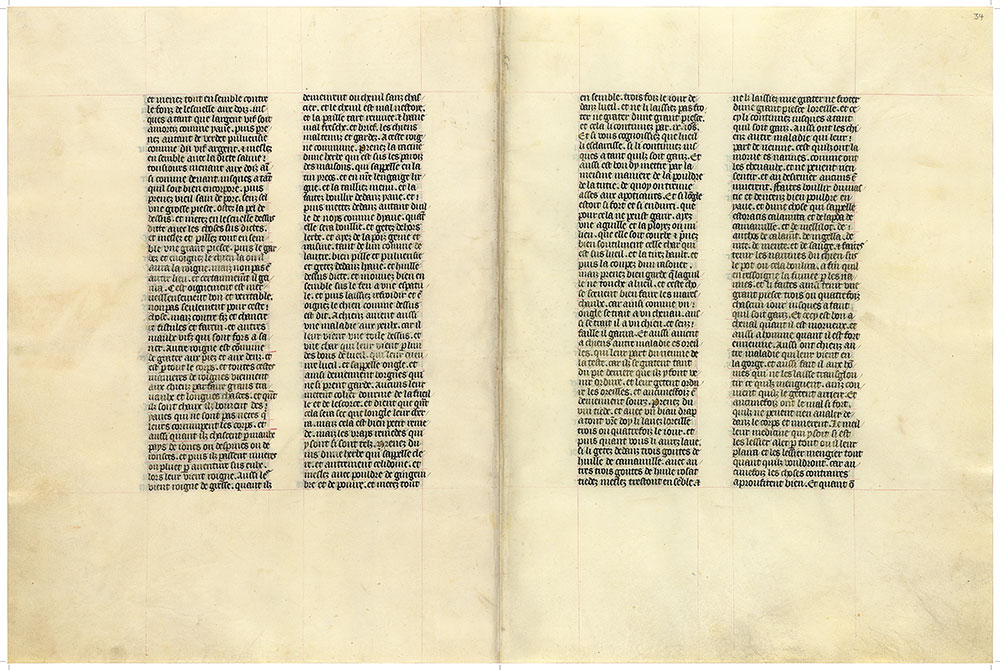
Livre de la chasse
Bequest of Clara S. Peck, 1983
Image courtesy of Faksimile Verlag Luzern
MS M.1044, fols. 34v–35r
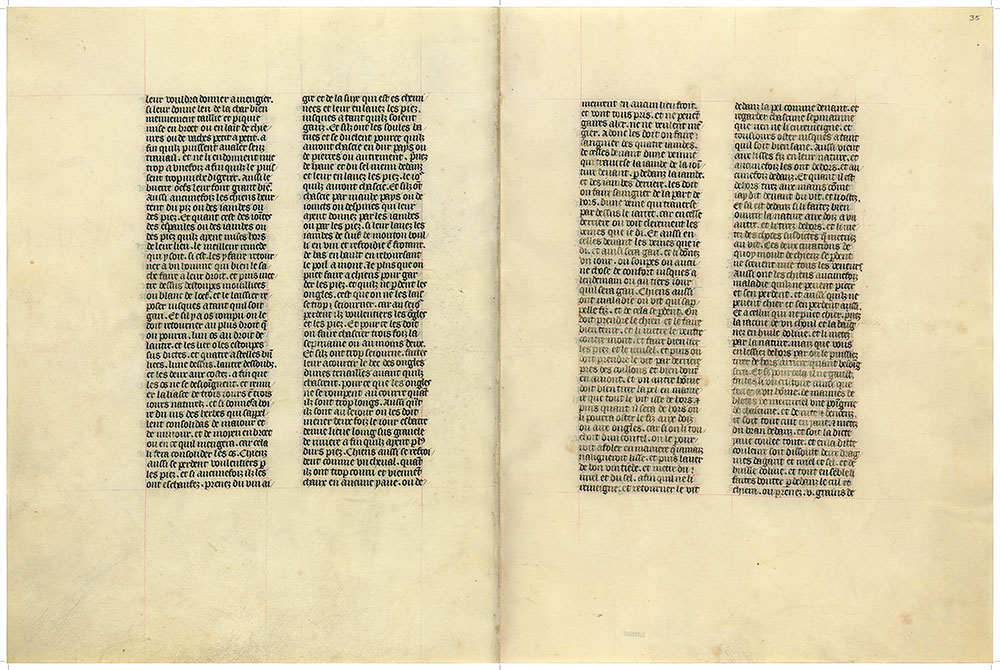
Livre de la chasse
Bequest of Clara S. Peck, 1983
Image courtesy of Faksimile Verlag Luzern
MS M.1044, fols. 35v–36r
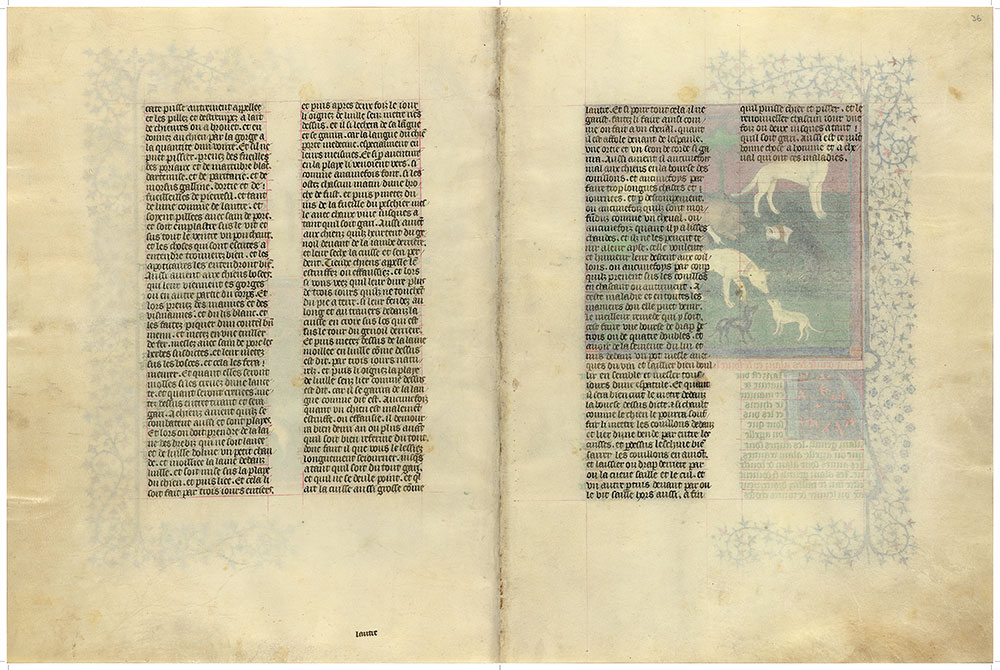
Livre de la chasse
Bequest of Clara S. Peck, 1983
Image courtesy of Faksimile Verlag Luzern
MS M.1044, fols. 36v–37r
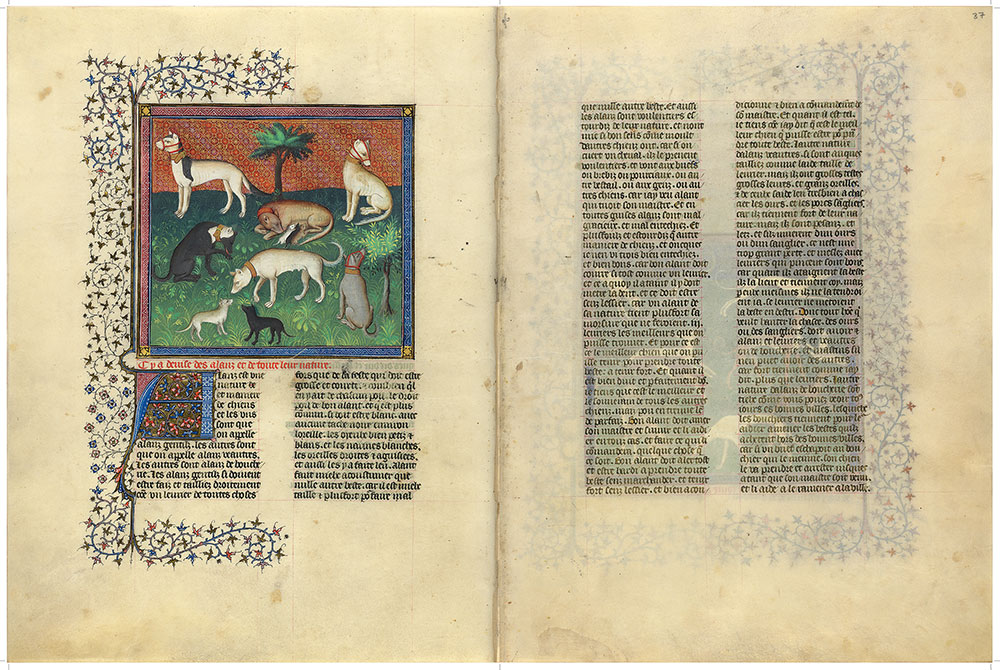
Livre de la chasse
Bequest of Clara S. Peck, 1983
Image courtesy of Faksimile Verlag Luzern
MS M.1044, fols. 37v–38r
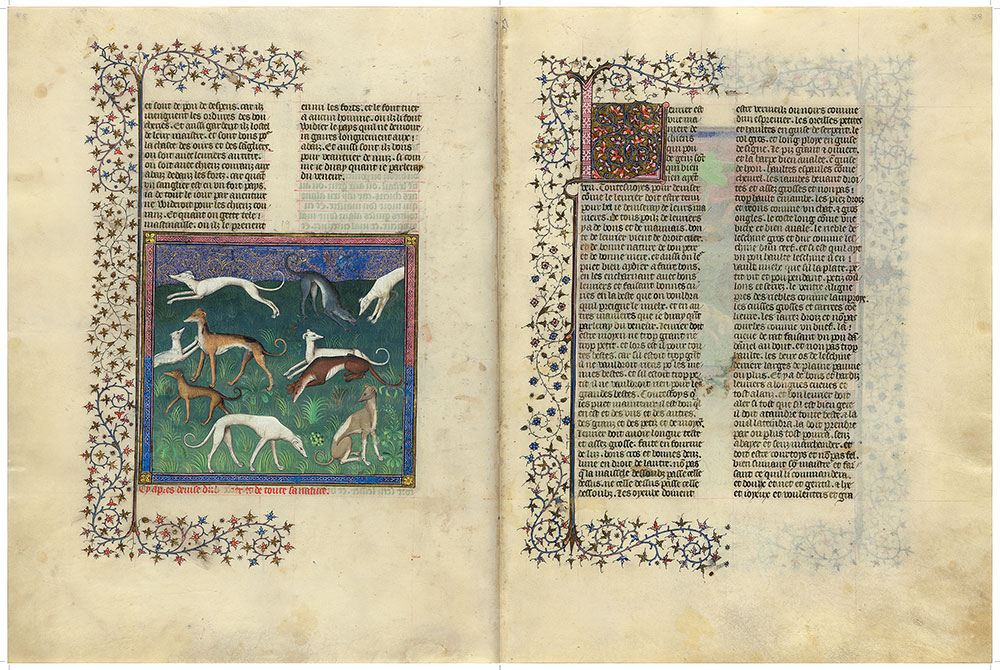
Livre de la chasse
Bequest of Clara S. Peck, 1983
Image courtesy of Faksimile Verlag Luzern
MS M.1044, fols. 38v–39r
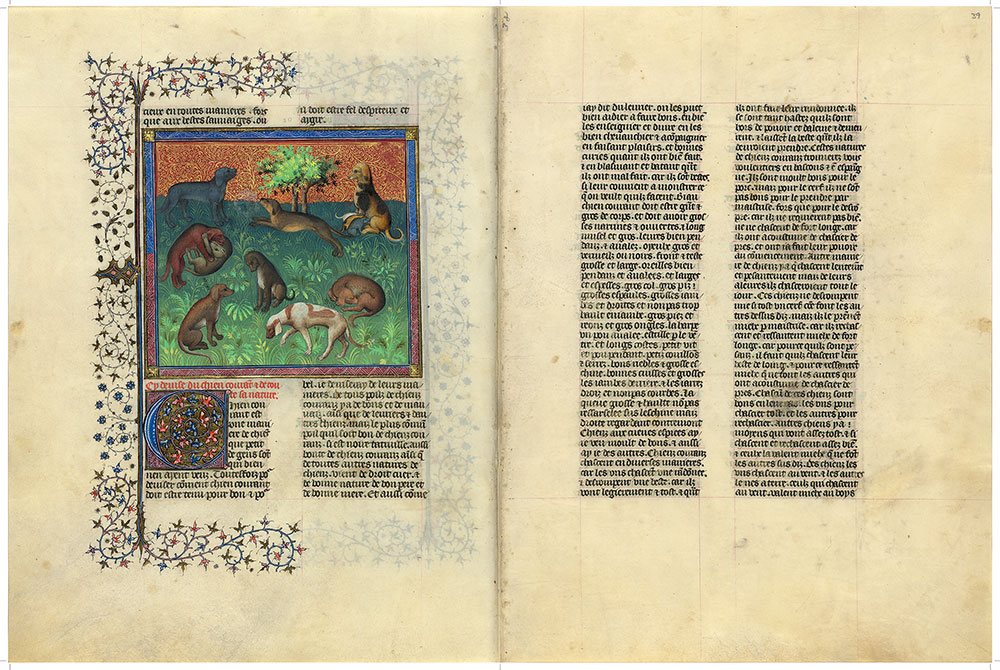
Livre de la chasse
Bequest of Clara S. Peck, 1983
Running Hounds
Because the running hound (chien courant) had unique qualities, Phoebus ranked it highest. These hounds would run in packs and follow game by scent and at a distance, unlike greyhounds, which would follow by sight. (Pointers and setters did the same.) There were several kinds of running hounds. Some would bark and chase prey until the kill; others would remain silent unless the hart had changed direction and they were again on scent. Here they stand, sit, sniff, fight, leap, and suckle three young. The beagle, which did not exist during the medieval era, was the result of cross-breeding the larger dogs pictured here.
Image courtesy of Faksimile Verlag Luzern
MS M.1044, fols. 39v–40r
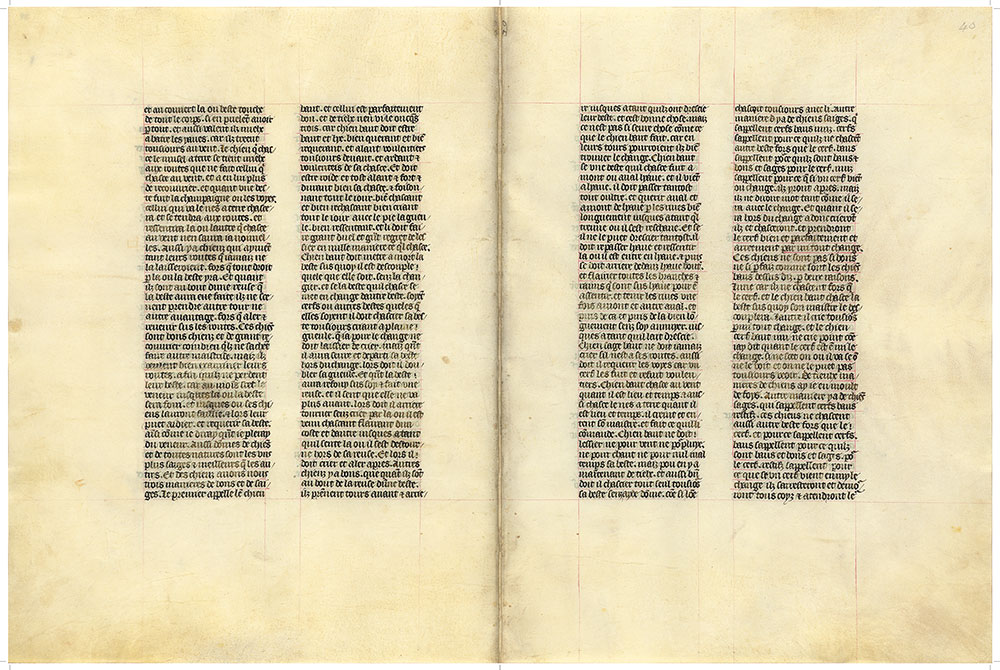
Livre de la chasse
Bequest of Clara S. Peck, 1983
Image courtesy of Faksimile Verlag Luzern
MS M.1044, fols. 40v–41r
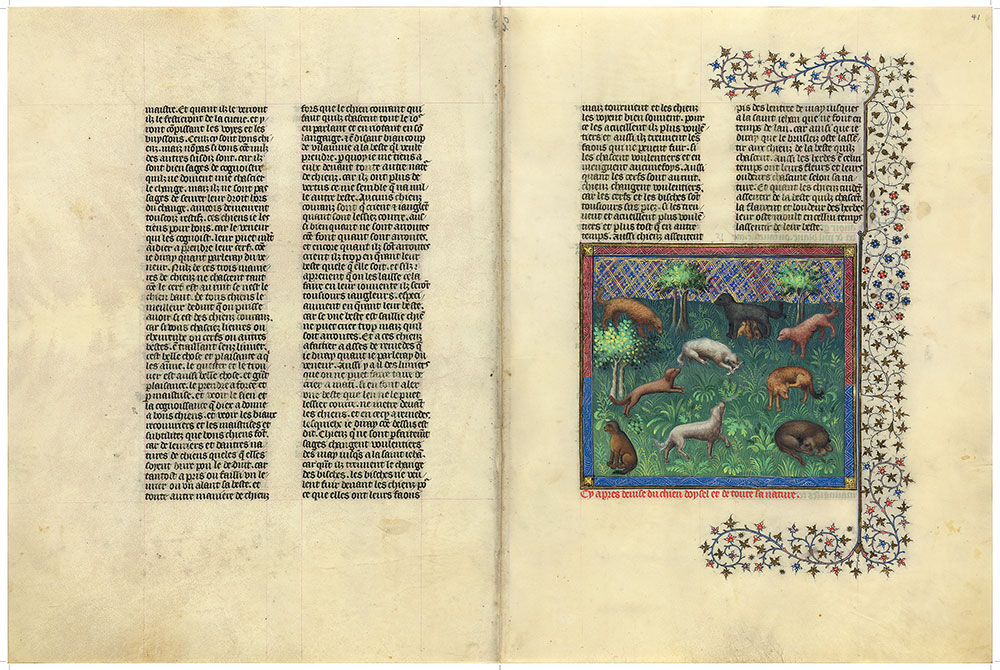
Livre de la chasse
Bequest of Clara S. Peck, 1983
Image courtesy of Faksimile Verlag Luzern
MS M.1044, fols. 41v–42r
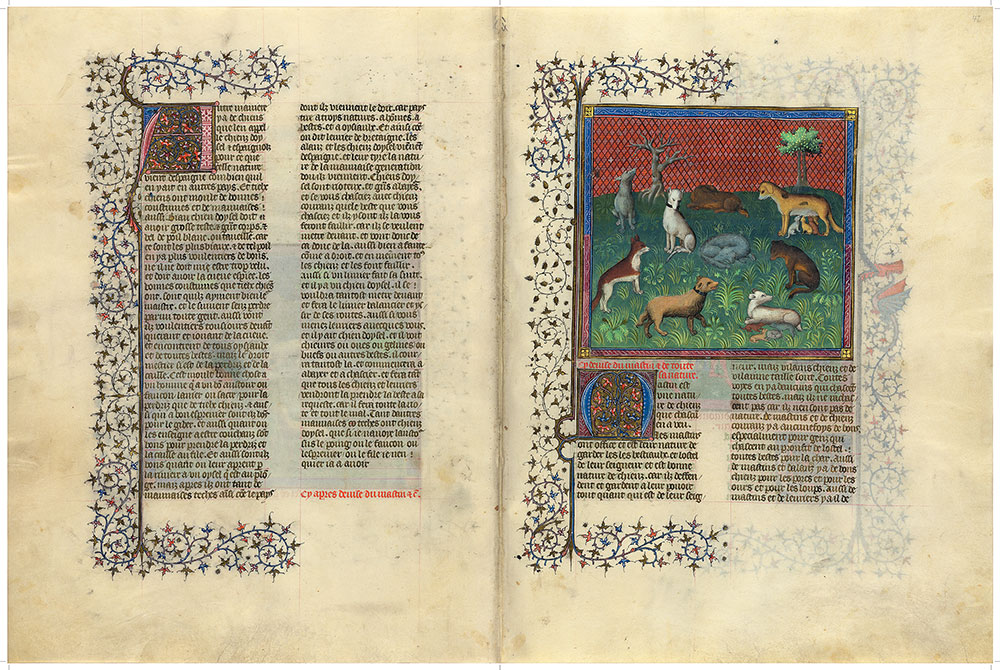
Livre de la chasse
Bequest of Clara S. Peck, 1983
Spaniels
Phoebus referred to these dogs as bird-dogs (chien d'oiseau) or spaniels (espaignolz), because the breed originated in Spain. They excelled in flushing out birds, especially partridge and quail, as well as other small game, such as rabbits. Killing a bird in flight with an arrow, however, was nearly impossible, so it was the falcon or the hawk that bagged the prey. Phoebus complained that spaniels lacked discipline, barked too much, and had so many other faults that he used them only when he had the goshawk, falcon, or sparrow hawk on his fist. Here spaniels walk, sit, recline, leap, scratch themselves, chew a bone, and suckle three young.
Image courtesy of Faksimile Verlag Luzern
MS M.1044, fols. 42v–43r
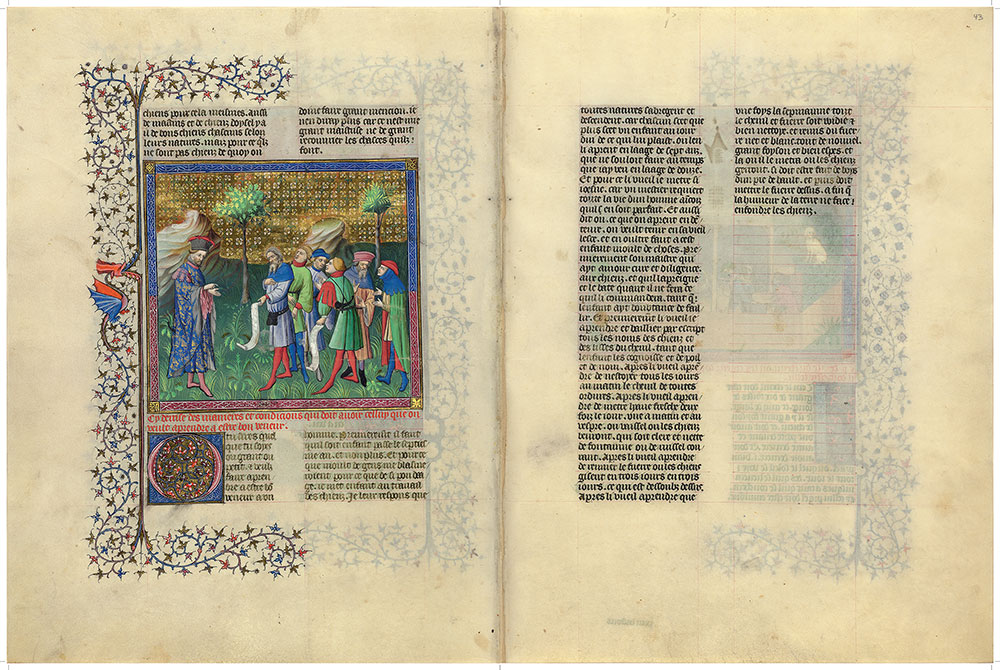
Livre de la chasse
Bequest of Clara S. Peck, 1983
The Training of a Huntsman
Phoebus recommended huntsmen begin training at the age of seven as a page of hounds as one was thought to retain more at that age than age twelve (the age at which his education commenced). He held that "what a man learns in his youth he will hold best in his old age." A good master–—one who loves and is knowledgeable about hounds–—was also considered crucial. The page was given a list of the names of the hounds, which he should also have been able to recognize by sight and hue. In the miniature, the master instructs a group of students, none of whom appear to be seven years of age. Two of them, including a bearded man, hold parchment scrolls containing the names of dogs they were to learn by heart.
Image courtesy of Faksimile Verlag Luzern
MS M.1044, fols. 43v–44r
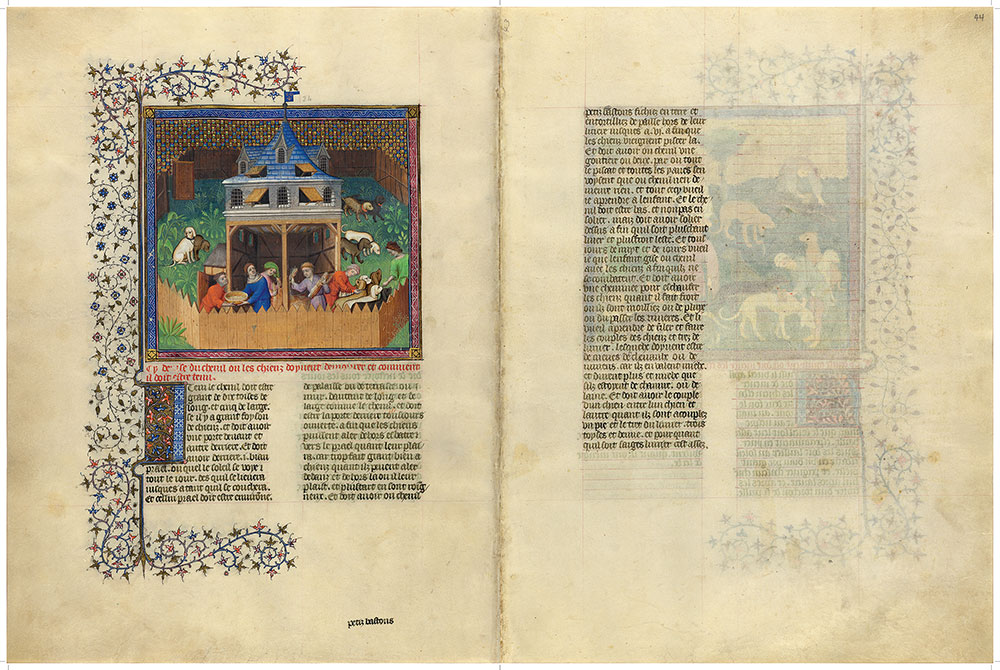
Livre de la chasse
Bequest of Clara S. Peck, 1983
The Kennel
The kennel should have been sufficiently large to accommodate several dogs and have two doors. The one at the front was used only for the hunt, while that at the back remained open, allowing the dogs to play and exercise in a small fenced meadow. It was the page's duty to clean the kennels every morning, to provide fresh water twice a day, and to change the straw bedding every three days. He also learned to make couples by leashing together two dog collars. The page was expected to sleep with the dogs to keep them from fighting. The loft above kept the kennel warm in the winter and cool during summer.
Image courtesy of Faksimile Verlag Luzern
MS M.1044, fols. 44v–45r
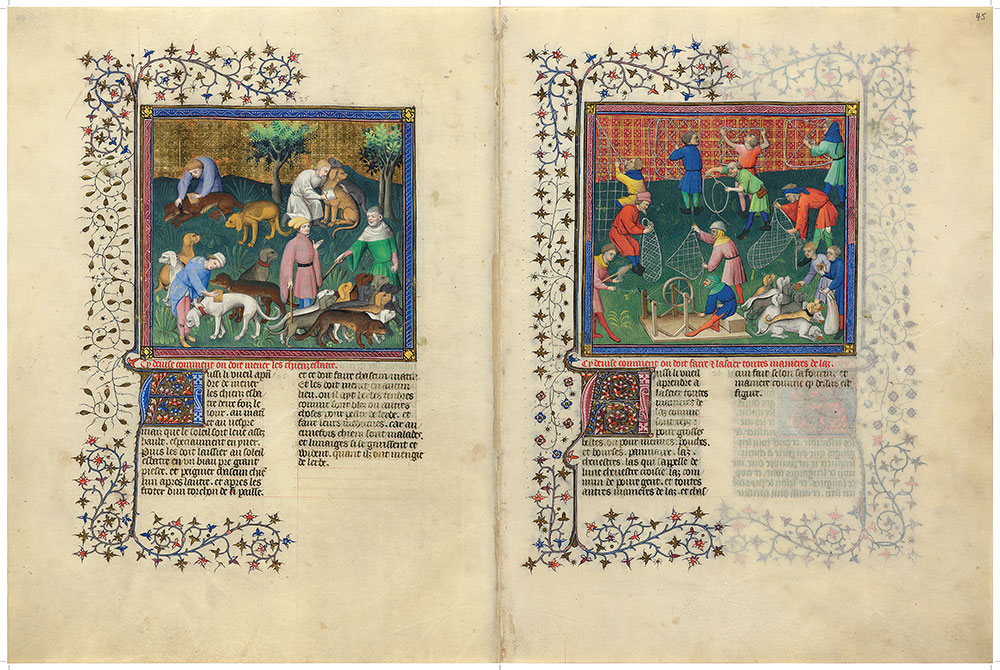
Livre de la chasse
Bequest of Clara S. Peck, 1983
Image courtesy of Faksimile Verlag Luzern
MS M.1044, fols. 45v–46r
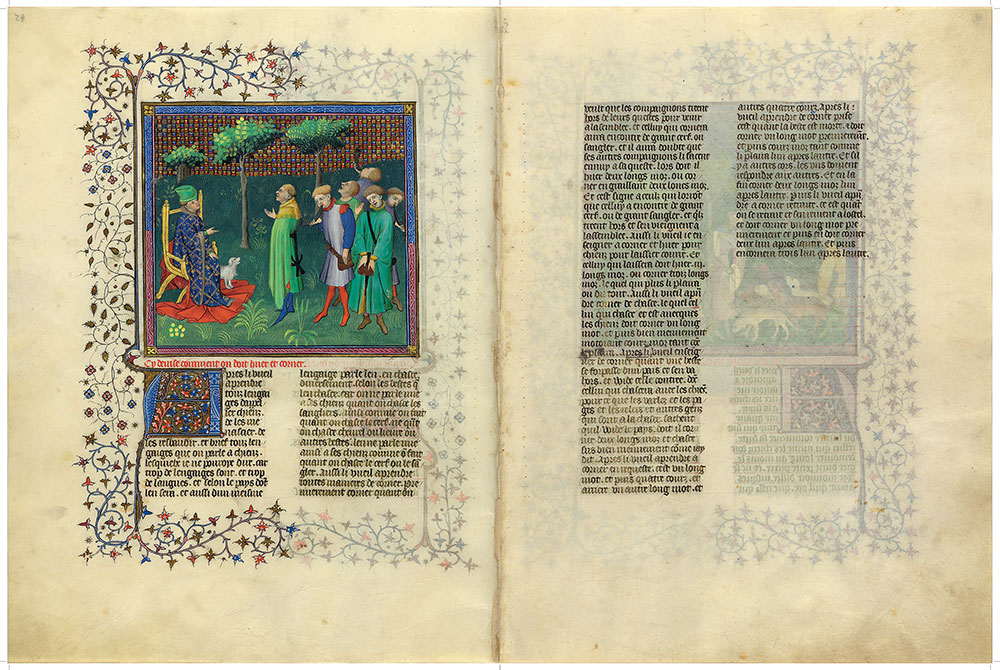
Livre de la chasse
Bequest of Clara S. Peck, 1983
Calling the Hounds
Phoebus advised the hunter to speak or call the hounds in many languages. It was also important to blow the horn in various ways, as communication over a distance was essential to a successful hunt. Here, before an elegantly robed Phoebus, three pages practice blowing horns while three others are whooping, or hollaing. Since the medieval hunting horn had only one moot (note), information was conveyed by long ones, short ones, and pauses. According to John I, king of Portugal (r. 1385–1433), the harmonies and melodies of Guillaume de Machaut were not as euphonious as the combined sounds of the hounds, the horns, and the hue and cry of the huntsmen.
Image courtesy of Faksimile Verlag Luzern
MS M.1044, fols. 46v–47r
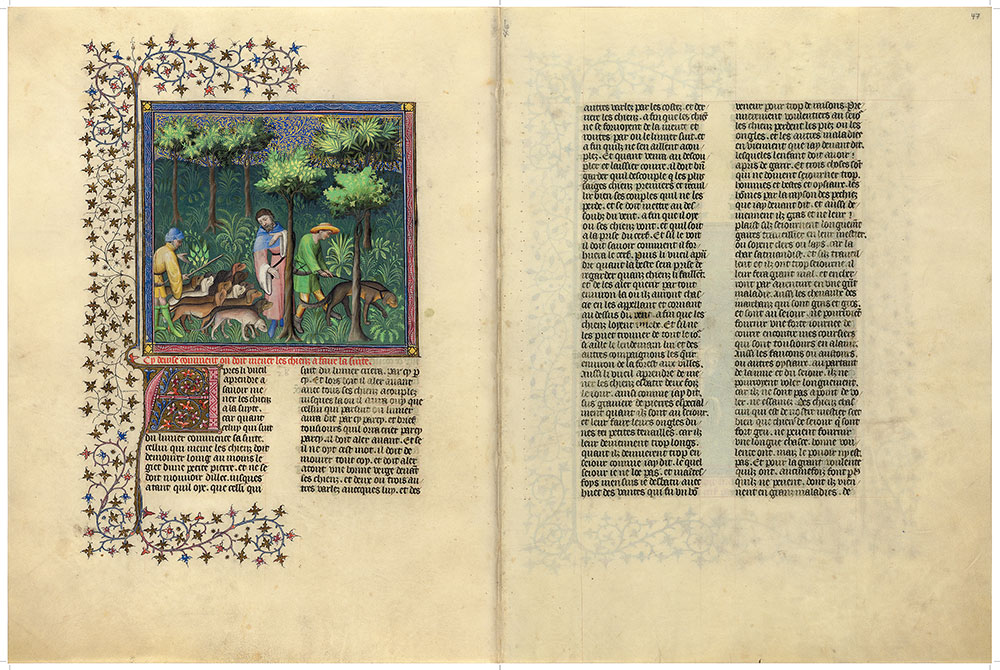
Livre de la chasse
Bequest of Clara S. Peck, 1983
Laying on the Hounds
Dogs, too, had to be trained for the hunt. This was done with the aid of a lymer, or "tracking dog," which has here located the scent of a stag left during the night. The master, in the middle, encourages the berner, who was in charge of the pack of hounds. It was his task to keep the pack together until the game was located. The berner would then let loose his best hounds in pursuit of the stag and uncouple the rest. Dogs were not allowed to go astray, and lazy ones were to be goaded with shouts and calls. The berner would follow the pack and maintain order until the hart was taken.
Image courtesy of Faksimile Verlag Luzern
MS M.1044, fols. 47v–48r
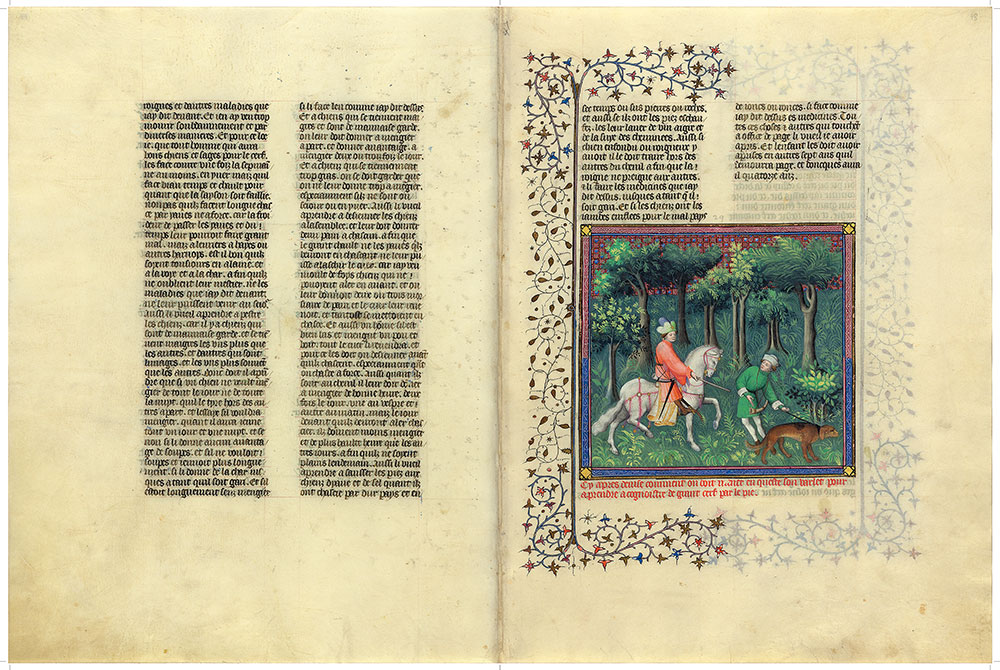
Livre de la chasse
Bequest of Clara S. Peck, 1983
Image courtesy of Faksimile Verlag Luzern
MS M.1044, fols. 48v–49r
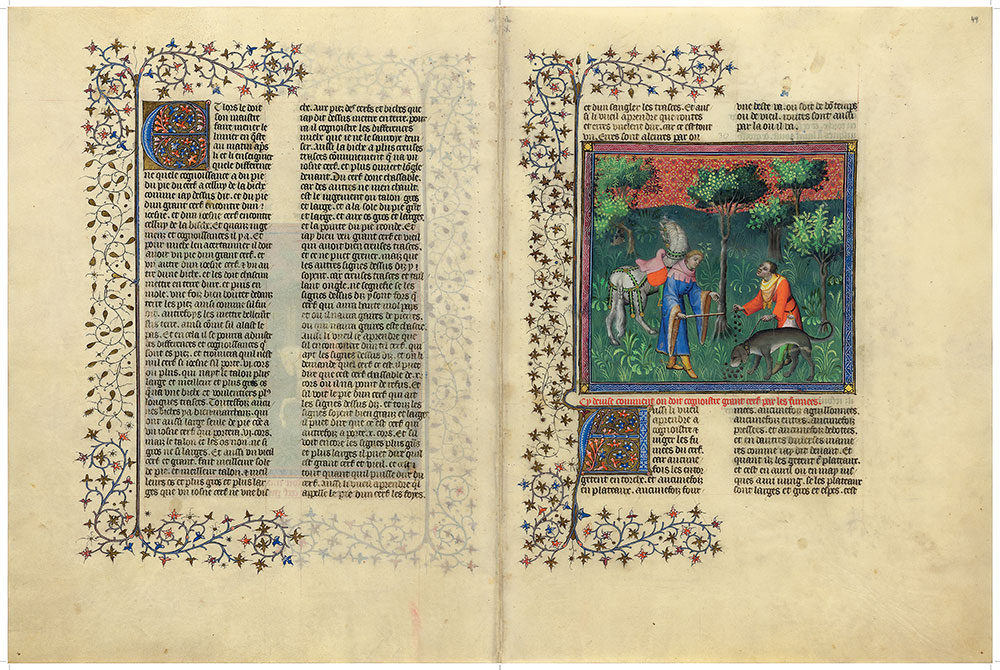
Livre de la chasse
Bequest of Clara S. Peck, 1983
Recognizing a Great Hart from His Droppings
In the previous chapter, Phoebus instructed the groom how to recognize the sex, age, and physical condition of a stag by its footprints. Here, he explained how to examine a hart's droppings to determine whether it was suitable prey. In the miniature, a harborer (locater), who has located a stag with the help of his lymer, shows his findings to his master.
Image courtesy of Faksimile Verlag Luzern
MS M.1044, fols. 49v–50r
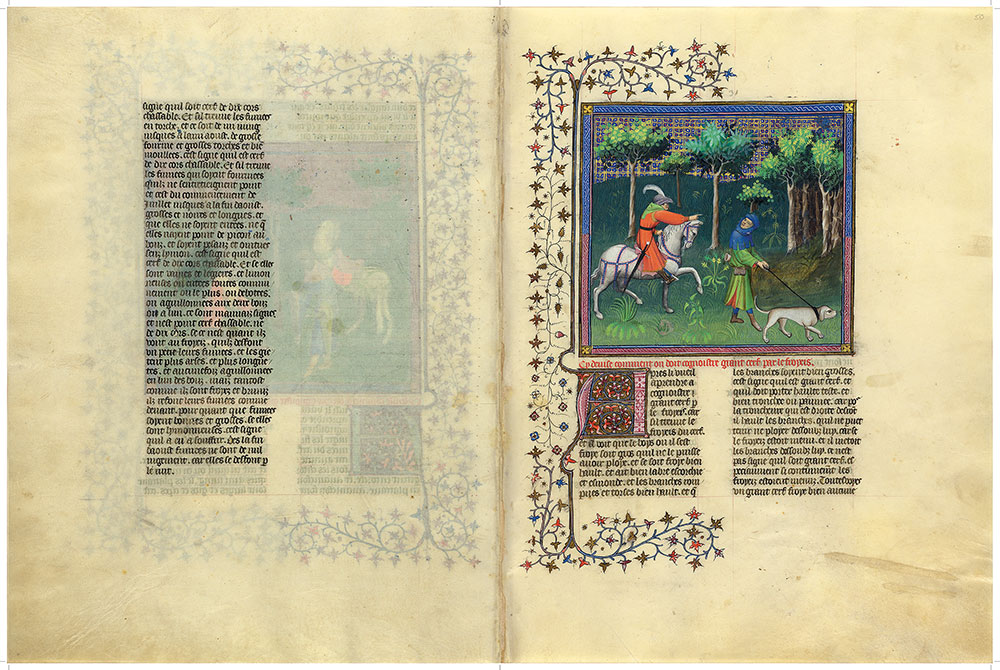
Livre de la chasse
Bequest of Clara S. Peck, 1983
Recognizing a Great Hart from the Fraying Post
About the middle of June, the horns of a great stag would be covered with a soft hair called velvet, under which the horns would grow hard and sharp, so that by Mary Magdalene's Day (July 22) they would fray their horns against trees, rubbing the velvet away and making their horns even harder and stronger. Thus, the height of the frayed bark, along with the twisted and broken branches, might have indicated the presence of a great and warrantable hart. Young stags, by contrast, did not fray against thick trees. In addition a great stag's lair would be long and wide and the grass therein much flatter than that of a young one.
Image courtesy of Faksimile Verlag Luzern
MS M.1044, fols. 50v–51r
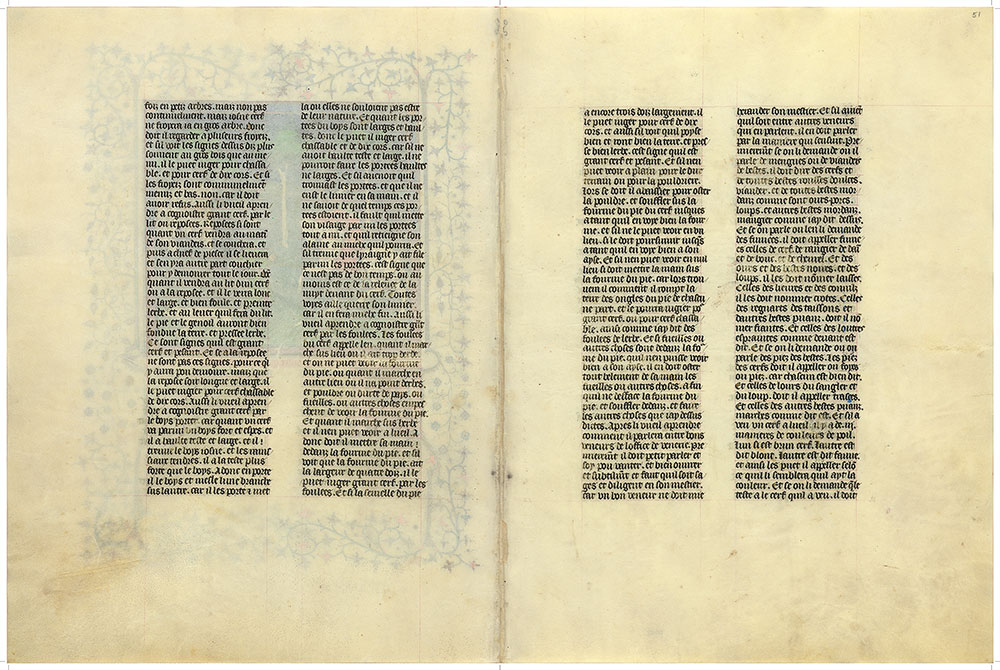
Livre de la chasse
Bequest of Clara S. Peck, 1983
Image courtesy of Faksimile Verlag Luzern
MS M.1044, fols. 51v–52r
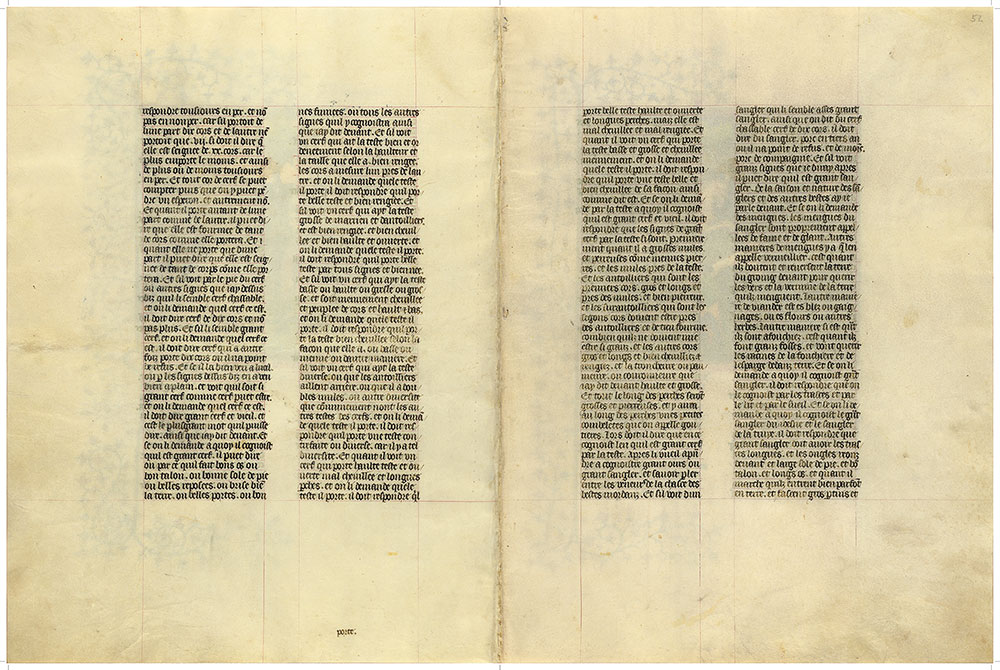
Livre de la chasse
Bequest of Clara S. Peck, 1983
Image courtesy of Faksimile Verlag Luzern
MS M.1044, fols. 52v–53r
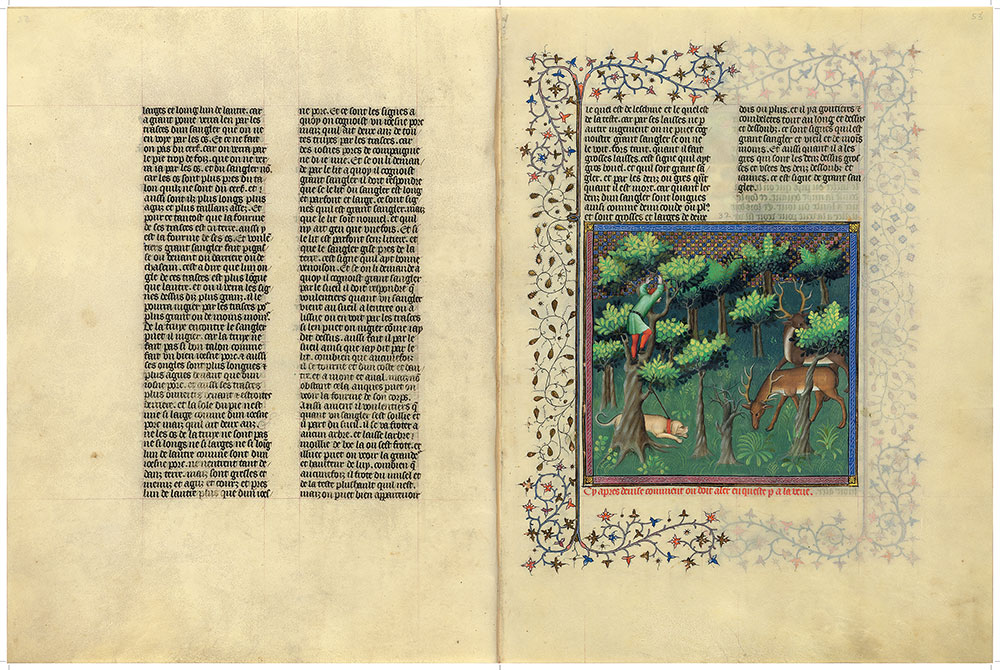
Livre de la chasse
Bequest of Clara S. Peck, 1983
Image courtesy of Faksimile Verlag Luzern
MS M.1044, fols. 53v–54r
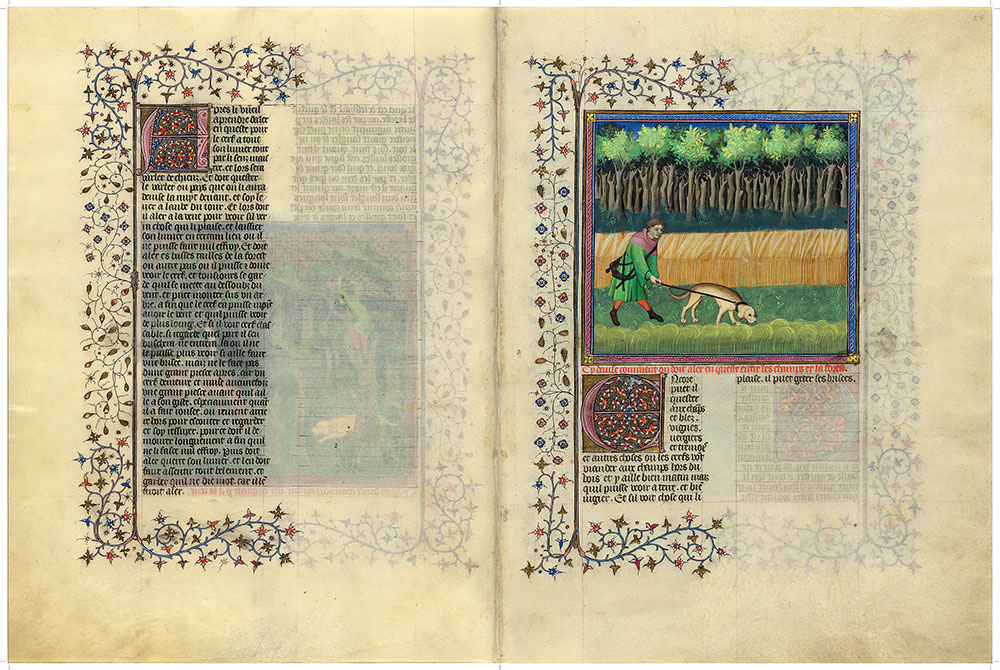
Livre de la chasse
Bequest of Clara S. Peck, 1983
Image courtesy of Faksimile Verlag Luzern
MS M.1044, fols. 54v–55r
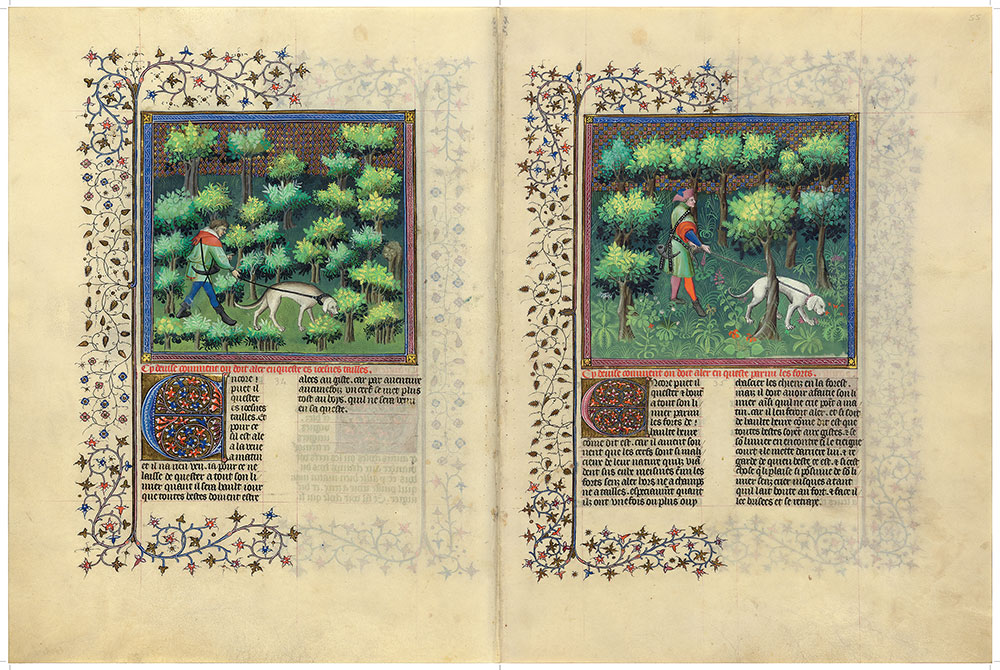
Livre de la chasse
Bequest of Clara S. Peck, 1983
Image courtesy of Faksimile Verlag Luzern
MS M.1044, fols. 55v–56r
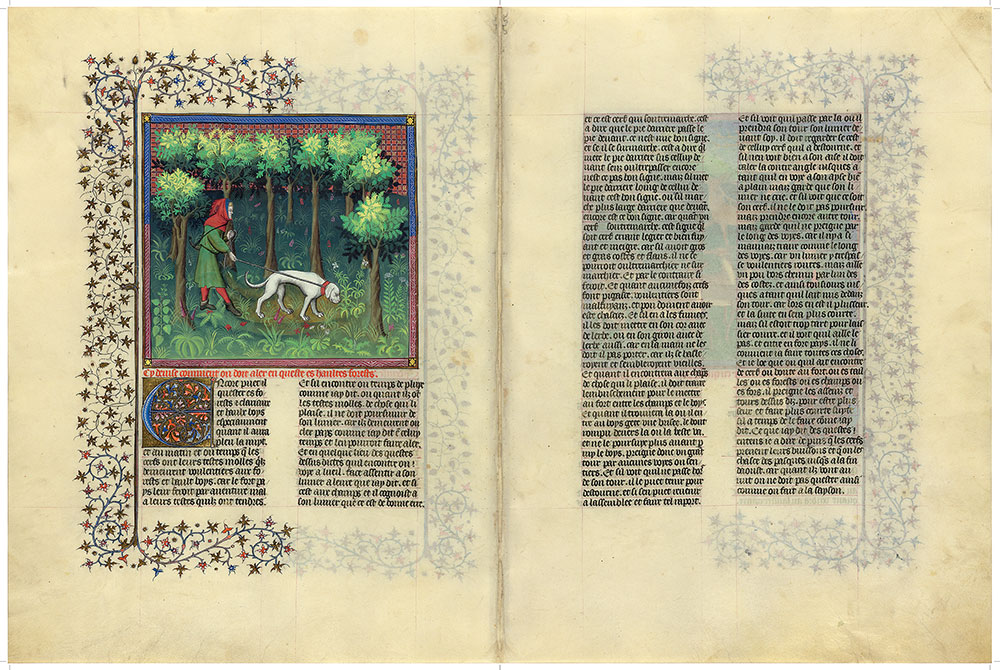
Livre de la chasse
Bequest of Clara S. Peck, 1983
Image courtesy of Faksimile Verlag Luzern
MS M.1044, fols. 56v–57r
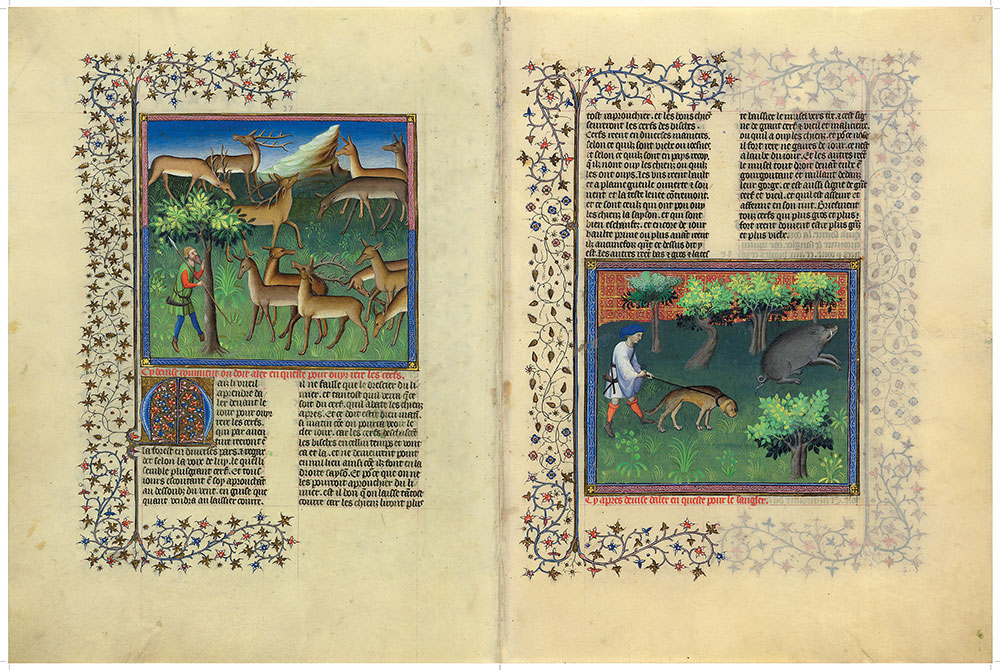
Livre de la chasse
Bequest of Clara S. Peck, 1983
Listening for the Hart's Bell
During the month of September when the male hart was in rut, its belling, or roaring, would permit a trained hunter to locate and judge it by ear alone. In the upper left of the miniature are two great old harts belling, extending their necks, and showing their teeth in order to attract the females opposite them. Their voices would have been deep and harsh, gurgly, or throaty. The bell of a young hart would be higher and less intense. Phoebus advised the hunter to listen for the hart at daybreak, illustrated here by the rays of light that have already reached the mountain peak on the horizon.
Image courtesy of Faksimile Verlag Luzern
MS M.1044, fols. 57v–58r
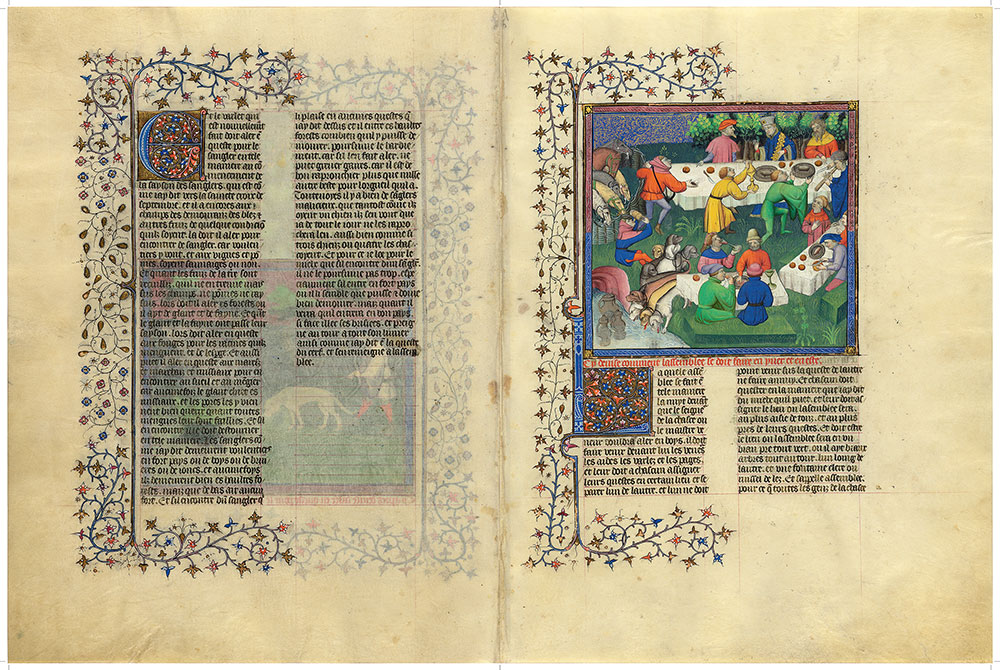
Livre de la chasse
Bequest of Clara S. Peck, 1983
Image courtesy of Faksimile Verlag Luzern
MS M.1044, fols. 58v–59r
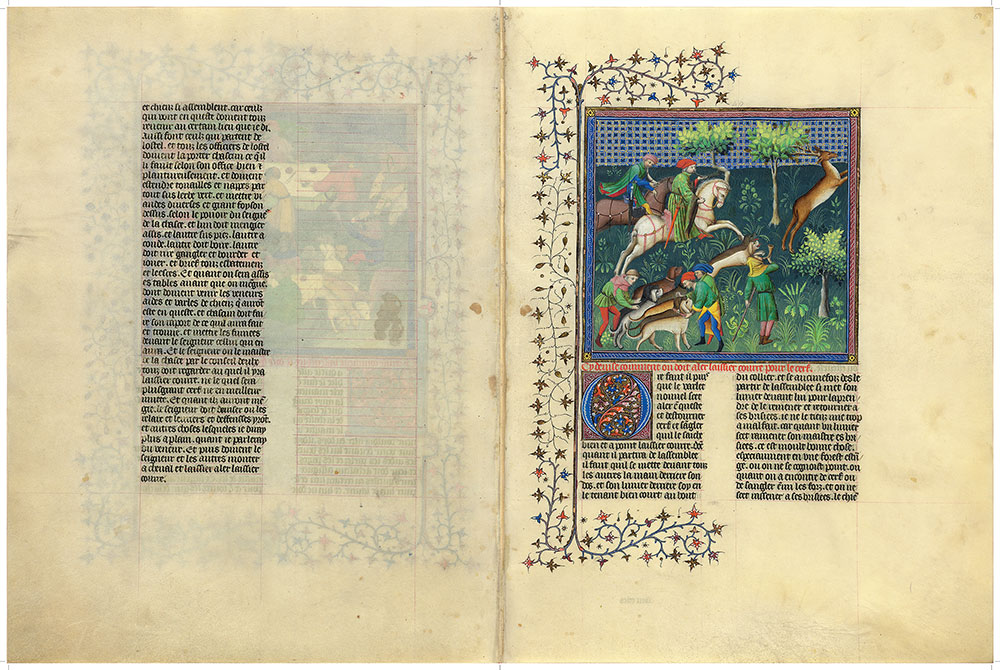
Livre de la chasse
Bequest of Clara S. Peck, 1983
The Gathering in Winter and Summer
The preparation for the gathering, or breakfast before the hunt, began the previous night, when the nobleman met with his hunters, grooms, and pages, assigning them areas to be quested for game at daybreak. After the quests, the participants would gather in a nearby shaded glade with a clear well or running brook. A hearty meal would then be enjoyed by all. In the miniature, the elegantly dressed nobleman, flanked by two huntsmen, is seated at a long table and served drink and food as a musician plays a pipe. Most important, however, is the lymerer approaching the table at the left, who has laid the droppings he has gathered in his horn on the table. One of the huntsmen points to them, determining which stag to pursue. The hounds are near a well, some drinking water, and the horses are ready, waiting for the hunt to begin.
Moving and Hunting the Hart
The lymerer, with his tracking dog, has already located and unharbored the hart. Here two hunters on horseback blow their horns and give chase. A hunter on foot, having already unleashed two hounds, also sounds his horn. Behind him three others prepare to add seven more hounds to the chase. Both of the mounted huntsmen wear swords. At the sound of the mort, one of them will use his sword to kill the exhausted stag.
Image courtesy of Faksimile Verlag Luzern
MS M.1044, fols. 59v–60r
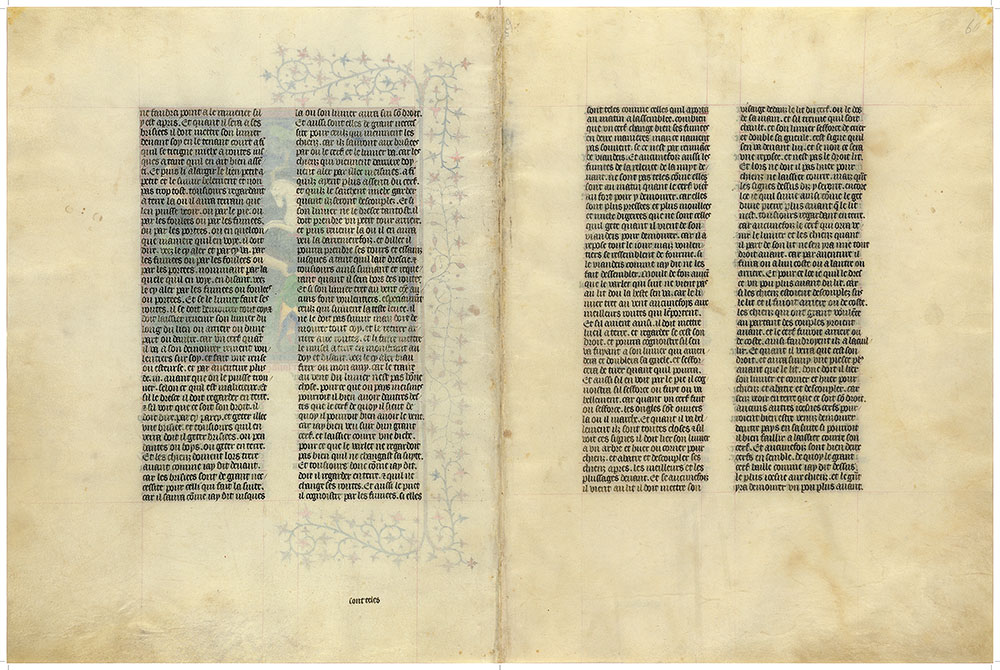
Livre de la chasse
Bequest of Clara S. Peck, 1983
Image courtesy of Faksimile Verlag Luzern
MS M.1044, fols. 60v–61r
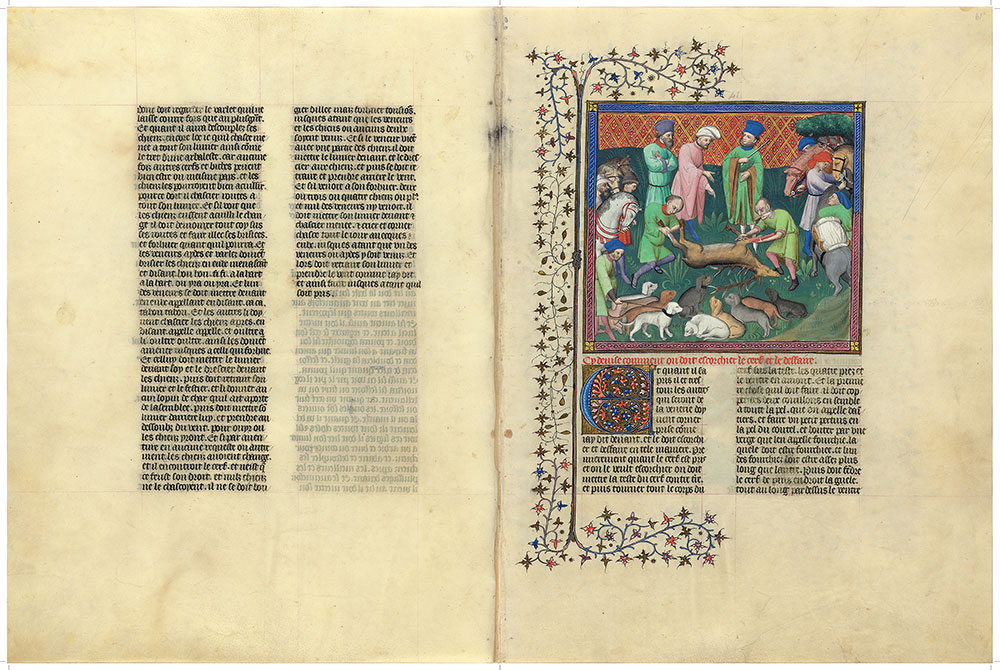
Livre de la chasse
Bequest of Clara S. Peck, 1983
Undoing and Breaking Up a Hart
After the mort was sounded, the ritualistic undoing (flaying) and breaking up (butchering) of the hart began. The animal was placed on its back, with its antlers facing the ground. The scrotum and testicles were removed, and the skin was cut from throat to vent and peeled down to the spine in order to provide a bed for the flayed carcass. According to Phoebus, this was done on the spot where the hart was killed rather than at the hunting lodge, permitting the dogs to be immediately rewarded. The severed head went to the lymer (fol. 72), who would be praised. With the master's "tallyho" the other hounds were given pieces of meat that had been thrown into the hart's blood, which had collected on the inside of his hide (fol. 72). The master further rewarded the dogs by letting them fight over the hart's guts.
Image courtesy of Faksimile Verlag Luzern
MS M.1044, fols. 61v–62r
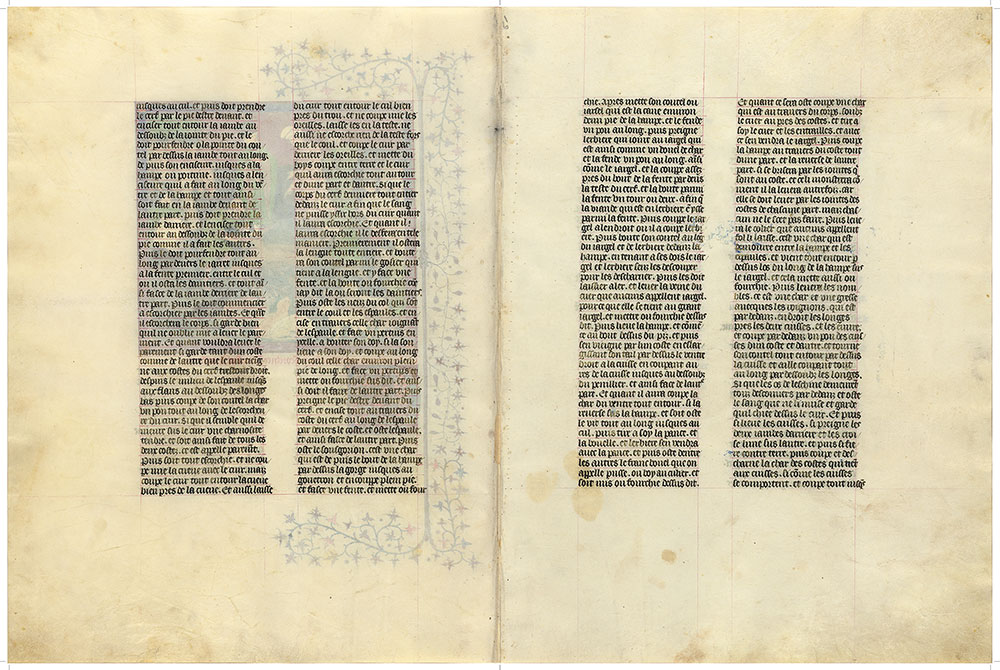
Livre de la chasse
Bequest of Clara S. Peck, 1983
Image courtesy of Faksimile Verlag Luzern
MS M.1044, fols. 62v–63r
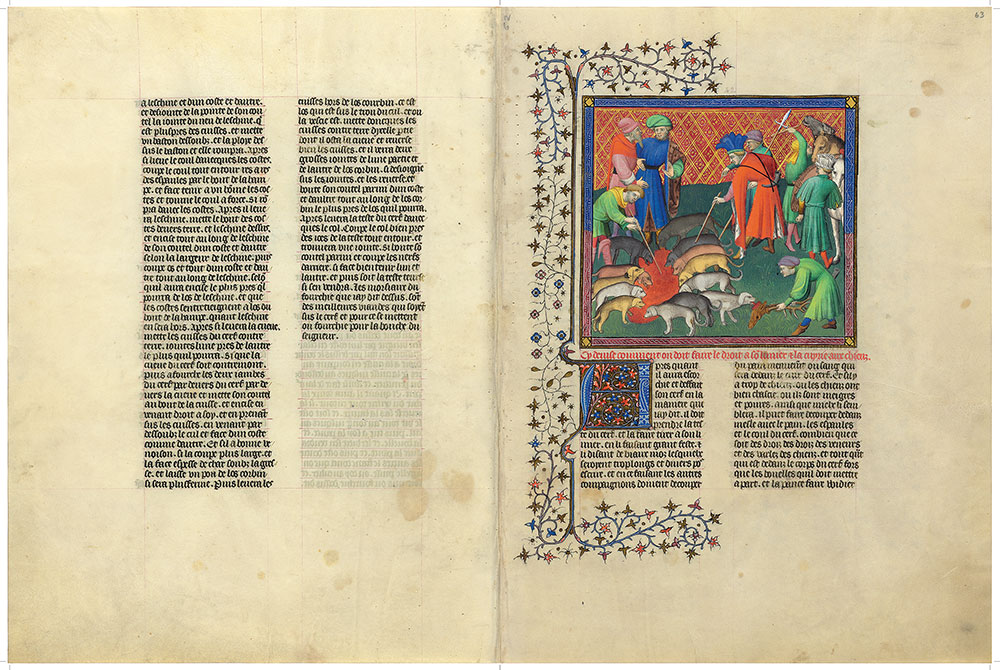
Livre de la chasse
Bequest of Clara S. Peck, 1983
Image courtesy of Faksimile Verlag Luzern
MS M.1044, fols. 63v–64r
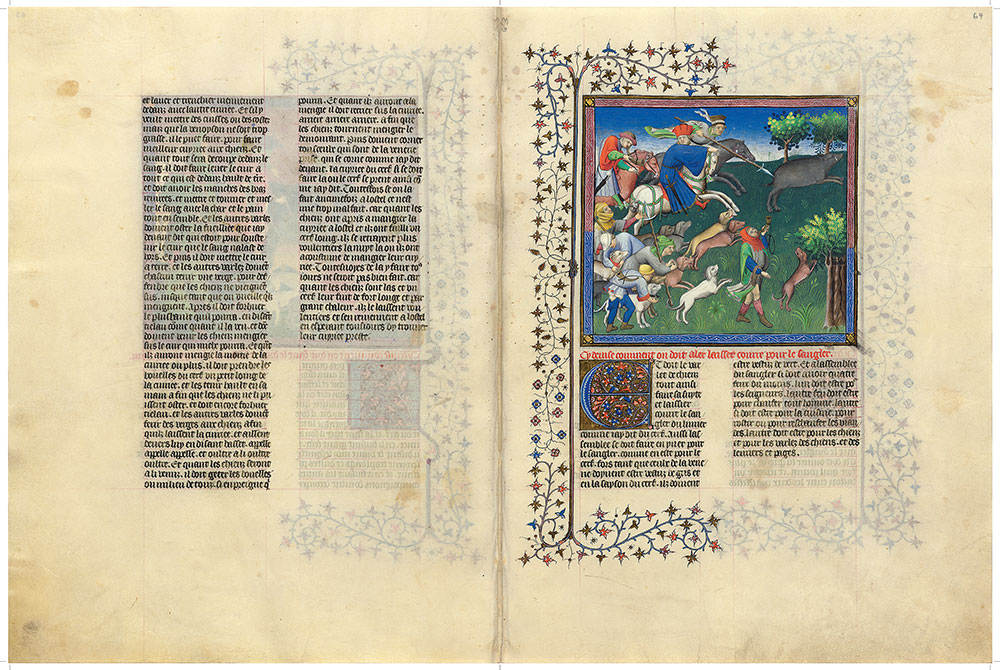
Livre de la chasse
Bequest of Clara S. Peck, 1983
Hunting the Wild Boar
The hunt of the wild boar was not much different from that of the stag. The same rules were followed, and the dogs and horses were used in the same way. Here the lymerer and his lymer have already moved (dislodged) the boar, and an elegantly dressed nobleman leads the charge. One of his huntsmen is about to spear the animal. The horns have been sounded and the grooms are about to release more hounds. Phoebus stated that, when hunting a boar in winter, gray, not green, was to be worn.
Image courtesy of Faksimile Verlag Luzern
MS M.1044, fols. 64v–65r
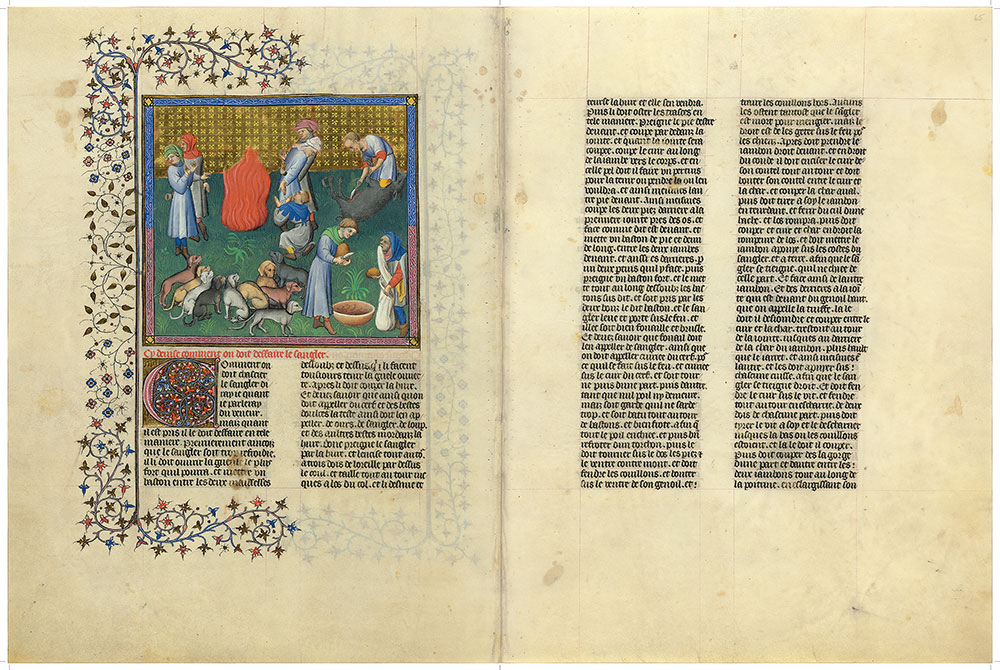
Livre de la chasse
Bequest of Clara S. Peck, 1983
Image courtesy of Faksimile Verlag Luzern
MS M.1044, fols. 65v–66r
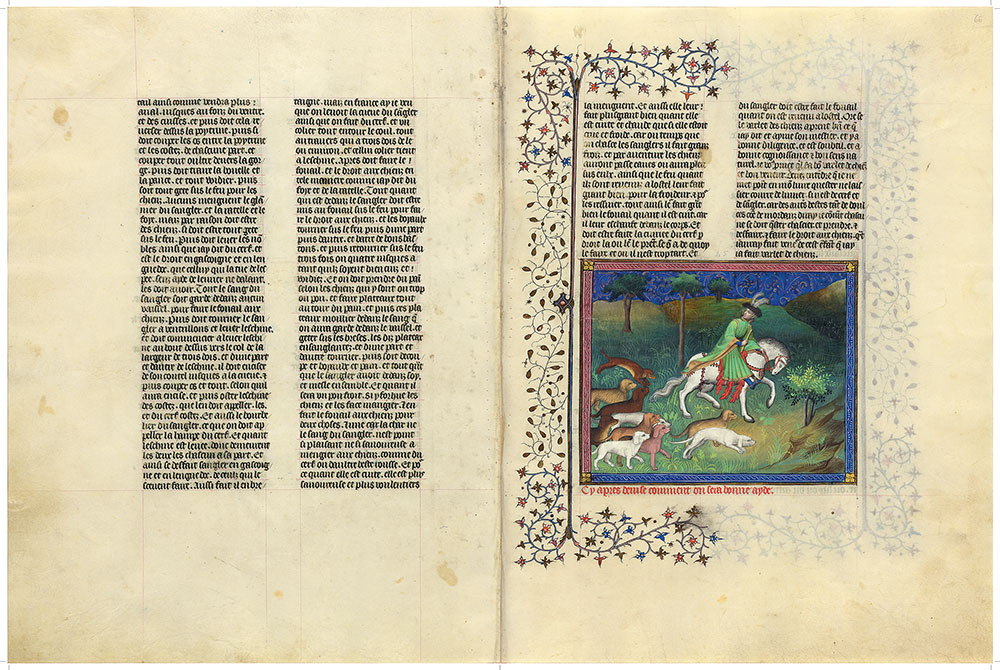
Livre de la chasse
Bequest of Clara S. Peck, 1983
Image courtesy of Faksimile Verlag Luzern
MS M.1044, fols. 66v–67r
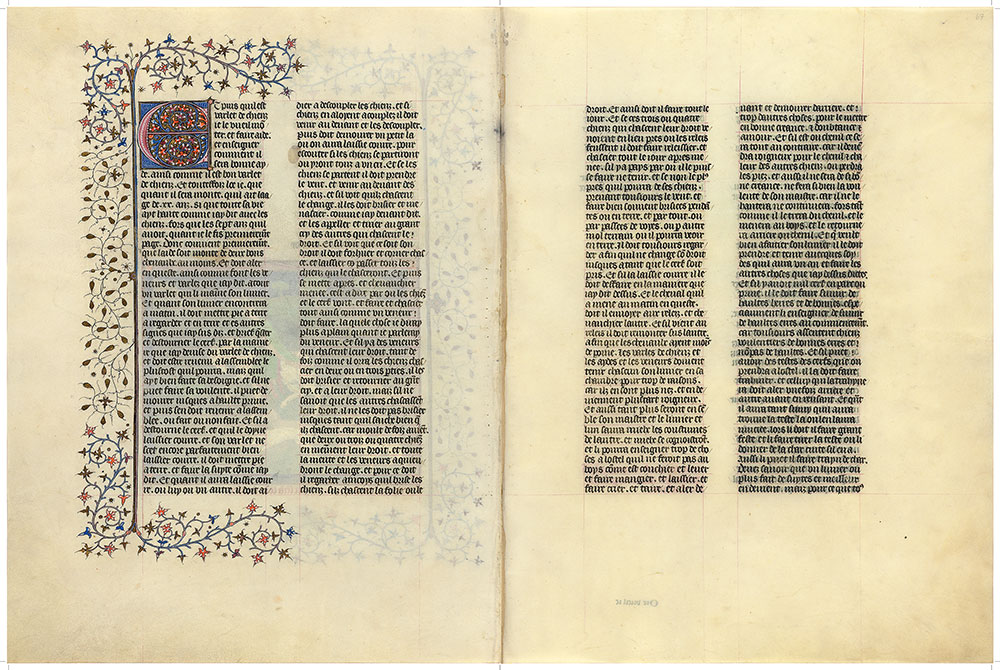
Livre de la chasse
Bequest of Clara S. Peck, 1983
Image courtesy of Faksimile Verlag Luzern
MS M.1044, fols. 67v–68r
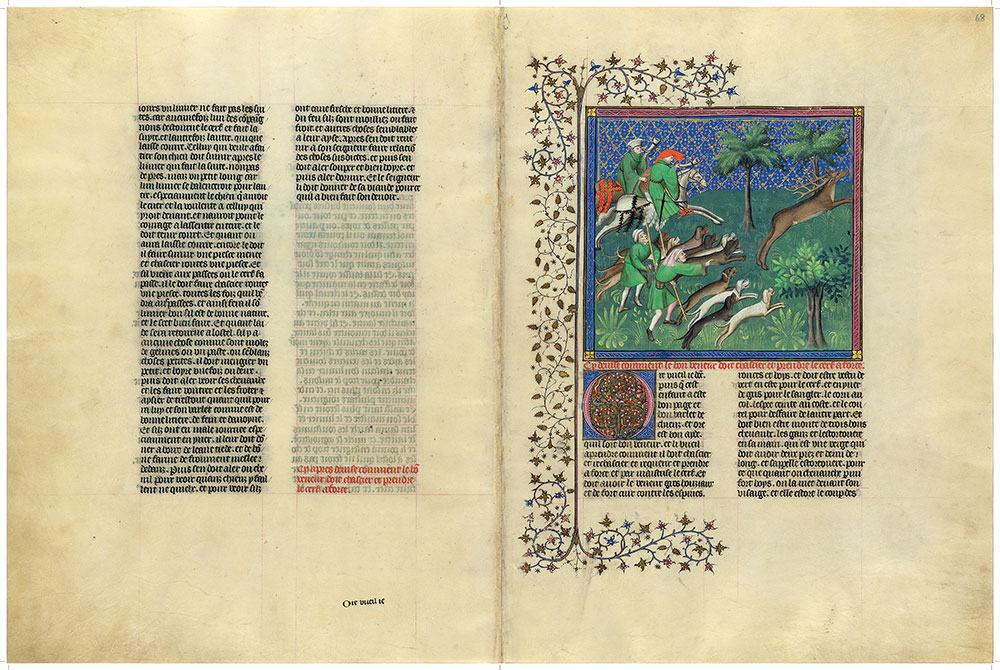
Livre de la chasse
Bequest of Clara S. Peck, 1983
Hunting and Taking the Hart
A page, after many years of working with hounds, became a true hunter at age twenty, by which time he had at least two horses. By then he would know how to follow the lymerer and to sound his horn or holla, signaling his fellow huntsmen to join the chase when the right hart had been identified. Here two well-dressed mounted huntsmen, blowing their horns, pursue a great stag that has already been dislodged. The dogs join the chase, helping to exhaust the stag. Were the hart's antlers to kill or wound a dog, he would immediately be killed with a sword or arrow. The hunters are dressed in green, as Phoebus specified for reasons of camouflage.
Image courtesy of Faksimile Verlag Luzern
MS M.1044, fols. 68v–69r
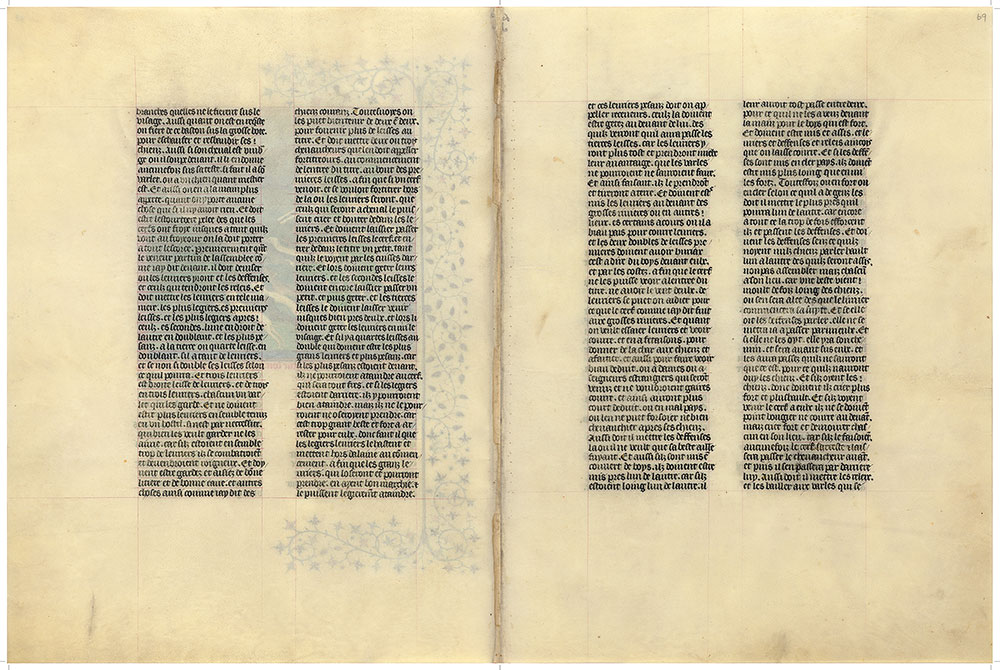
Livre de la chasse
Bequest of Clara S. Peck, 1983
Image courtesy of Faksimile Verlag Luzern
MS M.1044, fols. 69v–70r
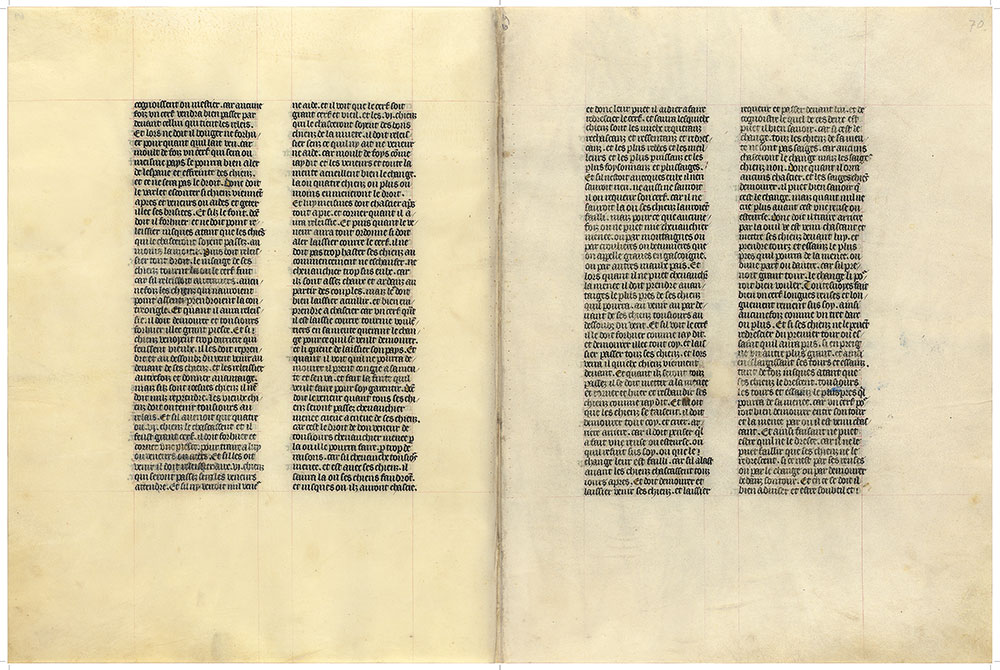
Livre de la chasse
Bequest of Clara S. Peck, 1983
Image courtesy of Faksimile Verlag Luzern
MS M.1044, fols. 70v–71r
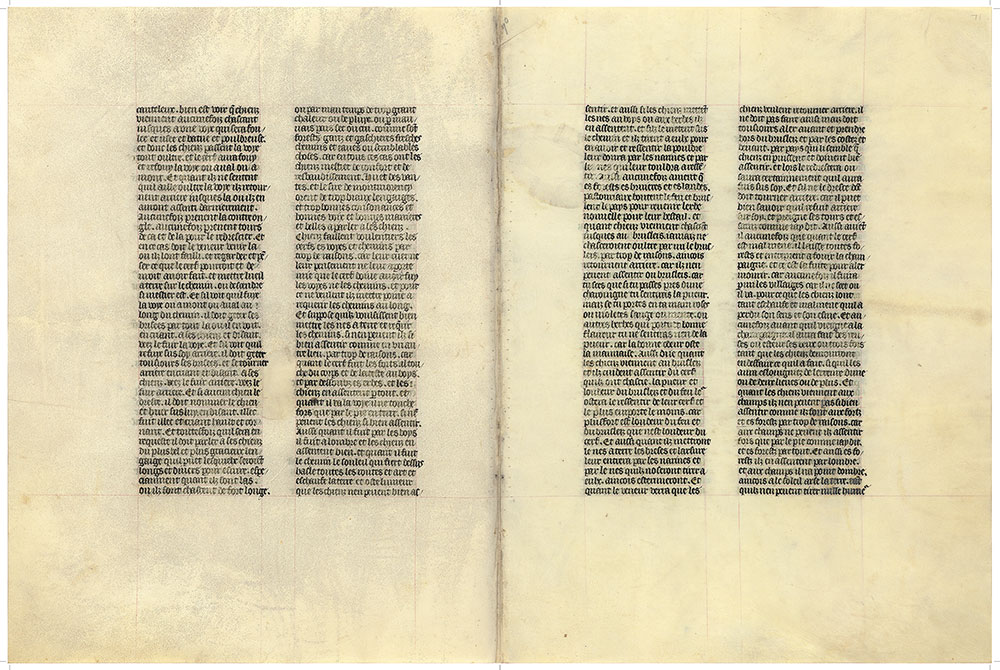
Livre de la chasse
Bequest of Clara S. Peck, 1983
Image courtesy of Faksimile Verlag Luzern
MS M.1044, fols. 71v–72r
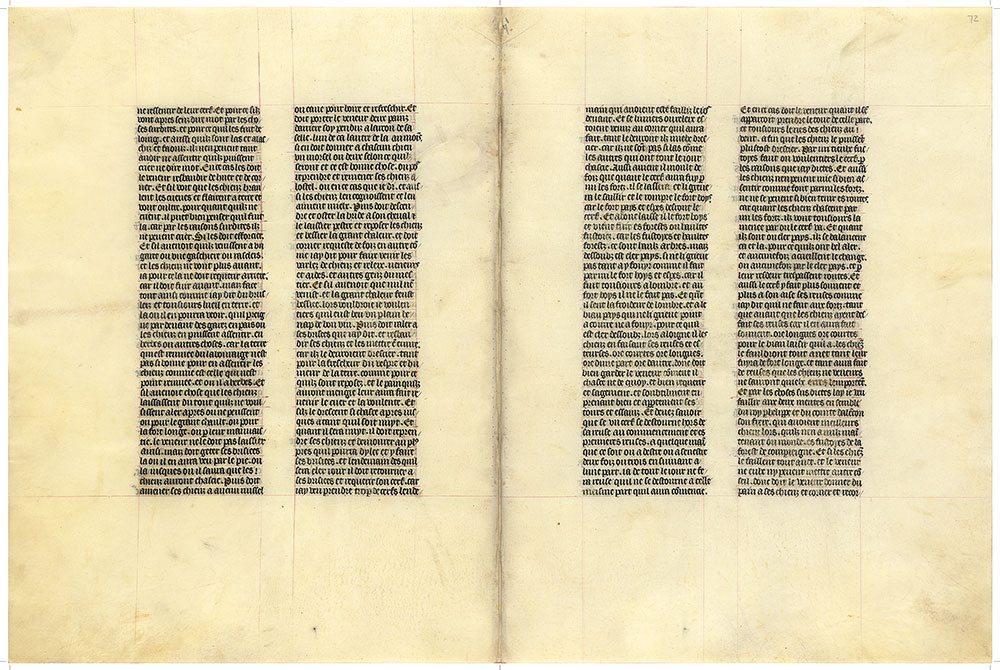
Livre de la chasse
Bequest of Clara S. Peck, 1983
Image courtesy of Faksimile Verlag Luzern
MS M.1044, fols. 72v–73r
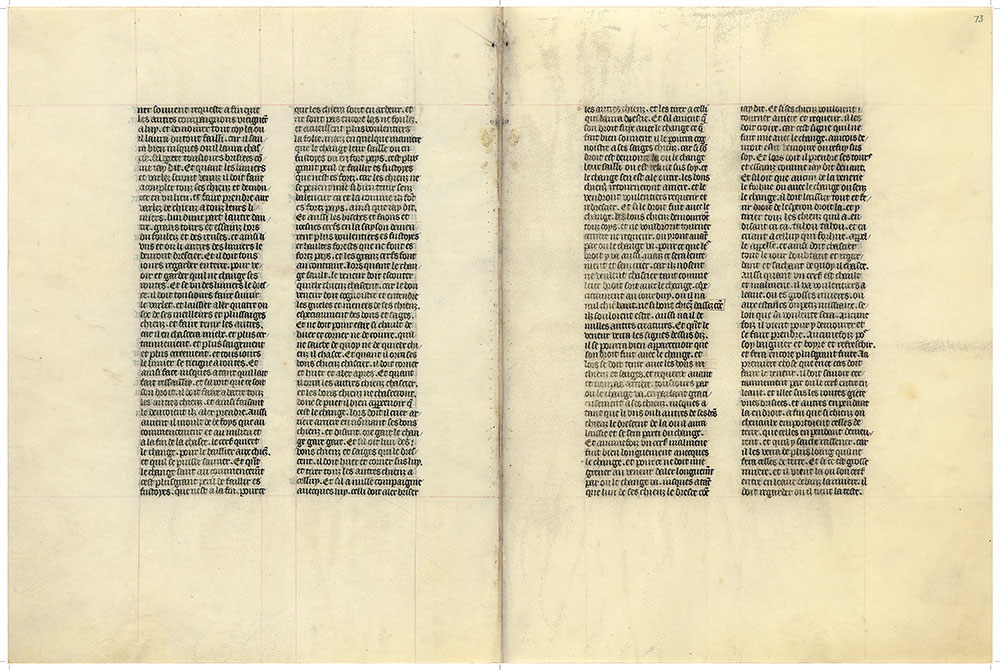
Livre de la chasse
Bequest of Clara S. Peck, 1983
Image courtesy of Faksimile Verlag Luzern
MS M.1044, fols. 73v–74r
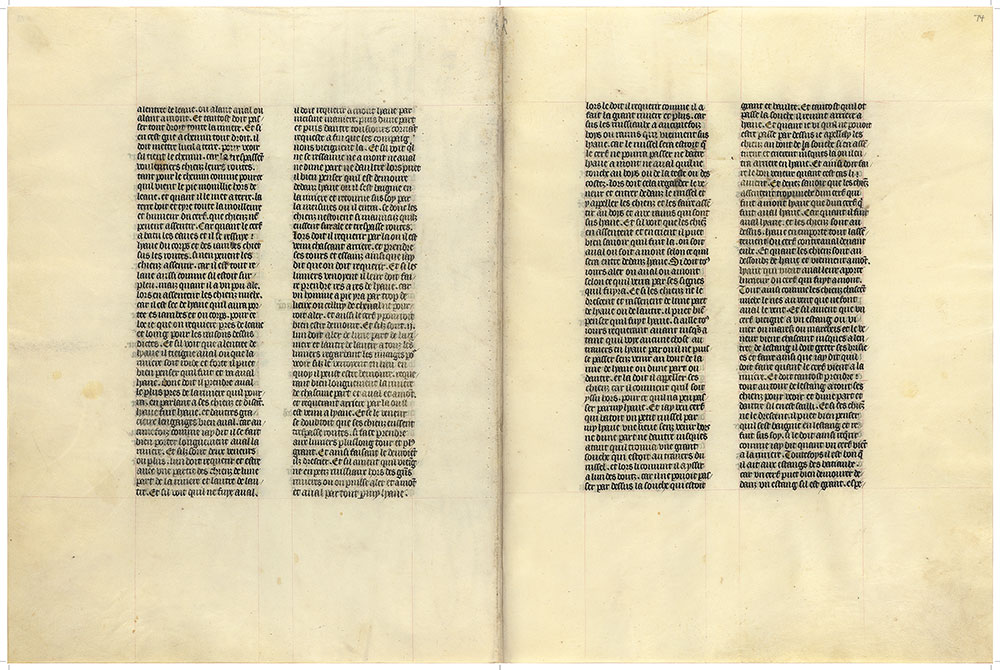
Livre de la chasse
Bequest of Clara S. Peck, 1983
Image courtesy of Faksimile Verlag Luzern
MS M.1044, fols. 74v–75r
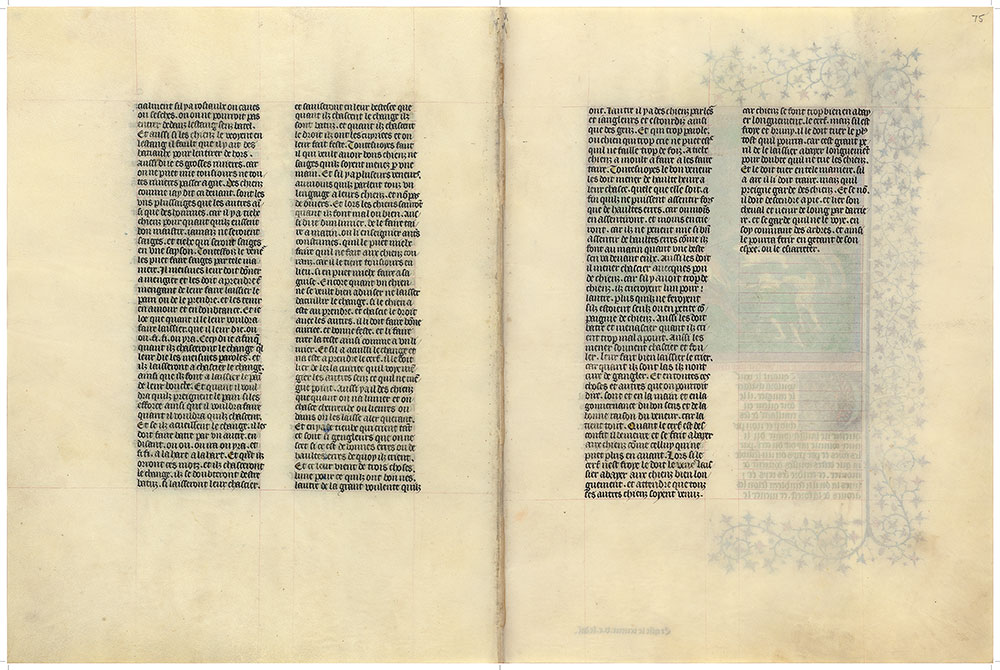
Livre de la chasse
Bequest of Clara S. Peck, 1983
Image courtesy of Faksimile Verlag Luzern
MS M.1044, fols. 75v–76r
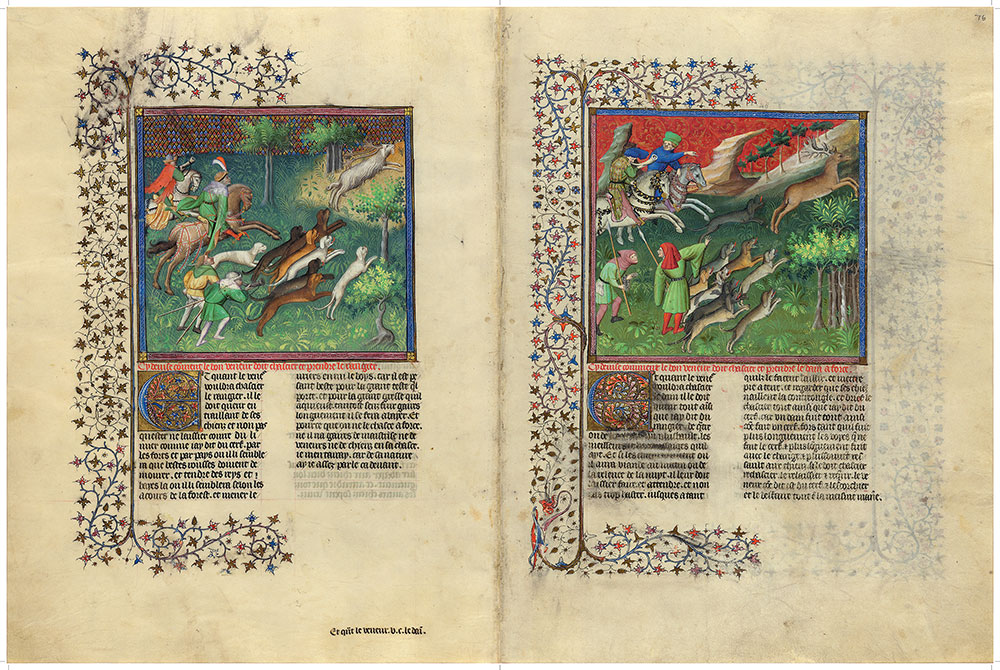
Livre de la chasse
Bequest of Clara S. Peck, 1983
Image courtesy of Faksimile Verlag Luzern
MS M.1044, fols. 76v–77r
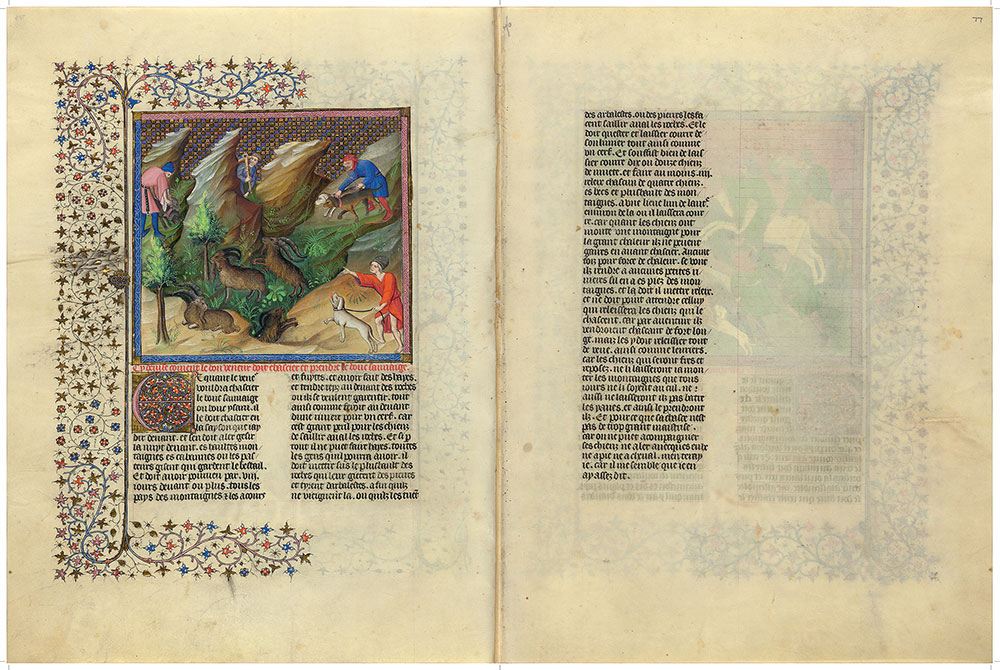
Livre de la chasse
Bequest of Clara S. Peck, 1983
Image courtesy of Faksimile Verlag Luzern
MS M.1044, fols. 77v–78r
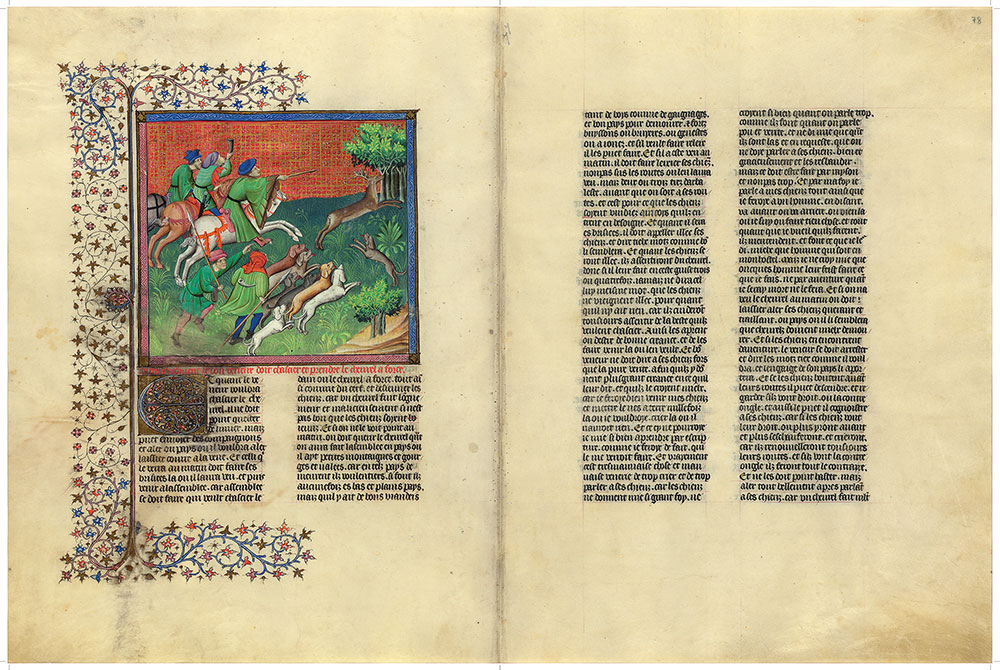
Livre de la chasse
Bequest of Clara S. Peck, 1983
Hunting the Roebuck
Roebucks were generally hunted by sight, making the services of the lymerer and his hound unnecessary. When a hunter spotted a roebuck he was to break a branch or mark the site in some way to let the others who had gathered for the chase know. When the hounds had been brought to the site the hunters were to incite them verbally. In this dramatic miniature, the horn has sounded and the dogs eagerly pursue the roebuck, whose antlers were rendered with too many points. Phoebus considered the hunt for the roe similar to that of the hart, but the former demanded greater perseverance because of its superior cunning and endurance. For this reason, the dogs were to be fed before the hunt and their master was to encourage them with particular affection.
Image courtesy of Faksimile Verlag Luzern
MS M.1044, fols. 78v–79r
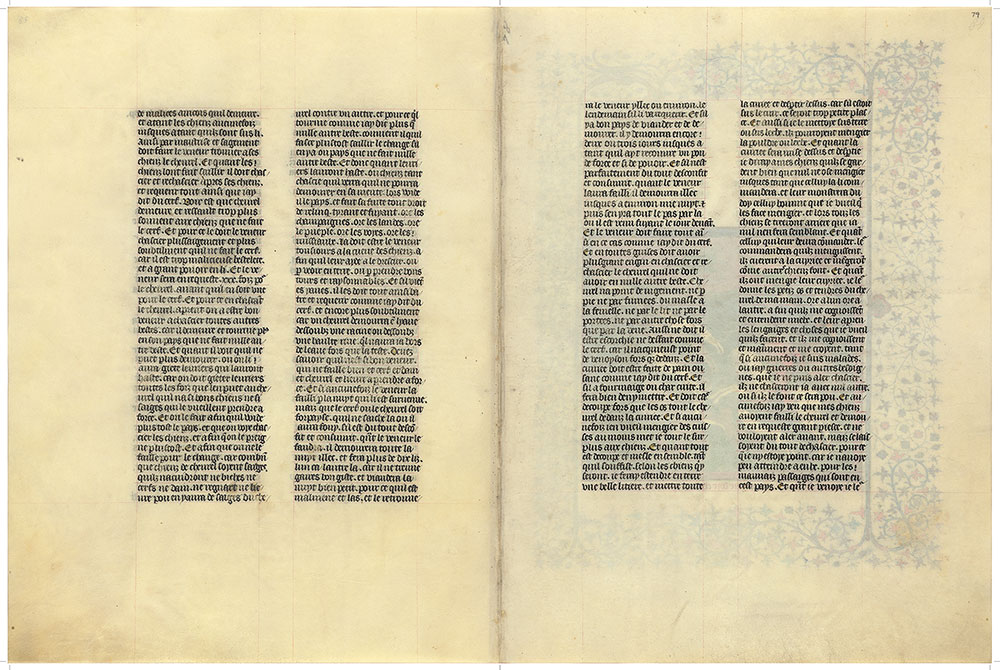
Livre de la chasse
Bequest of Clara S. Peck, 1983
Image courtesy of Faksimile Verlag Luzern
MS M.1044, fols. 79v–80r
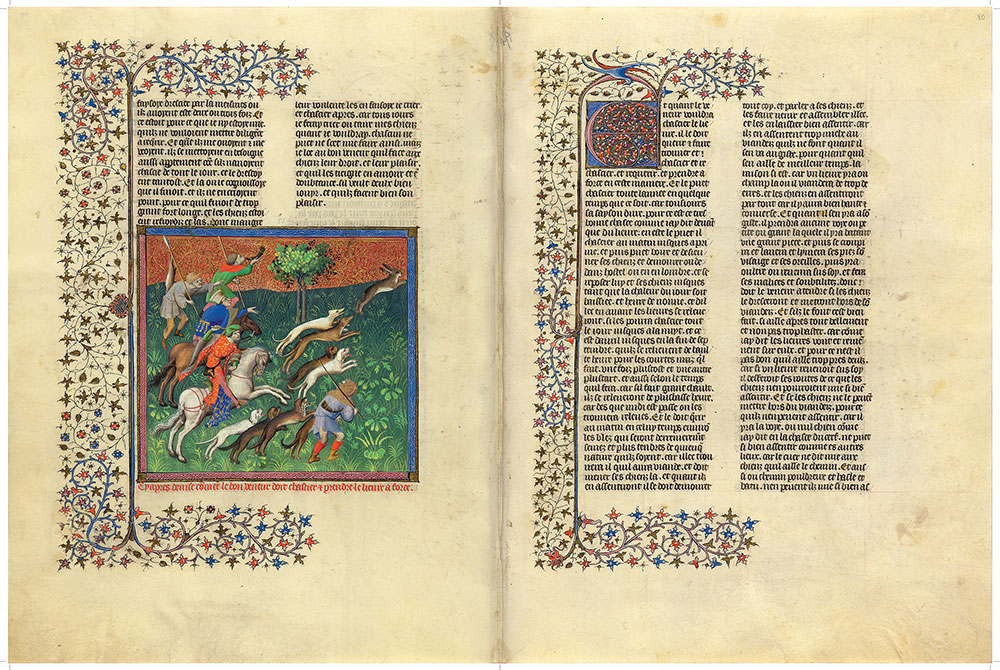
Livre de la chasse
Bequest of Clara S. Peck, 1983
Hunting and Slaying the Hare
There was no particular season for hunting hares; there were various peak times throughout the year. In the summer, early morning until the hour of Prime (6:00) was favorable, for the midday heat would dissipate the animal's scent. Later in the day, however, the hare could be found in shady places. Here two greyhounds are pursuing a hare by sight, which Phoebus warned might result in failure, as they might be so far ahead of the running hounds, which track by scent, that the latter might lose it. The horsemen carry sticks, which were used to discipline the horses, pages, and hounds and to protect their faces from branches or twigs. They could also be struck against their leather boots to incite the dogs and horses. A dead hare is slung over the stick carried by the groom in the background.
Image courtesy of Faksimile Verlag Luzern
MS M.1044, fols. 80v–81r
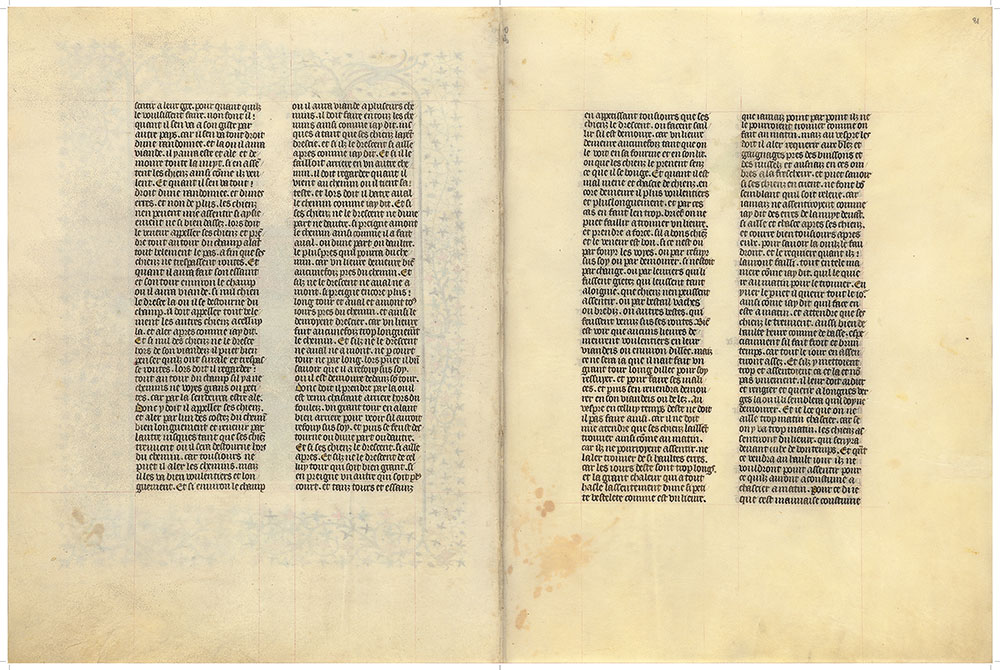
Livre de la chasse
Bequest of Clara S. Peck, 1983
Image courtesy of Faksimile Verlag Luzern
MS M.1044, fols. 81v–82r
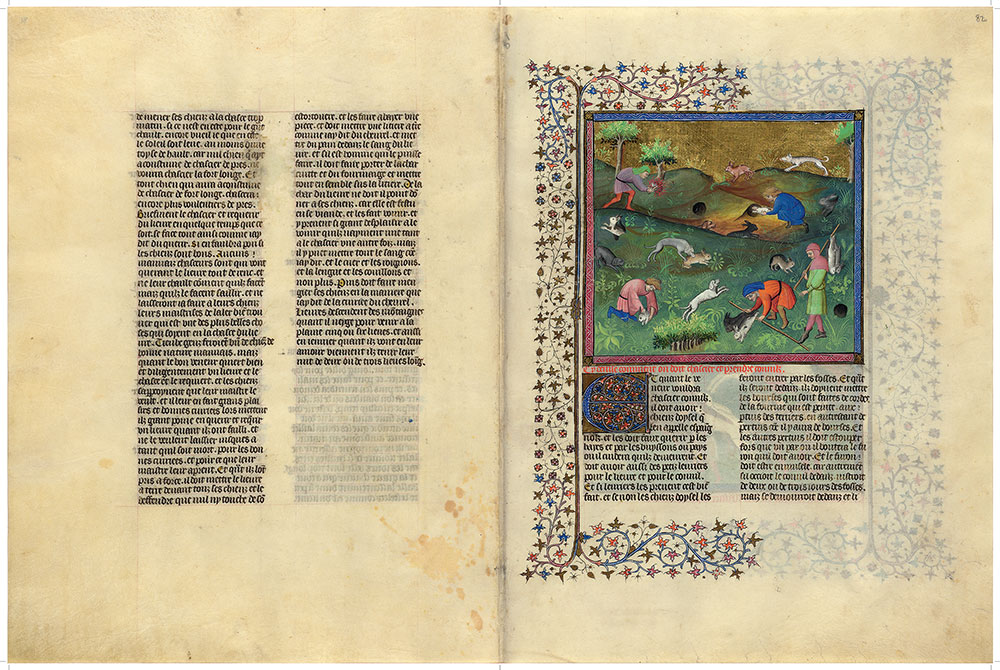
Livre de la chasse
Bequest of Clara S. Peck, 1983
Hunting and Catching the Rabbit
Spaniels were used simply to catch the rabbits or to drive them into their burrows. Several ways were devised to then drive the rabbits from their burrows into the waiting nets or hands of the hunters. The groom dressed in blue in the upper right corner, for instance, drops a ferret into a rabbit hole, causing the rabbits to flee. The ferret had to be muzzled because otherwise it would feast on the rabbit and remain in its burrow. If no ferret was handy, the rabbits could be smoked out by burning a little parchment bag containing a mixture of yellow arsenic, sulfur, and myrrh and then throwing it into the burrow, as shown in the upper left corner. The tactics worked, as one man has two dead rabbits hanging from his stick, while another has tied the hind legs of three more rabbits together and is about to suspend them from his stick.
Image courtesy of Faksimile Verlag Luzern
MS M.1044, fols. 82v–83r
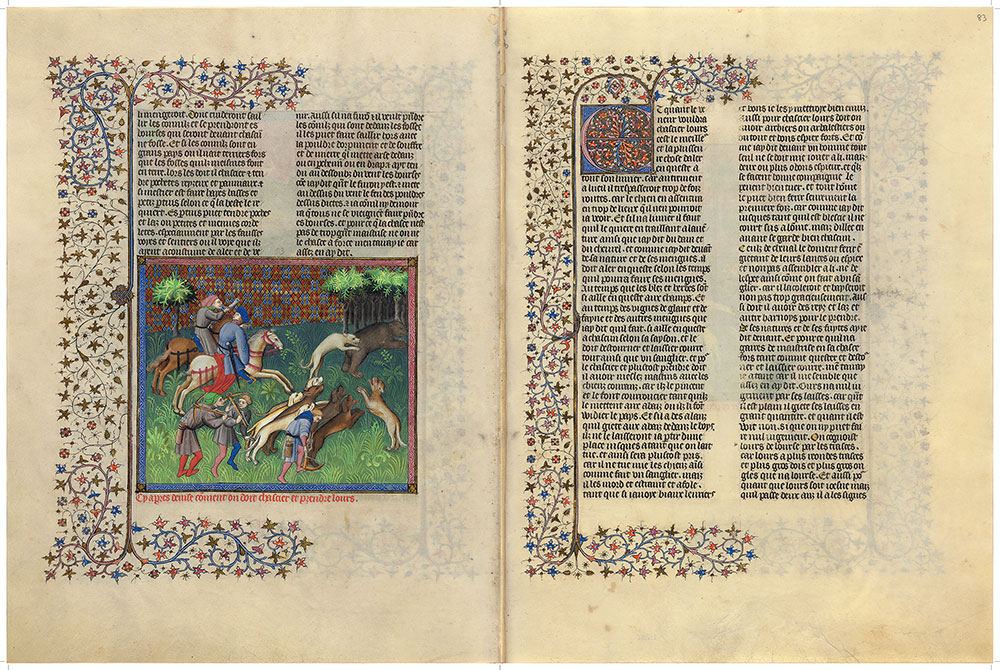
Livre de la chasse
Bequest of Clara S. Peck, 1983
Image courtesy of Faksimile Verlag Luzern
MS M.1044, fols. 83v–84r
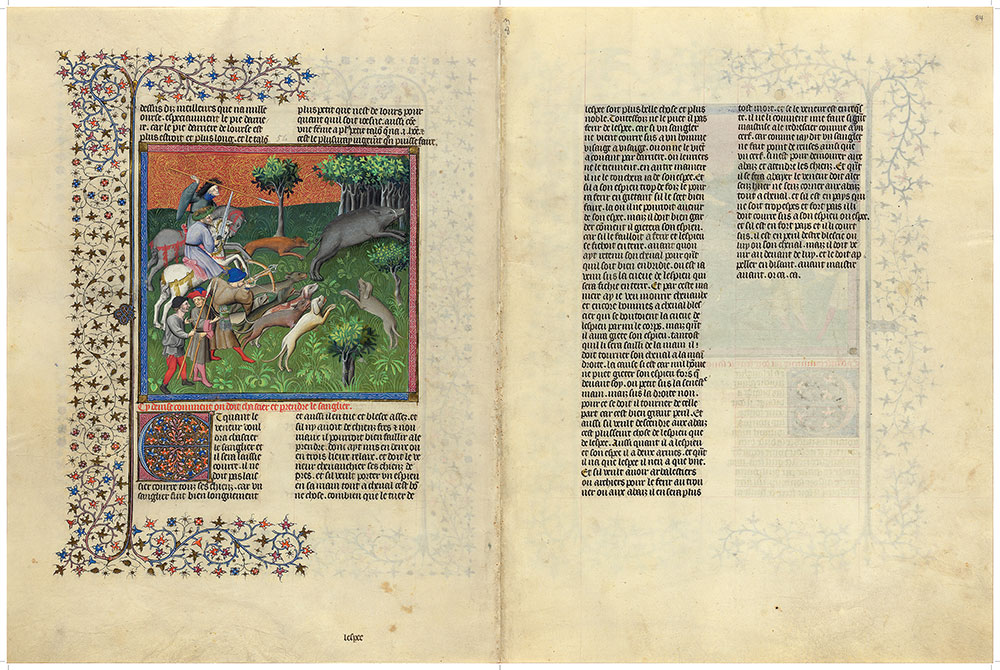
Livre de la chasse
Bequest of Clara S. Peck, 1983
Hunting and Slaying the Wild Boar
Boar hunting could take a long time, as part of the strategy was to tire the animal before striking, both to spare the hounds from being killed or severely injured, and to protect the hunter. Phoebus suggested that horsemen going in for the kill ride against the boar, avoiding the direction in which a spear had been thrown, as he had seen horses and horsemen killed by errant spears that hit the ground, impaling the horse. In the miniature, three different weapons are about to be used: one of the noblemen has raised his spear, the other a sword, and the standing hunter has just loaded his crossbow with an arrow from his quiver. A pack of eight hounds joins the pursuit.
Image courtesy of Faksimile Verlag Luzern
MS M.1044, fols. 84v–85r

Livre de la chasse
Bequest of Clara S. Peck, 1983
Dispatching the Wild Boar
The huntsman who wished to slay a boar was to ride against it, standing firmly in his metal stirrups, and thrust his three-foot-long sword downward into the boar with all his might, as in the miniature. In order to prevent cutting the user's leg, the part of the sword worn closest to the body was blunted. Other strategies included containing the boar with a pack of dogs or immobilizing it by hamstringing (the horseman in red severs a main tendon of its rear leg), permitting the hunter to spear the animal or drive a sword into its heart.
Image courtesy of Faksimile Verlag Luzern
MS M.1044, fols. 85v–86r
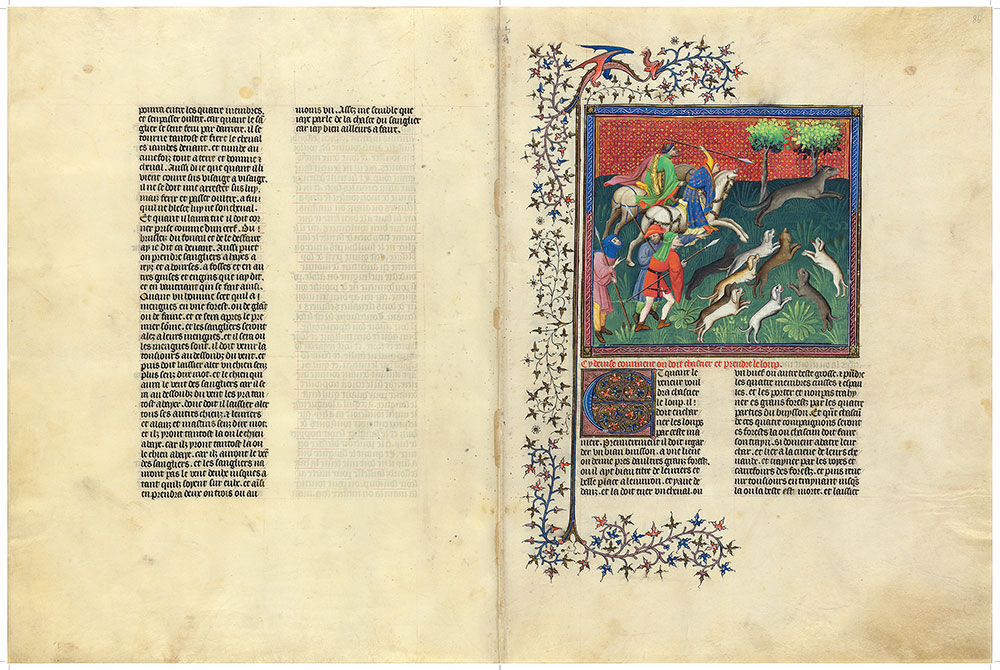
Livre de la chasse
Bequest of Clara S. Peck, 1983
Hunting and Slaying the Wolf
The wolf was a threat not only to sheep but other animals as well. It was also a threat to human life and, during wars, provided a service by eating dead soldiers. Thus there was little love for the wolf, and no killing or trapping method was considered too cruel. Suggestions included baiting them with morsels of meat containing needles pointed at both ends or trapping them in a noose, which kept them helplessly dangling in the air (see fols. 98 and 96 in facsimile). This miniature depicts the final moments of the chase, in which the wolf is pursued by nobles on horseback and a pack of dogs followed by men with spears. (Before this the wolf had to be baited, located, and forced out of the thicket by hounds.)
Image courtesy of Faksimile Verlag Luzern
MS M.1044, fols. 86v–87r
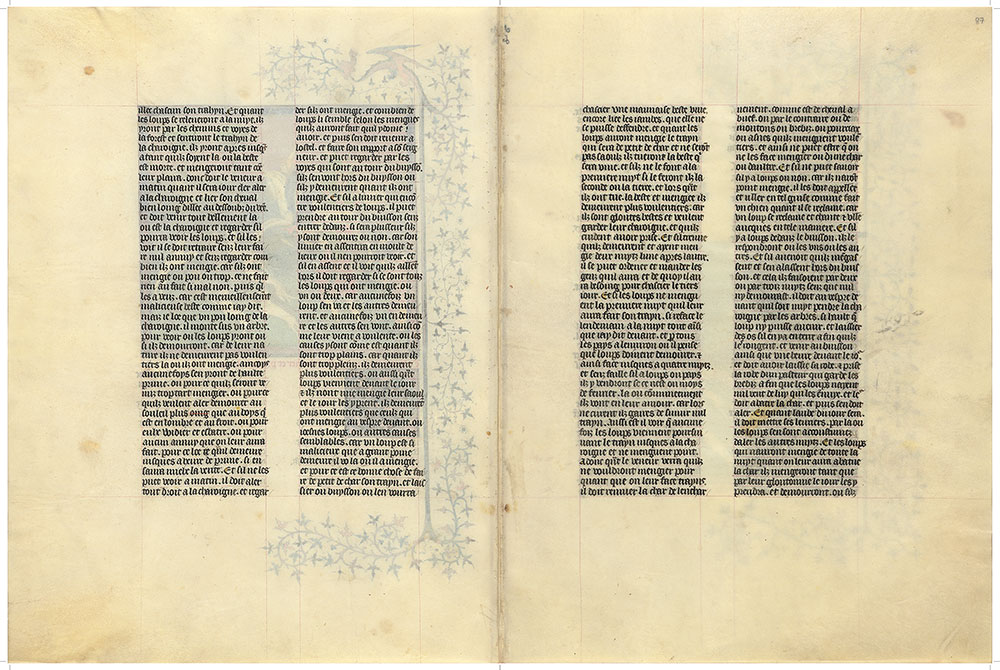
Livre de la chasse
Bequest of Clara S. Peck, 1983
Image courtesy of Faksimile Verlag Luzern
MS M.1044, fols. 87v–88r
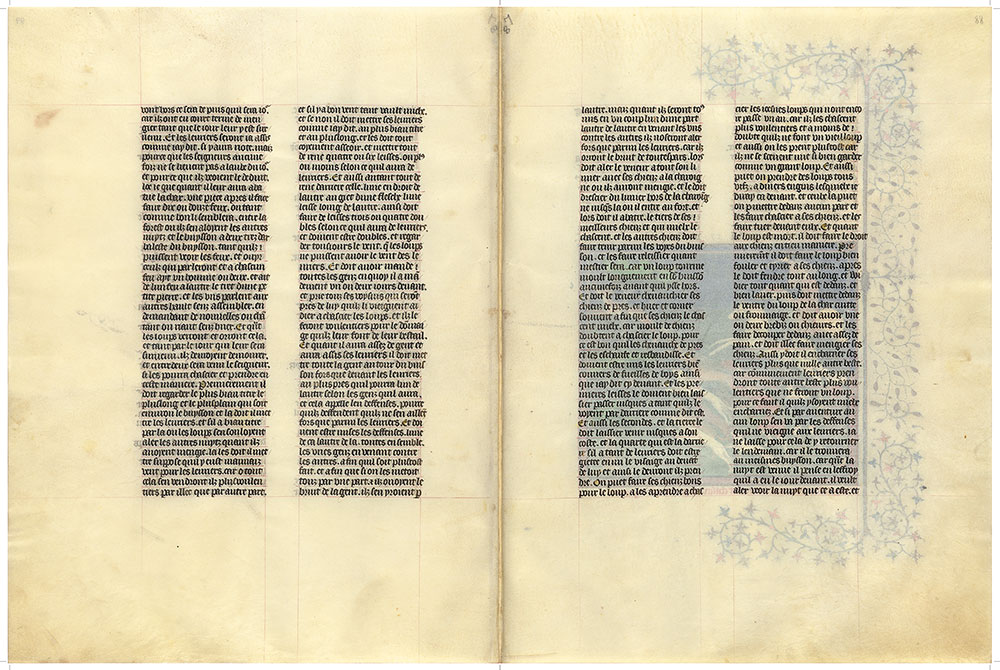
Livre de la chasse
Bequest of Clara S. Peck, 1983
Image courtesy of Faksimile Verlag Luzern
MS M.1044, fols. 88v–89r
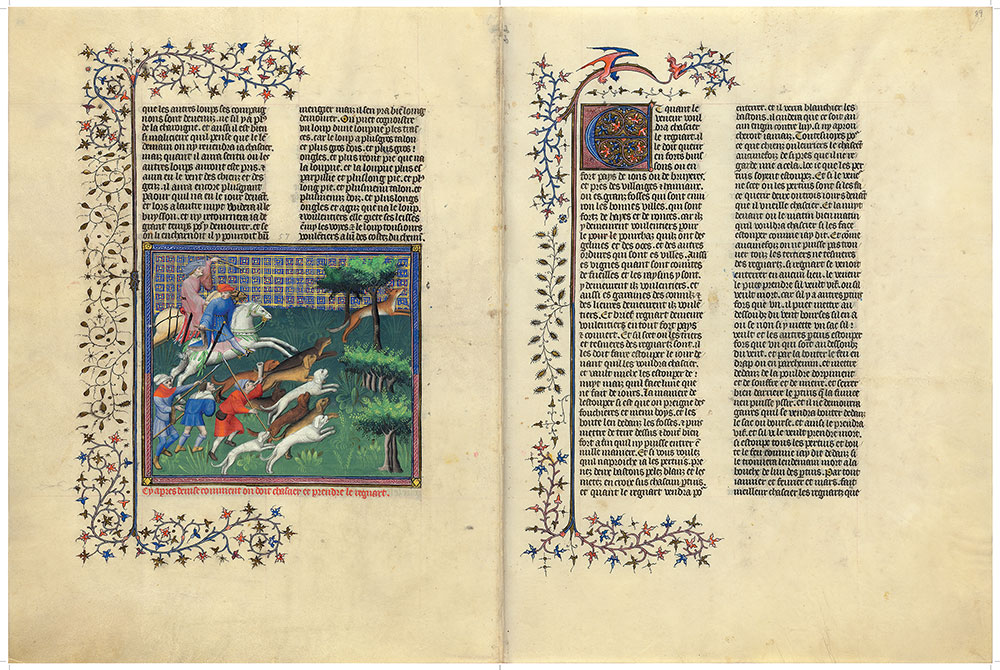
Livre de la chasse
Bequest of Clara S. Peck, 1983
Image courtesy of Faksimile Verlag Luzern
MS M.1044, fols. 89v–90r
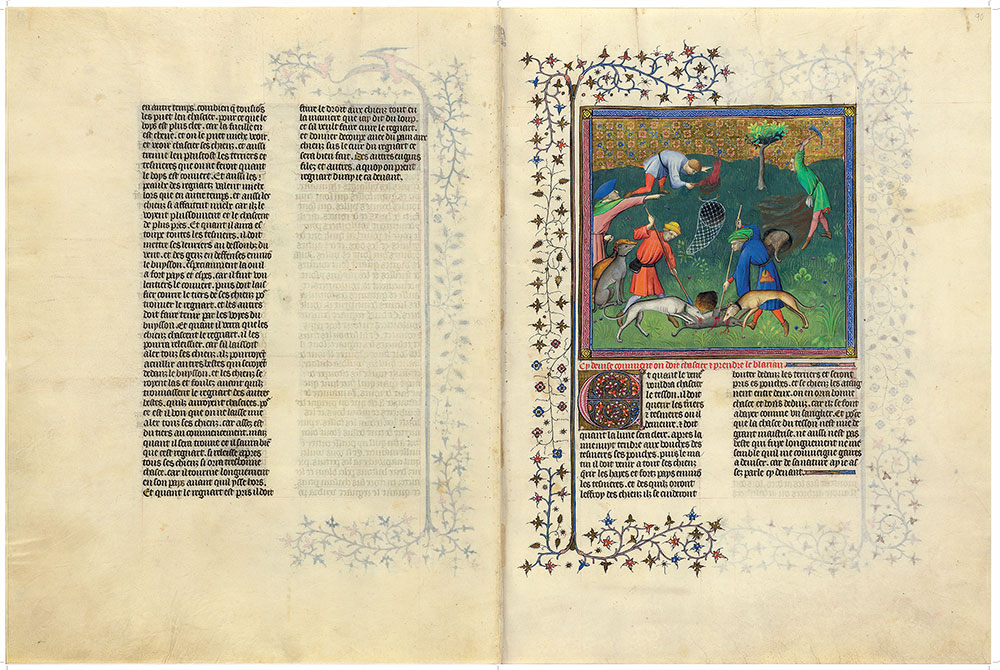
Livre de la chasse
Bequest of Clara S. Peck, 1983
Image courtesy of Faksimile Verlag Luzern
MS M.1044, fols. 90v–91r
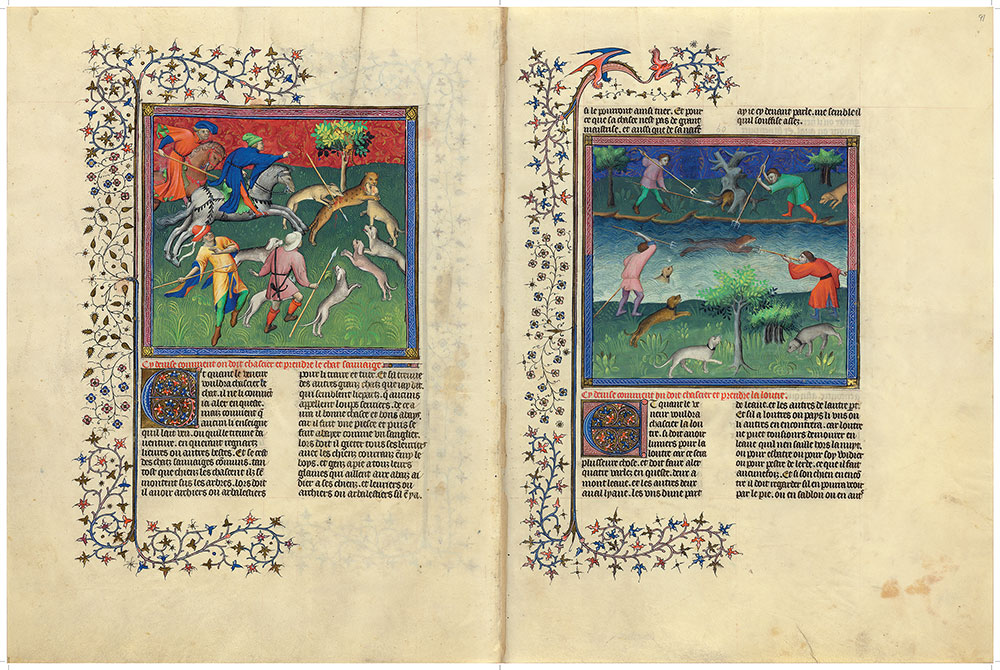
Livre de la chasse
Bequest of Clara S. Peck, 1983
Hunting and Slaying Wild Cats
Hunters did not usually quest wild cats, but would go after them when they were encountered in the course of seeking other game, such as foxes or hares. Here, what Phoebus called a cat-leopard (lynx), is pursued by equestrian hunters with spears, backed up with hounds and two grooms also armed with spears. The cat-leopard was dangerous because it had claws like a leopard and such a fierce bite that it could severely injure a hound. A second cat has sought refuge in a tree, from which it could easily be shot down with a bow or crossbow.
Hunting and Slaying the Otter
The otter, like the fox, was little loved because it preyed on fish, not only in rivers but in ponds, cutting into the food supply. Since the otter left the water at night, the lymerer, with specially trained lymers, picked up his trail at the water's edge, where footprints and characteristic droppings would indicate both the direction and point at which the otter left or entered the water. For a single river, as depicted here, Phoebus suggested the use of four men–—two on each bank, one to go upstream, the other down. Hunters, with spears or tridents, stab the otter. Were they to miss, the otter would still end up in the weighted nets that were spread above and below the otter's couch (lair). A second otter has been captured in a tree trunk. The otter would then be skinned and his cooked flesh would provide a feast for the dogs.
Image courtesy of Faksimile Verlag Luzern
MS M.1044, fols. 91v–92r
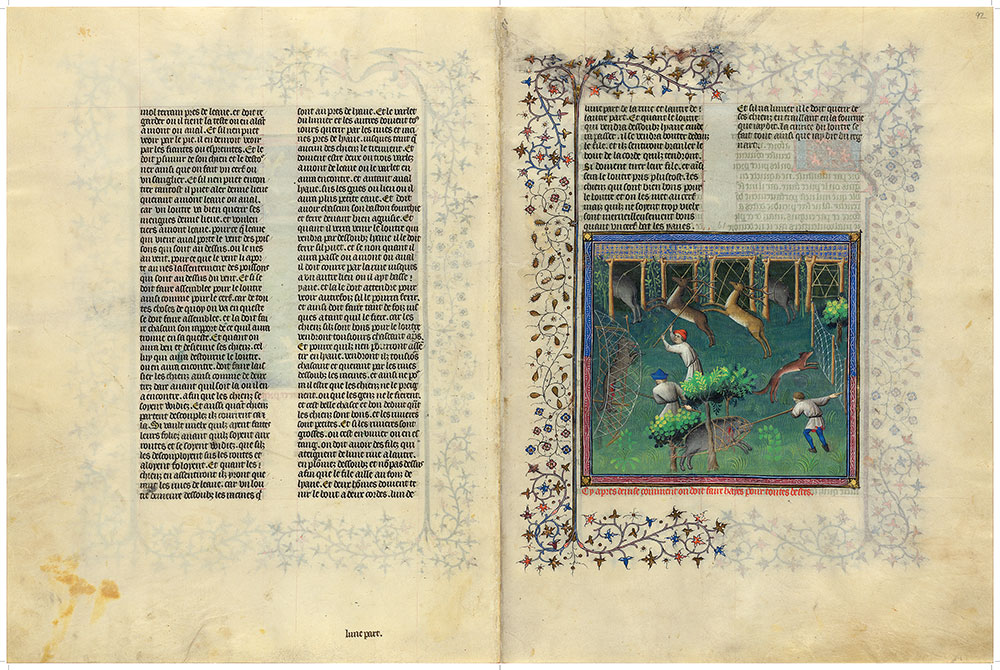
Livre de la chasse
Bequest of Clara S. Peck, 1983
Laying Hedges for Catching Game
While the third book of Le Livre de la chasse deals with hunting par force de chiens (through the strength of dogs), Phoebus's final book treats the capturing of game par maistrise (through cunning and skill). He actually expressed his opposition to the use of nets and other trapping devices, for he found them less noble and gentle and feared they might overly reduce available game. Nevertheless, an earlier chapter discussed and illustrated the making of snares and traps (fol. 45). In the miniature, men dressed in green and armed with spears wait for game to be trapped in various snares and nets that have been disguised as part of a hedge. The use of such hedges to catch stags was reserved for old hunters who could not keep up with the chase.
Image courtesy of Faksimile Verlag Luzern
MS M.1044, fols. 92v–93r
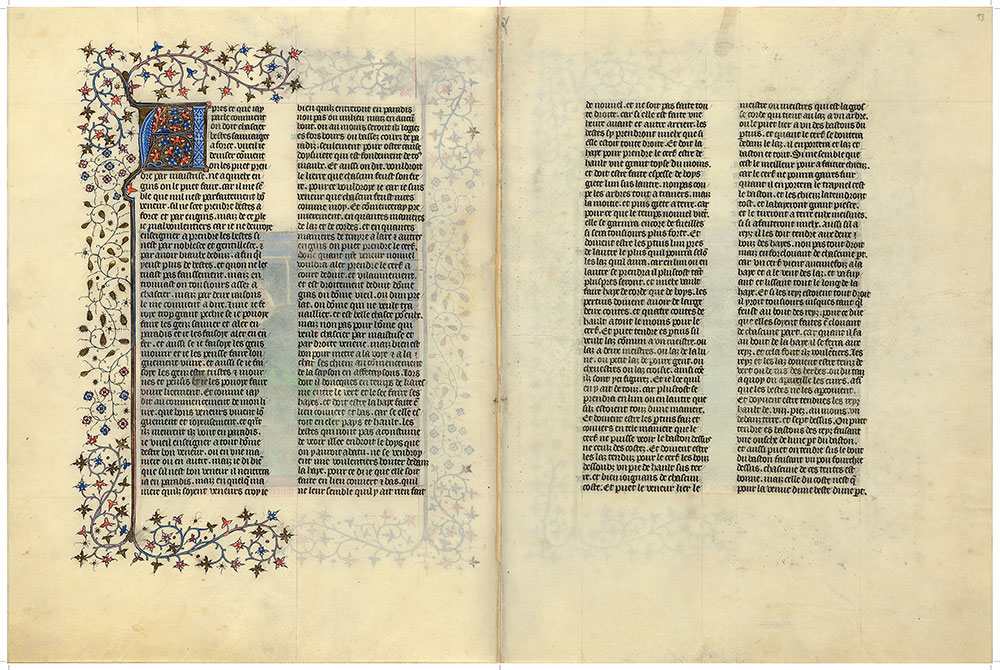
Livre de la chasse
Bequest of Clara S. Peck, 1983
Image courtesy of Faksimile Verlag Luzern
MS M.1044, fols. 93v–94r
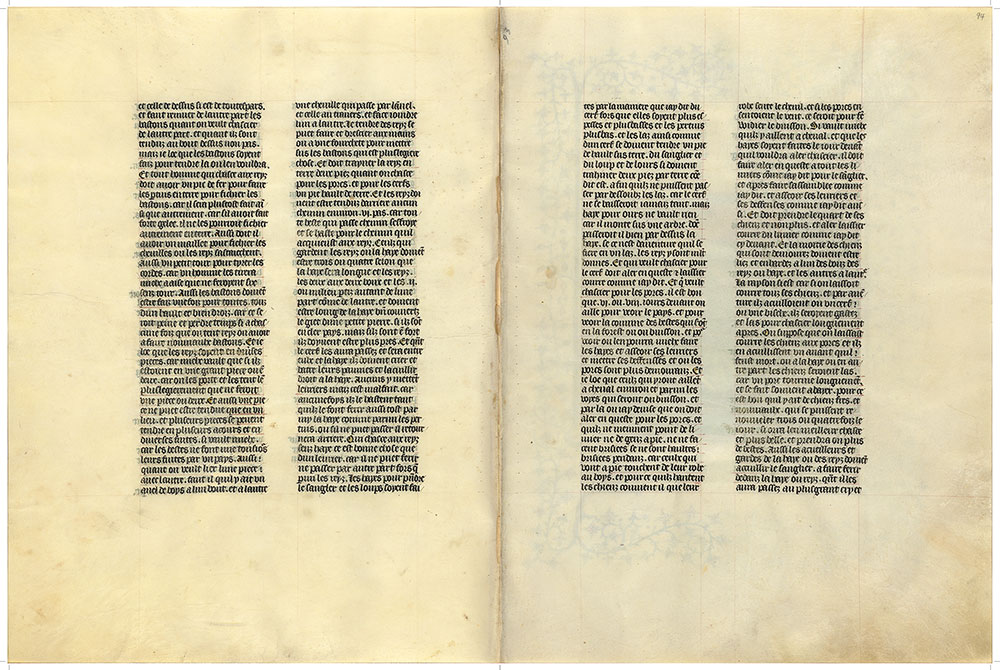
Livre de la chasse
Bequest of Clara S. Peck, 1983
Image courtesy of Faksimile Verlag Luzern
MS M.1044, fols. 94v–95r

Livre de la chasse
Bequest of Clara S. Peck, 1983
Image courtesy of Faksimile Verlag Luzern
MS M.1044, fols. 95v–96r
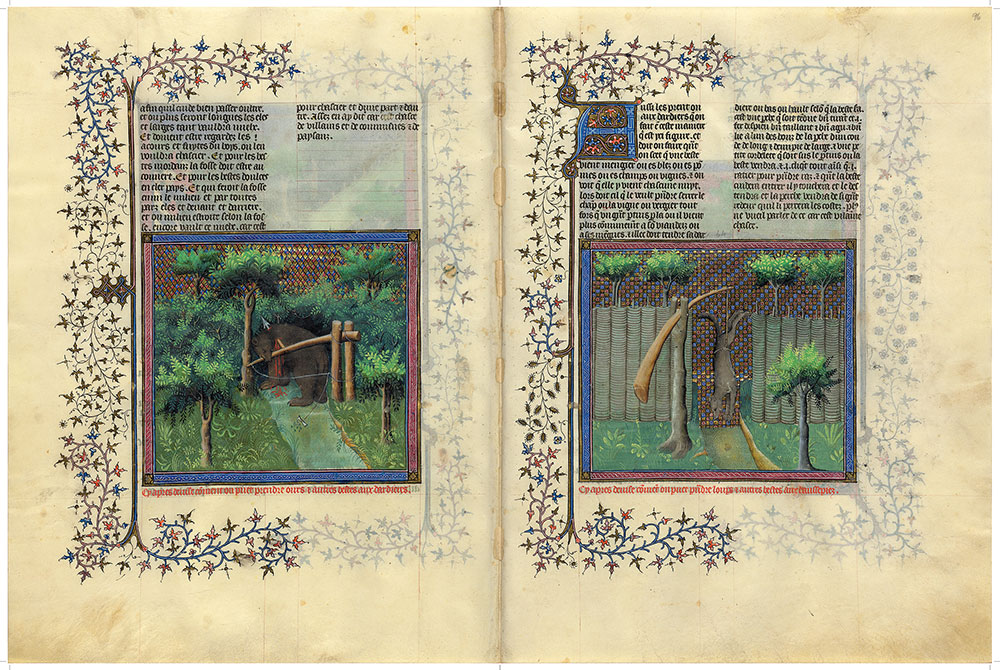
Livre de la chasse
Bequest of Clara S. Peck, 1983
Image courtesy of Faksimile Verlag Luzern
MS M.1044, fols. 96v–97r
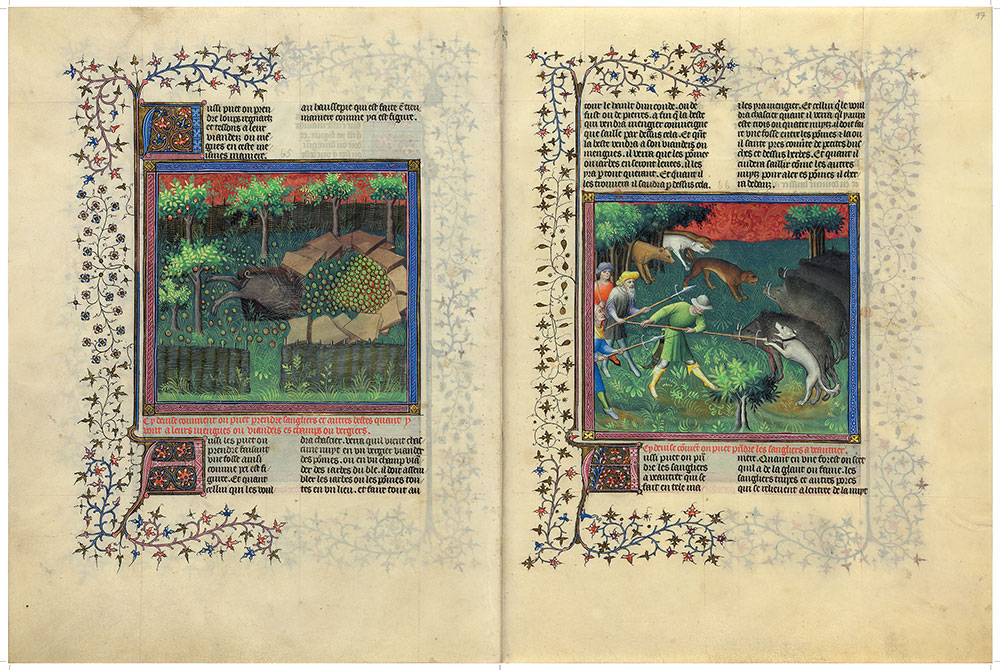
Livre de la chasse
Bequest of Clara S. Peck, 1983
Capturing Wild Boars Feeding in Fields and Orchards
After hunters observed, night after night, that boars would return to feed on apples in the same orchard, they surrounded the apples on the ground with an enclosure built up of either wood or stone, over which the boars would be forced to jump in order to feed. After a few nights, however, a pit would be dug on one end of the enclosure and covered with thin branches and grass as in the miniature. The boar, accustomed to an easy meal, would take the bait, jump over the enclosure, and end up in the pit, where he would become easy prey.
Slaying Wild Boars Feeding on Mast
Wild boars would search for mast (acorns and beechnuts) in the woods, which they usually found by nightfall. Hunters, with their pack of dogs, were advised to approach against the wind in order to avoid detection. First, a single dog would be released to locate and bay at the herd of wild boars. When the other huntsmen heard the baying, they would uncouple the other hounds and chase them with spears, as in the miniature. The lead hunter, dressed in green with an oriental scimitar suspended from his waist, has already pierced a boar's side.
Image courtesy of Faksimile Verlag Luzern
MS M.1044, fols. 97v–98r
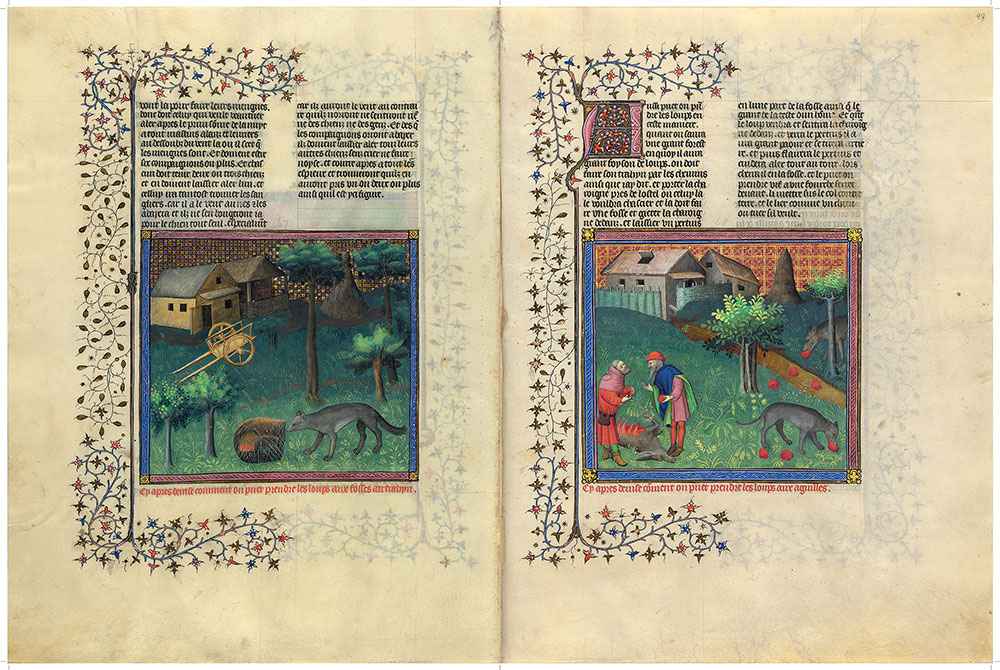
Livre de la chasse
Bequest of Clara S. Peck, 1983
Image courtesy of Faksimile Verlag Luzern
MS M.1044, fols. 98v–99r
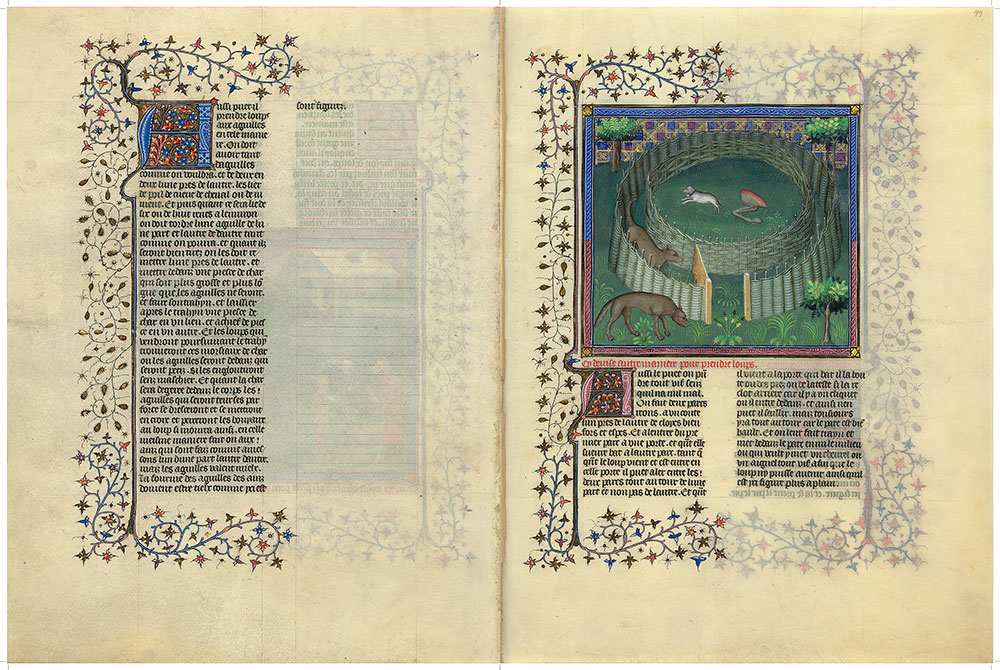
Livre de la chasse
Bequest of Clara S. Peck, 1983
Image courtesy of Faksimile Verlag Luzern
MS M.1044, fols. 99v–100r
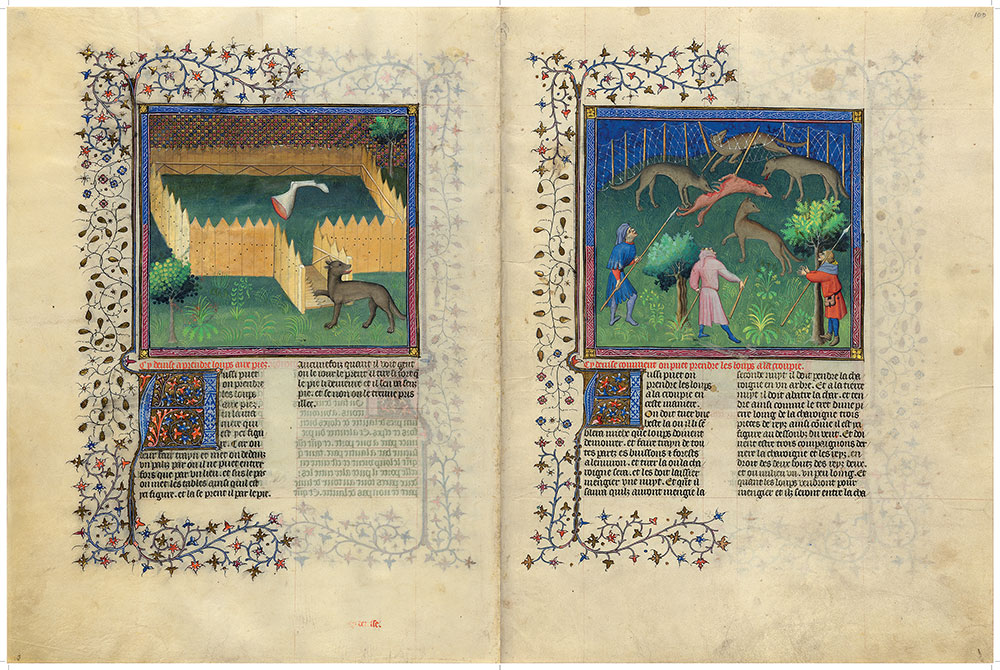
Livre de la chasse
Bequest of Clara S. Peck, 1983
Image courtesy of Faksimile Verlag Luzern
MS M.1044, fols. 100v–101r
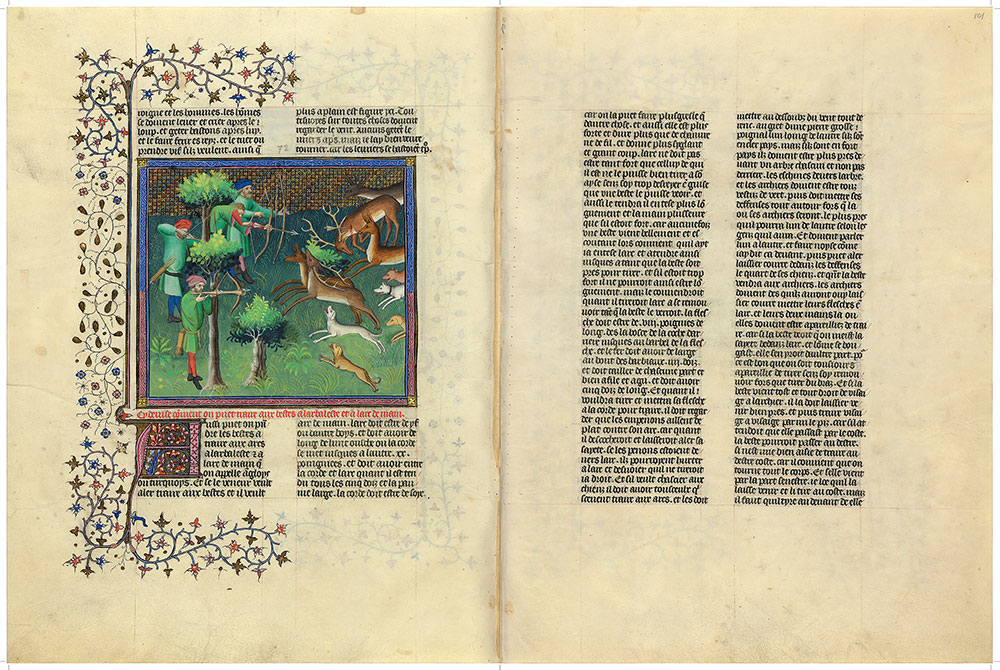
Livre de la chasse
Bequest of Clara S. Peck, 1983
Phoebus recommended that bows be made of boxwood or yew and twenty hands long (over three feet). They were to be strung with silk, which was more elastic than hemp. Arrows were to be eight hands long, and the double-edged and barbed head five fingers long and four wide. A hunter stalking for game was always to have his bow ready and partly drawn in order to avoid a quick motion. The arrow was to pierce the animal's breast, but if the animal was not killed, it was to be pursued by a lymer. Here the archers are camouflaged by the trees and their green dress. Phoebus cautioned that one was to shoot only what one clearly saw. In order to avoid accidents in the pursuit of game, care had to be taken not to cross the line of shooters.
Image courtesy of Faksimile Verlag Luzern
MS M.1044, fols. 101v–102r
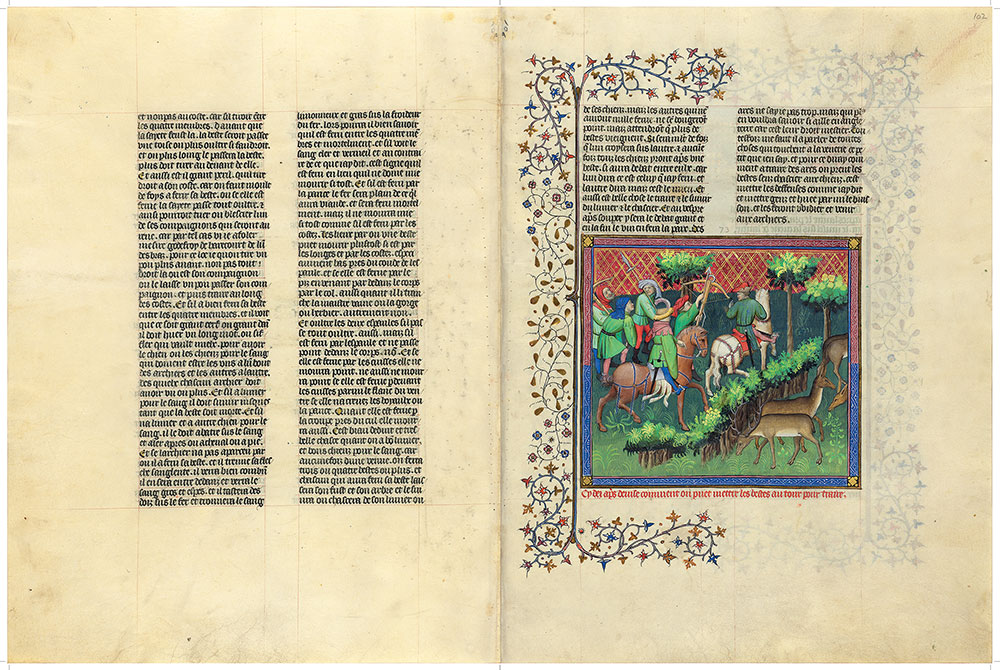
Livre de la chasse
Bequest of Clara S. Peck, 1983
Preparing an Ambush
Since horses did not frighten game, they could serve as a cover for bowmen. According to the scheme, two horses were to follow each other so closely that the muzzle of one would touch the tail of the other, enabling the huntsmen behind them to get very close to his quarry. In the miniature, the horsemen and hunters are dressed in green, but the horses are not camouflaged with branches and the bows are not painted green, as Phoebus suggested. One of the horsemen points to the harts, who continue to graze, undisturbed by their presence. As the horses get closer to the harts, the bowmen take cover behind trees before shooting at the prey.
Image courtesy of Faksimile Verlag Luzern
MS M.1044, fols. 102v–103r
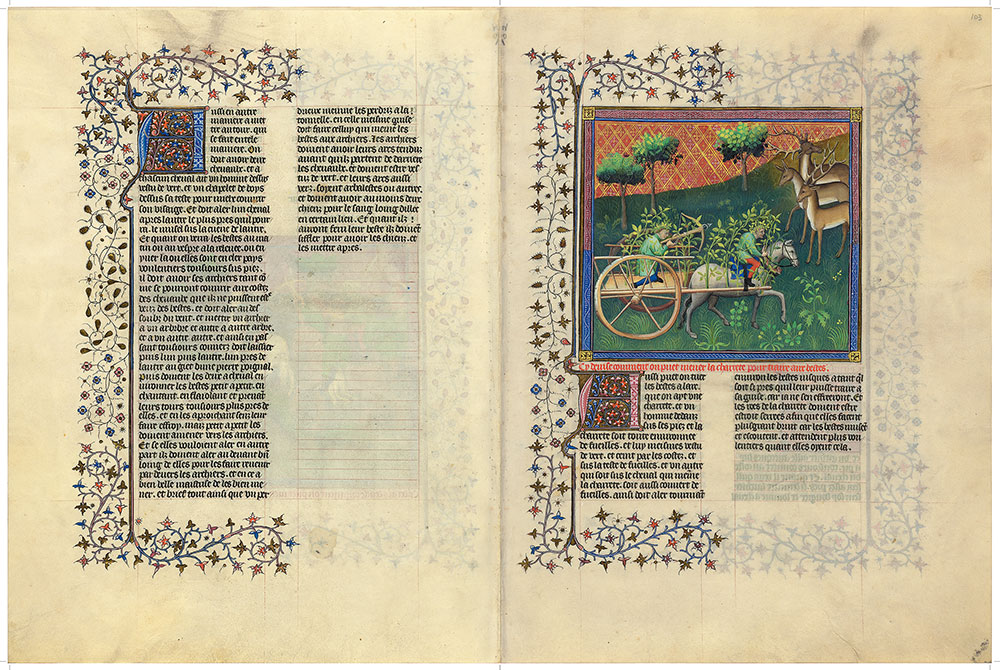
Livre de la chasse
Bequest of Clara S. Peck, 1983
Image courtesy of Faksimile Verlag Luzern
MS M.1044, fols. 103v–104r
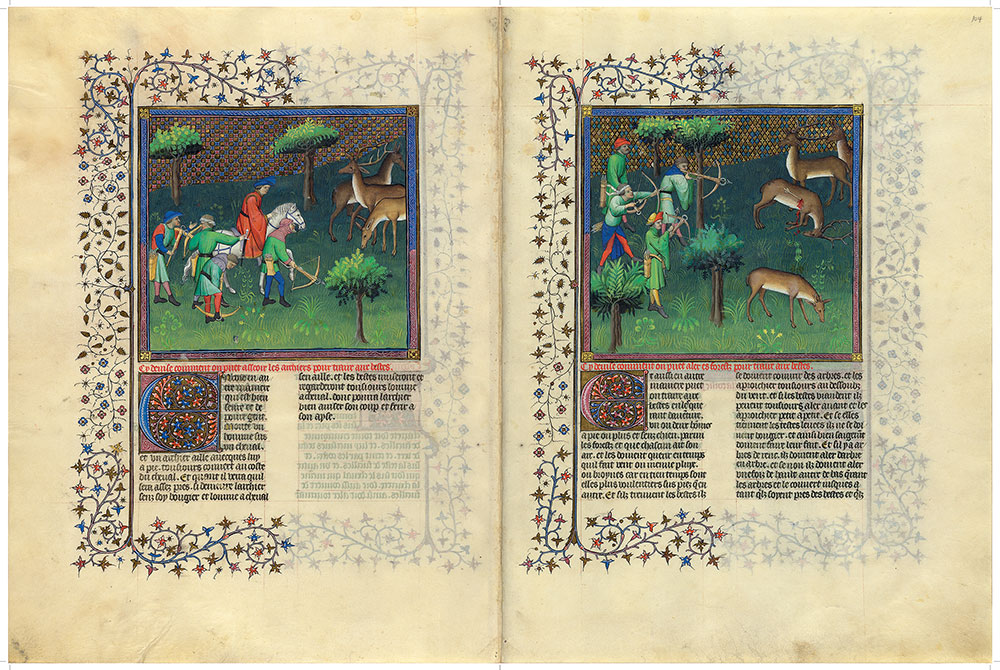
Livre de la chasse
Bequest of Clara S. Peck, 1983
Image courtesy of Faksimile Verlag Luzern
MS M.1044, fols. 104v–105r
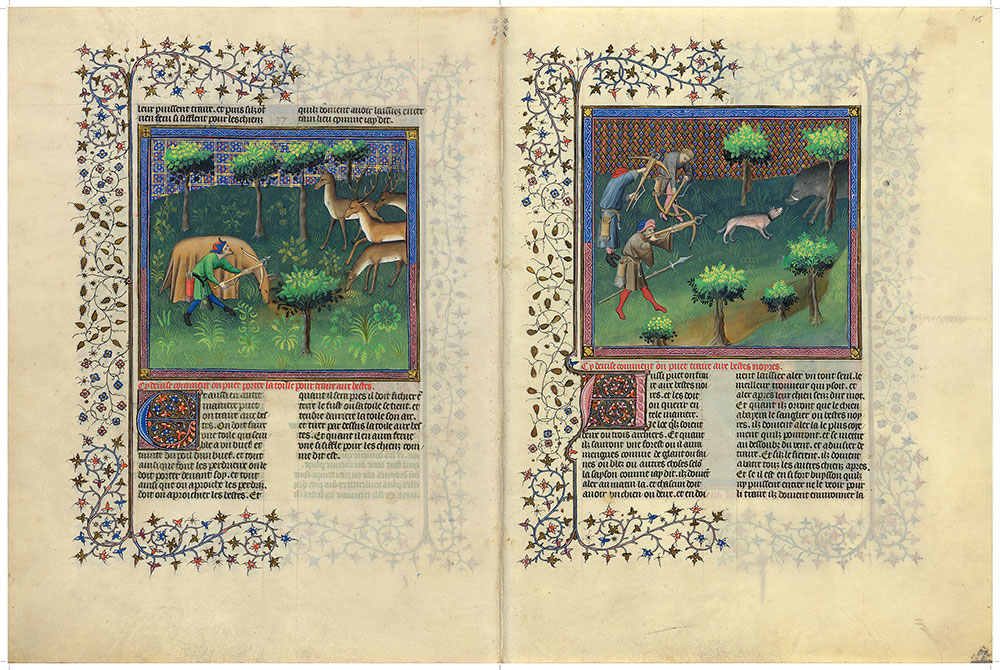
Livre de la chasse
Bequest of Clara S. Peck, 1983
Image courtesy of Faksimile Verlag Luzern
MS M.1044, fols. 105v–106r
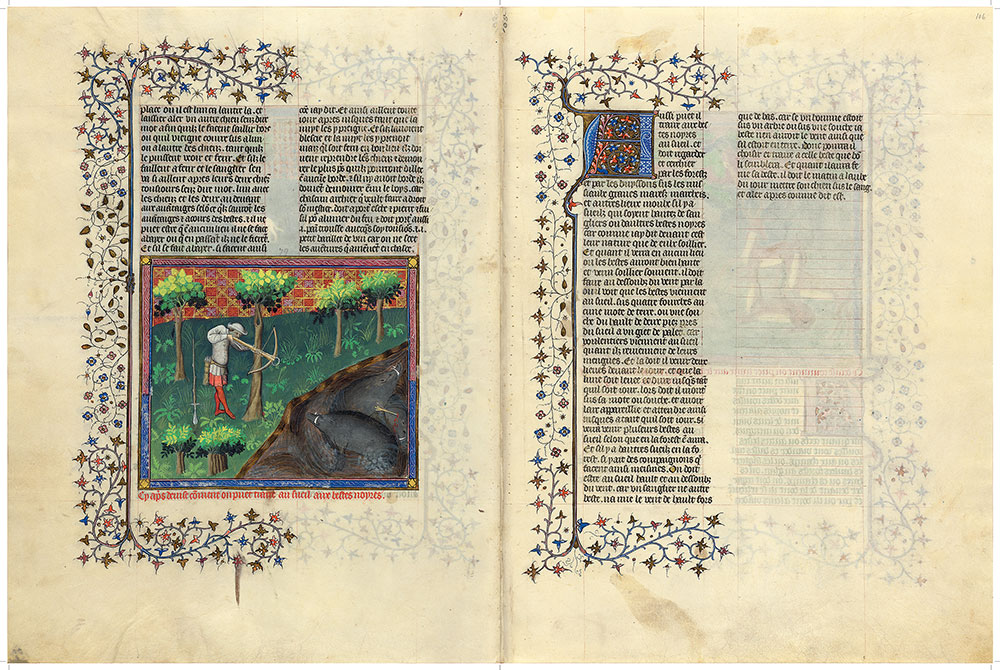
Livre de la chasse
Bequest of Clara S. Peck, 1983
Image courtesy of Faksimile Verlag Luzern
MS M.1044, fols. 106v–107r
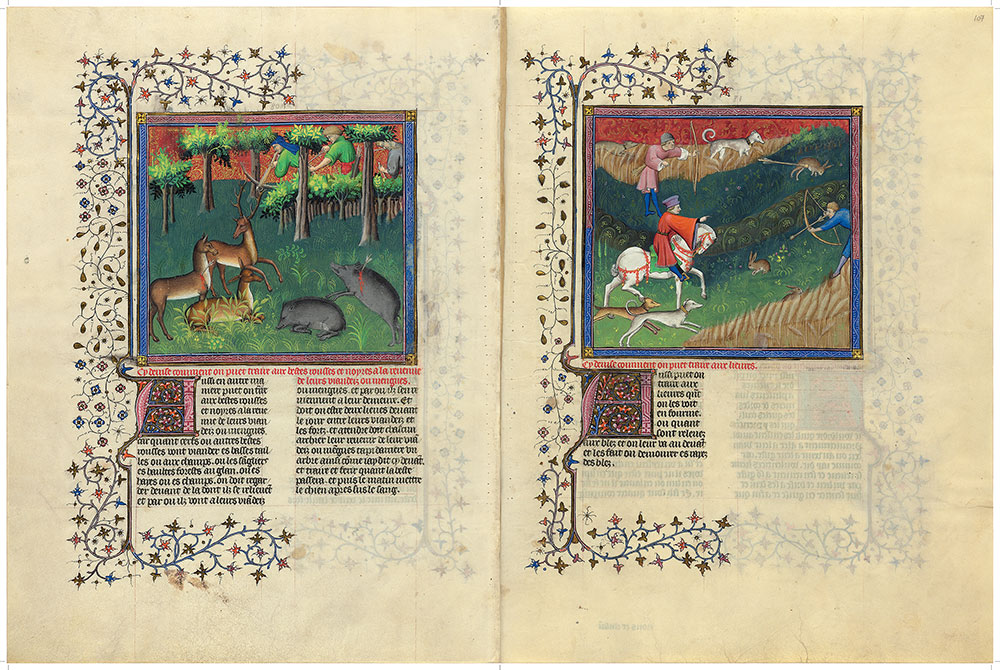
Livre de la chasse
Bequest of Clara S. Peck, 1983
Shooting Hares with Bows
While lymers, trackings, and droppings were a fundamental part of stag and boar hunts, they were of little use in hunting the wily hare. Phoebus, however, mentioned the special role of greyhounds in chasing hares. The French name of the breed, lévrier, derives from lièvre, the French name for "hare." In the miniature, the master of the hunt, from his elevated position on horseback, points out a hare to the bowman dressed in blue, while another has already stunned or killed his prey. The two bowmen do not use pointed arrows but wooden bolts that do not destroy the hare's flesh or fur. Two greyhounds are in the foreground, while, at the top of the miniature, two others have chased the hare from a wheat field.
Image courtesy of Faksimile Verlag Luzern
MS M.1044, fols. 107v–108r
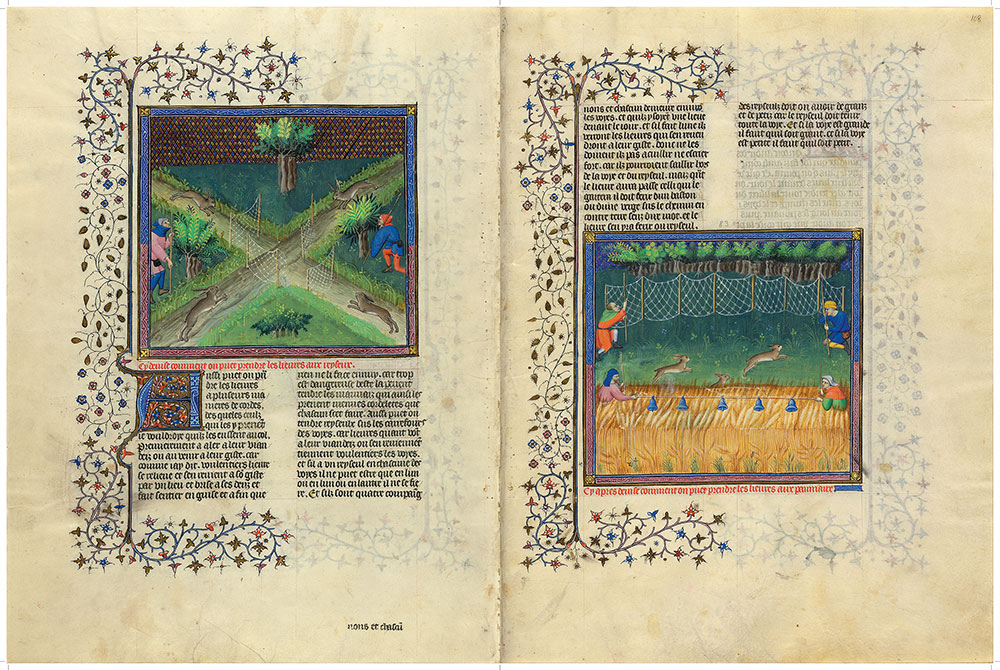
Livre de la chasse
Bequest of Clara S. Peck, 1983
Bagging Hares in Purse Nets
Phoebus devoted five chapters to various ways of catching hares in nets. This chapter describes how, two hours before daybreak, nets were to be strung between fields where hares were likely to pasture, usually quite close to their covert, or thicket, which provided them with cover. Two grooms, after attaching small bells to a long rope, would then place it in a wheat field facing their covert. When they tinkled the bells, the hares would be driven into the open green meadow, the nets, and the waiting hunters. Phoebus did not regard hunting hares with all sorts of cords as particularly noble, saying he would rather see them around the necks of those who use them.
Image courtesy of Faksimile Verlag Luzern
MS M.1044, fols. 108v–109r
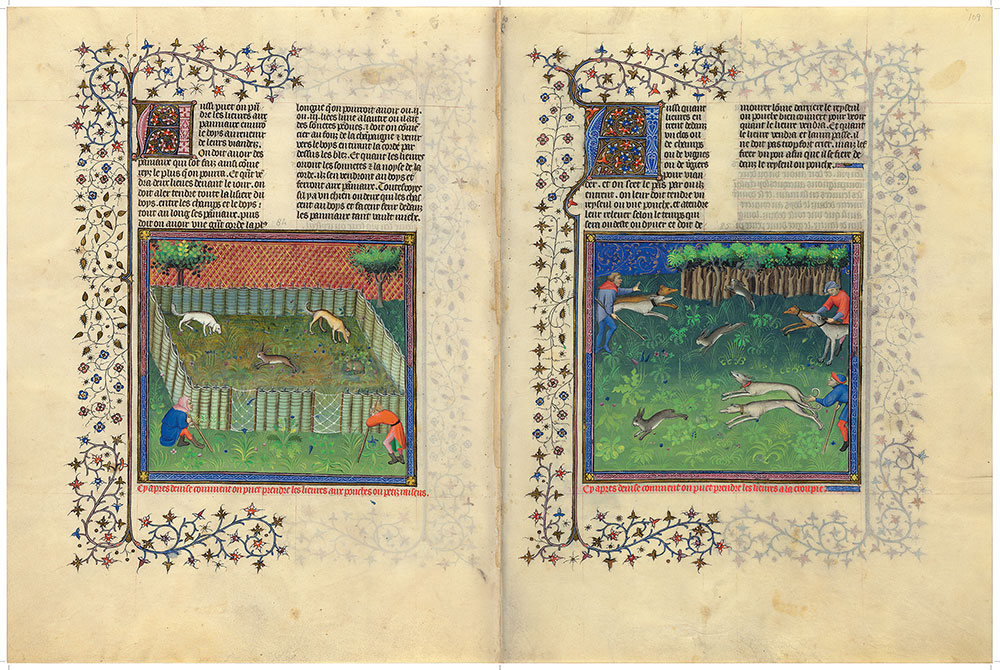
Livre de la chasse
Bequest of Clara S. Peck, 1983
Image courtesy of Faksimile Verlag Luzern
MS M.1044, fols. 109v–110r
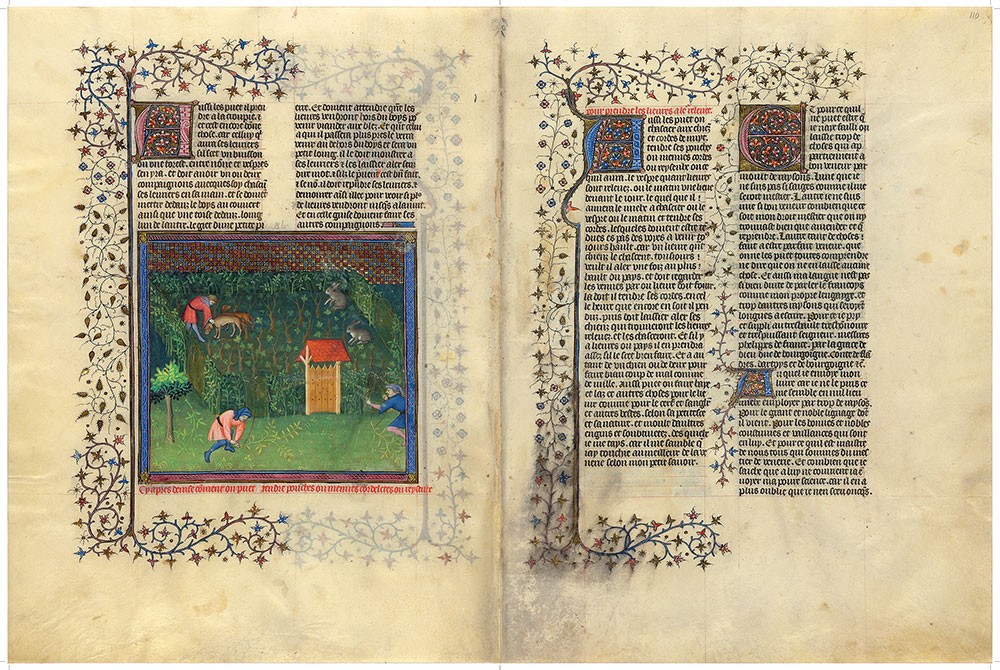
Livre de la chasse
Bequest of Clara S. Peck, 1983
Image courtesy of Faksimile Verlag Luzern
MS M.1044, fols. 110v–111r
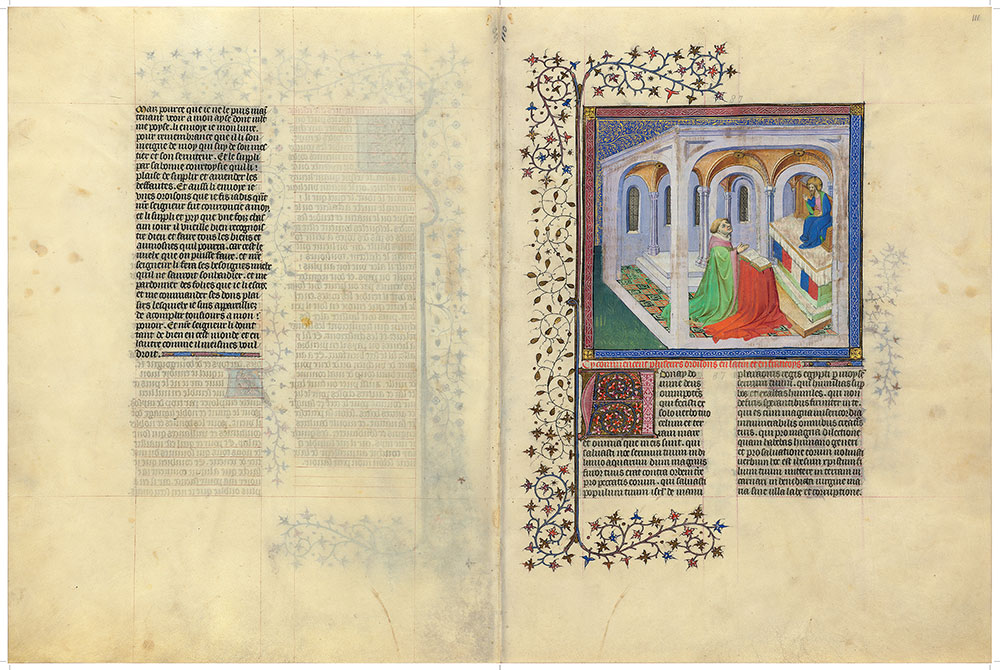
Livre de la chasse
Bequest of Clara S. Peck, 1983
Phoebus Praying in His Chapel
Just as Phoebus began his prologue invoking the Trinity and the Mother of God, he ended his work with thirty-seven oraisons (prayers) in Latin and French, an even greater expression of piety. In the last, he expressed his hope that the Almighty had given him his benevolent ear. In the miniature, Phoebus kneels on the red fabric draped over his prie-dieu. His hands are folded in prayer before an open book as he pleads for mercy and deliverance. He seems to have a dialogue with Christ, who, seated on the altar, holds an orb in one hand and blesses him with the other. In the thirty-second prayer, he used the hunt as a metaphor. After humbly stating that all good (glory) came from the Lord and that only bad (shame) came from him, he thanked the Lord for having opened his eyes and showing him the light and the way, making it possible for him to proclaim, "praise be to the Lord, who has not delivered me to the devil, like an animal captured by a hunter."
Image courtesy of Faksimile Verlag Luzern
MS M.1044, fols. 111v–112r
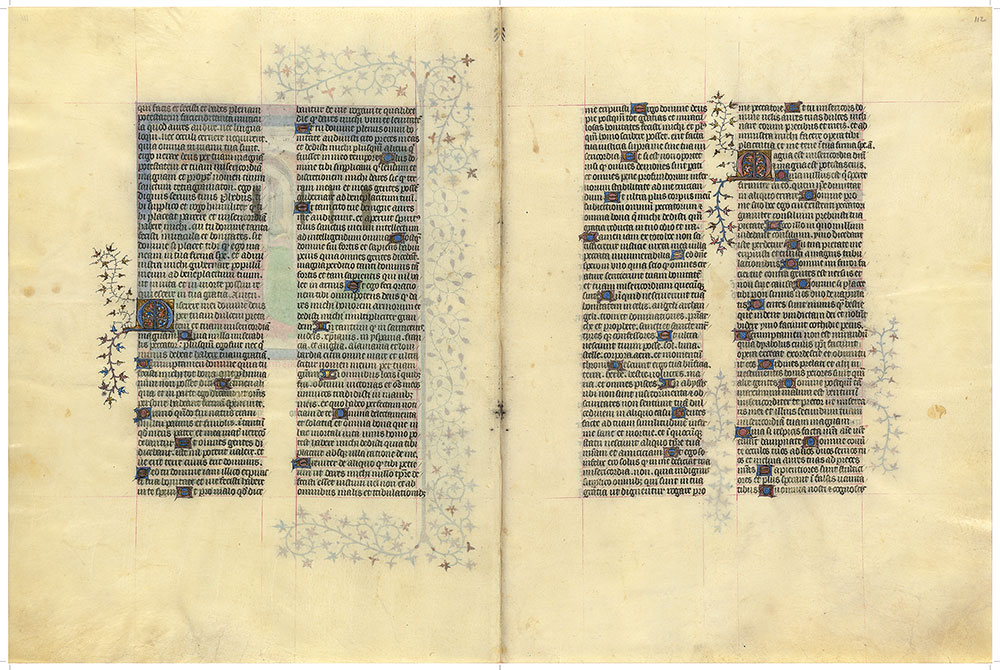
Livre de la chasse
Bequest of Clara S. Peck, 1983
Image courtesy of Faksimile Verlag Luzern
MS M.1044, fols. 112v–113r
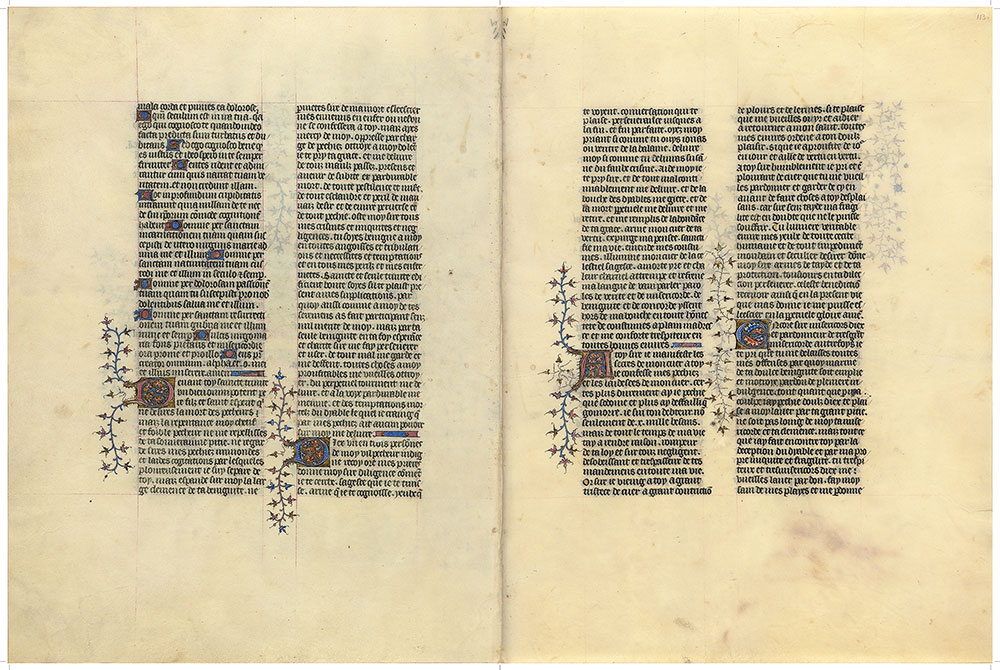
Livre de la chasse
Bequest of Clara S. Peck, 1983
Image courtesy of Faksimile Verlag Luzern
MS M.1044, fols. 113v–114r

Livre de la chasse
Bequest of Clara S. Peck, 1983
Image courtesy of Faksimile Verlag Luzern
MS M.1044, fols. 114v–115r
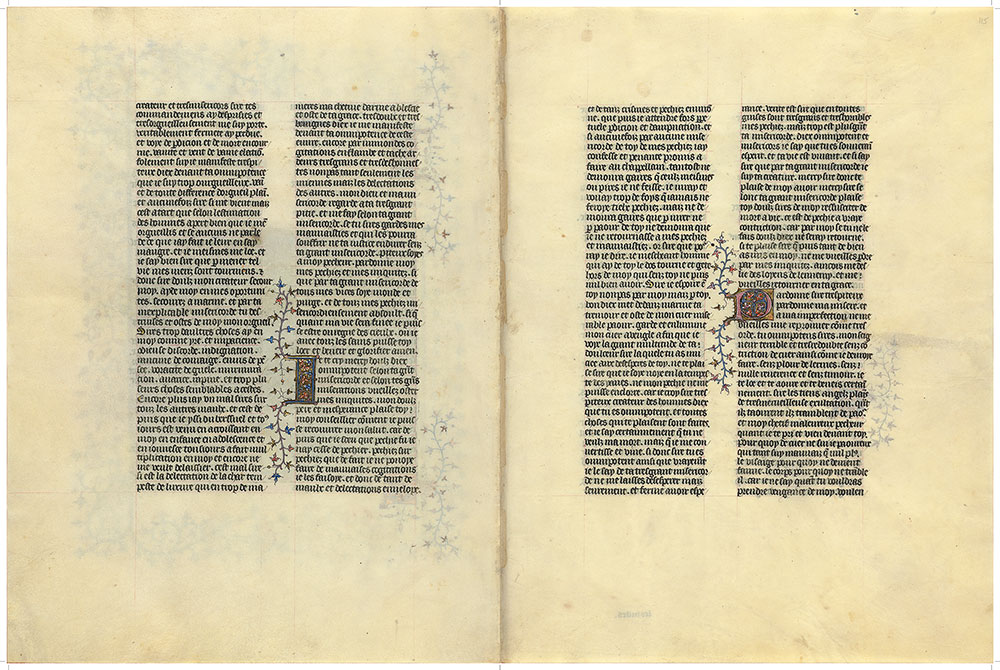
Livre de la chasse
Bequest of Clara S. Peck, 1983
Image courtesy of Faksimile Verlag Luzern
MS M.1044, fols. 115v–116r
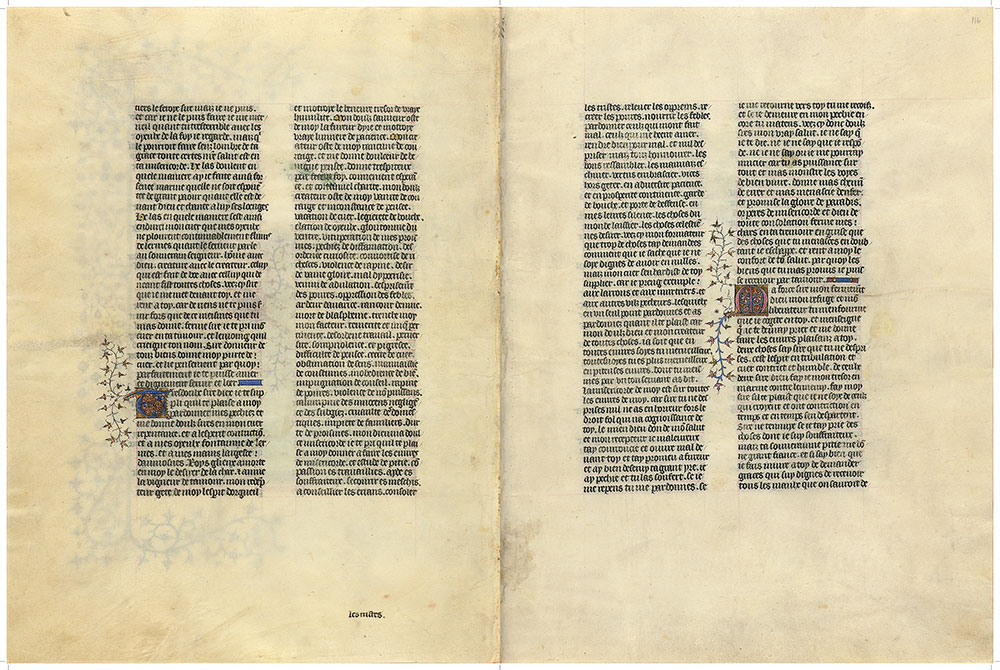
Livre de la chasse
Bequest of Clara S. Peck, 1983
Image courtesy of Faksimile Verlag Luzern
MS M.1044, fols. 116v–117r
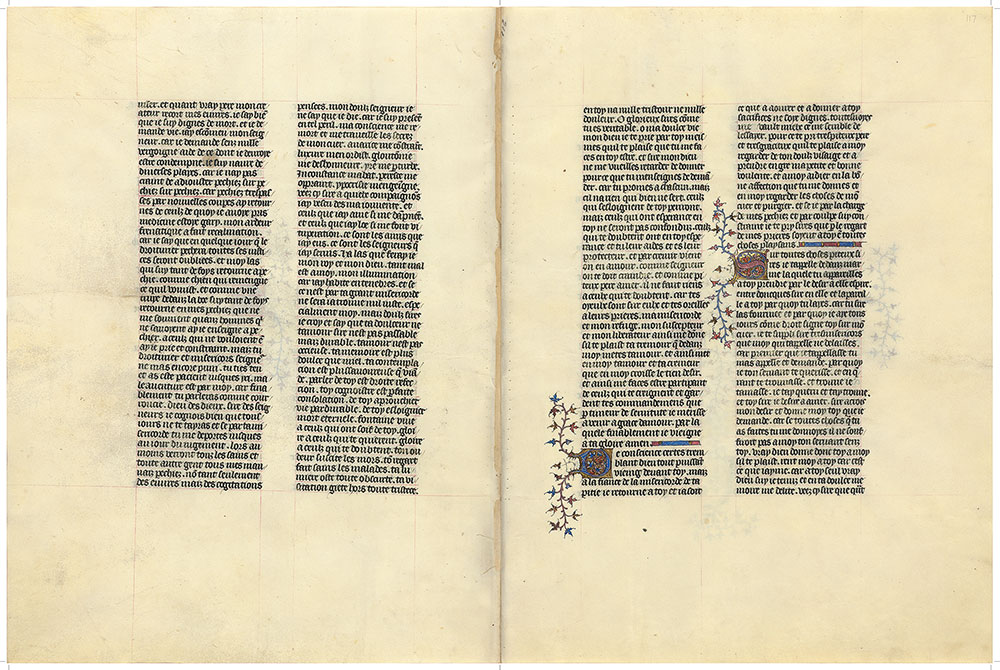
Livre de la chasse
Bequest of Clara S. Peck, 1983
Image courtesy of Faksimile Verlag Luzern
MS M.1044, fols. 117v–118r
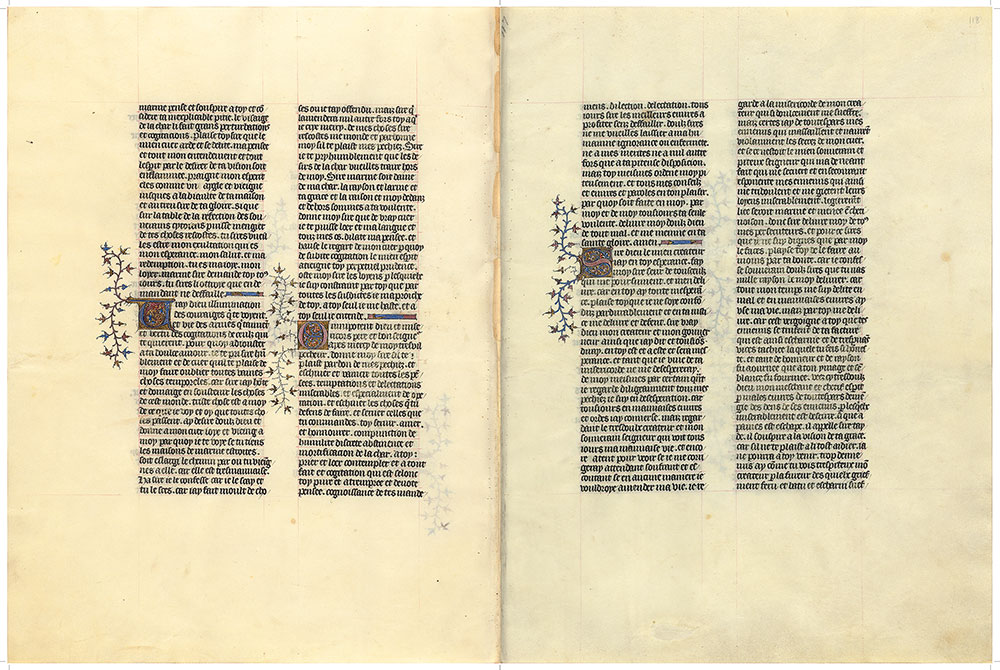
Livre de la chasse
Bequest of Clara S. Peck, 1983
Image courtesy of Faksimile Verlag Luzern
MS M.1044, fols. 118v–119r
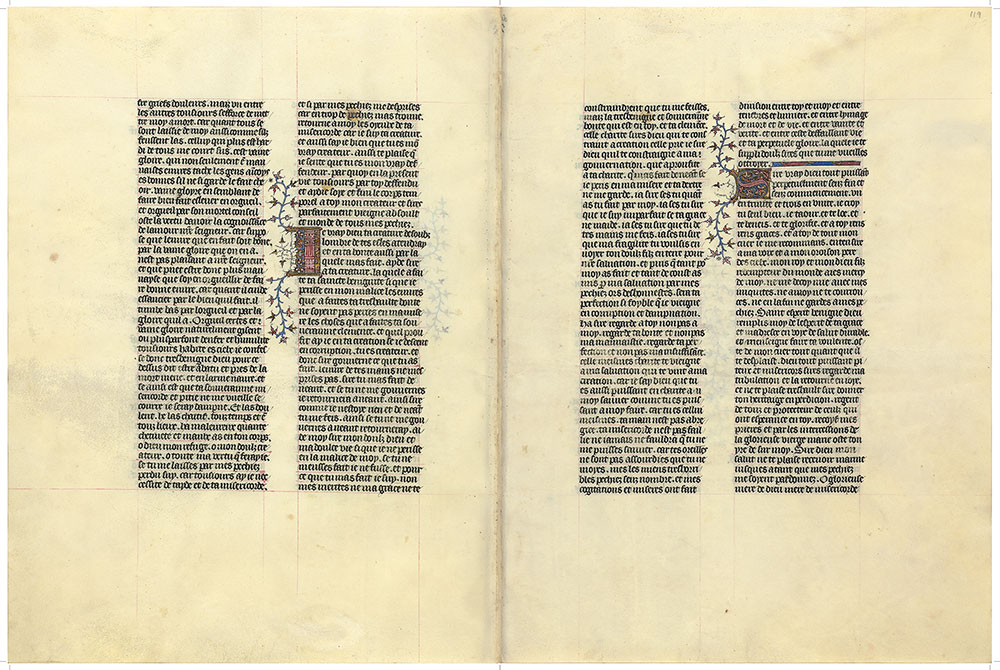
Livre de la chasse
Bequest of Clara S. Peck, 1983
Image courtesy of Faksimile Verlag Luzern
MS M.1044, fols. 119v–120r
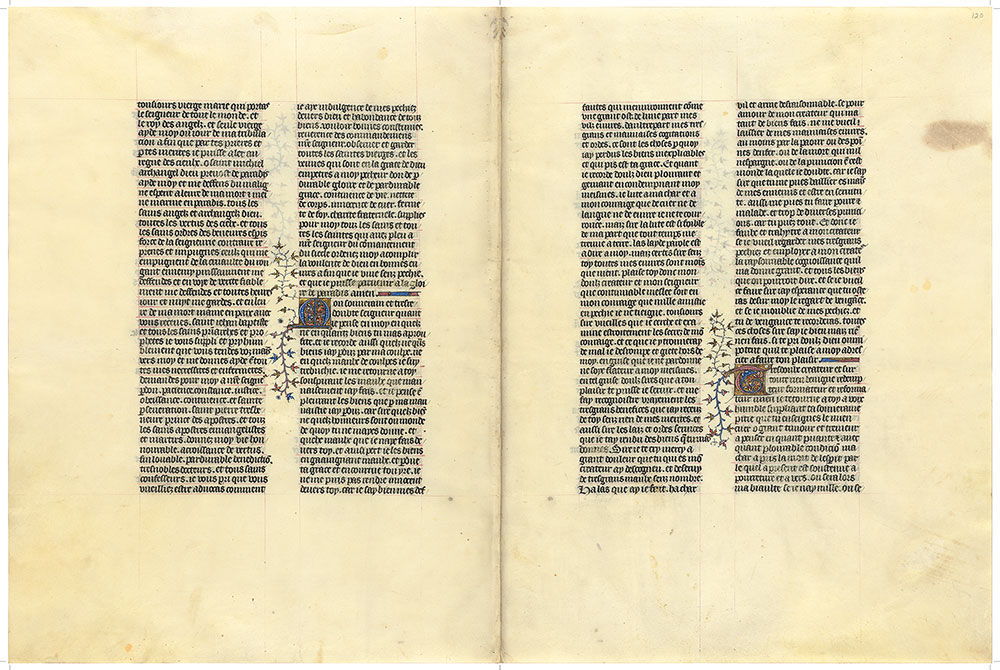
Livre de la chasse
Bequest of Clara S. Peck, 1983
Image courtesy of Faksimile Verlag Luzern
MS M.1044, fols. 120v–121r
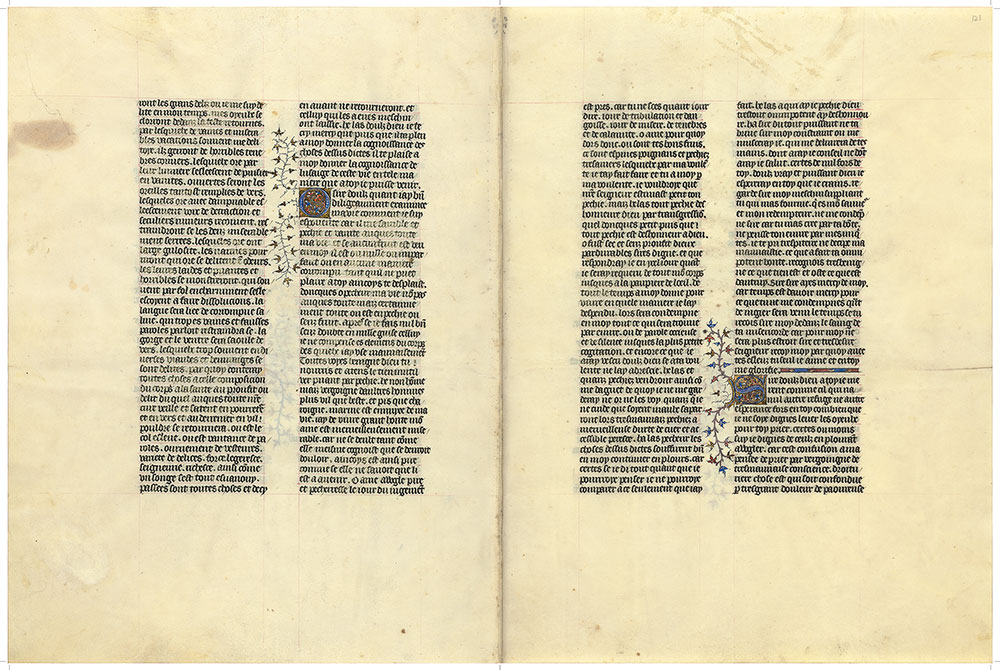
Livre de la chasse
Bequest of Clara S. Peck, 1983
Image courtesy of Faksimile Verlag Luzern
MS M.1044, fols. 121v–122r
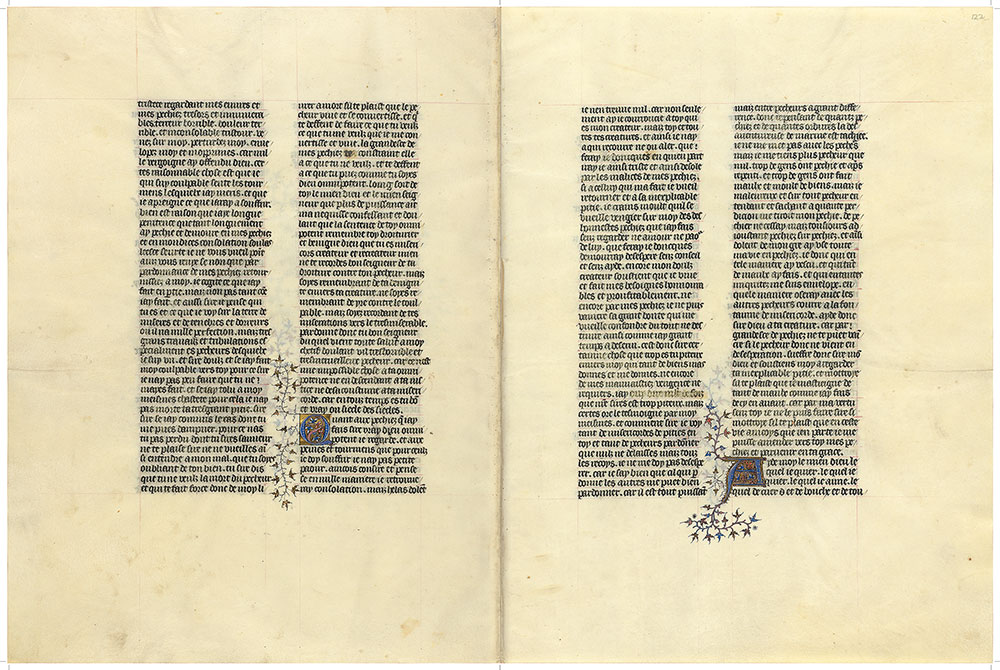
Livre de la chasse
Bequest of Clara S. Peck, 1983
Image courtesy of Faksimile Verlag Luzern
MS M.1044, fols. 122v–123r
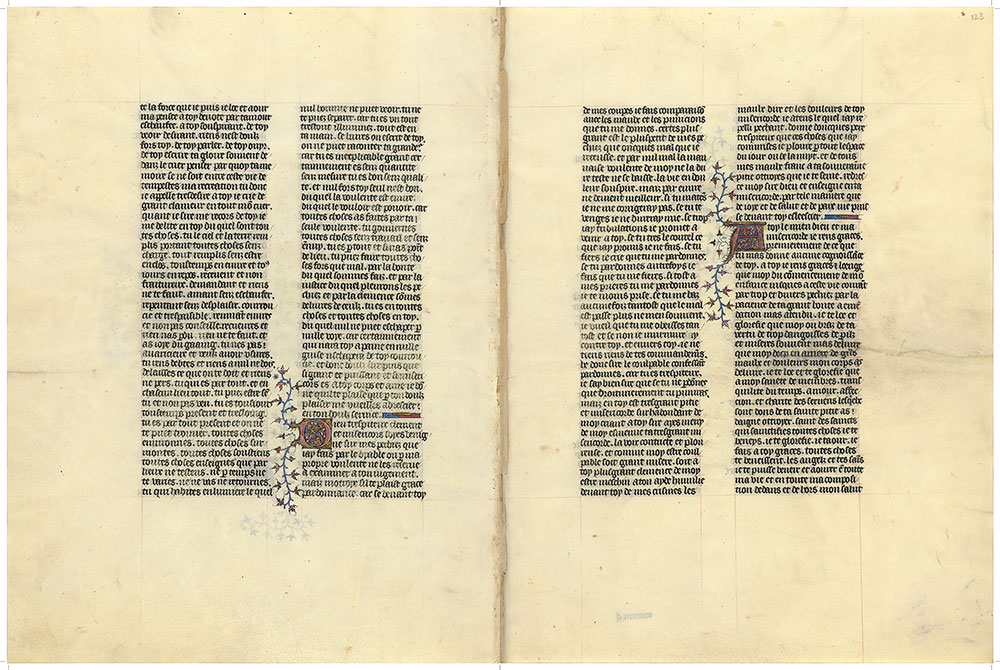
Livre de la chasse
Bequest of Clara S. Peck, 1983
Image courtesy of Faksimile Verlag Luzern
MS M.1044, fols. 123v–124r
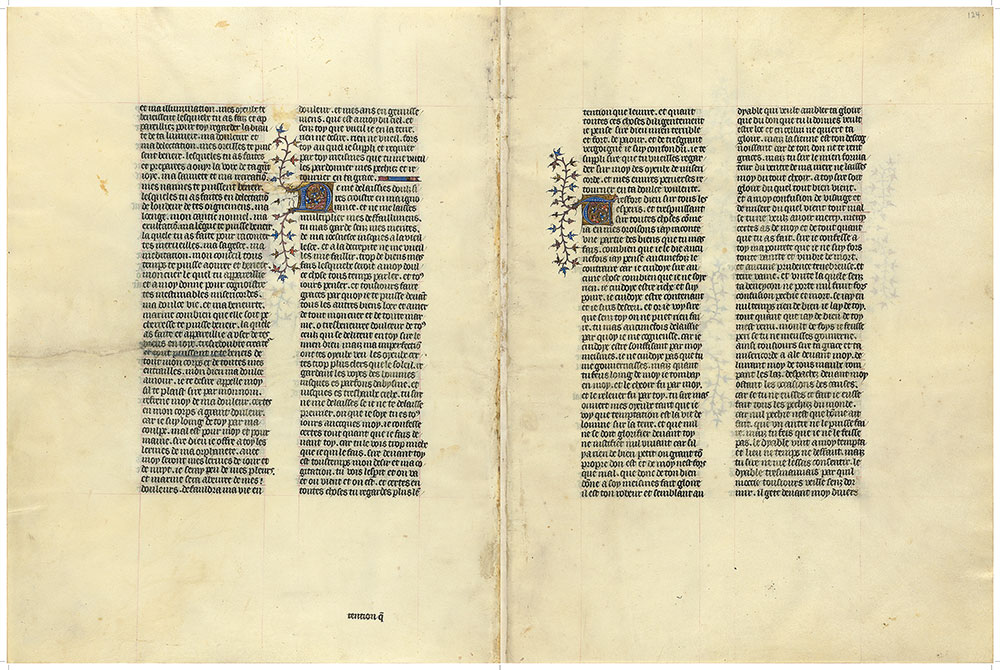
Livre de la chasse
Bequest of Clara S. Peck, 1983
Image courtesy of Faksimile Verlag Luzern
MS M.1044, fols. 124v–125r
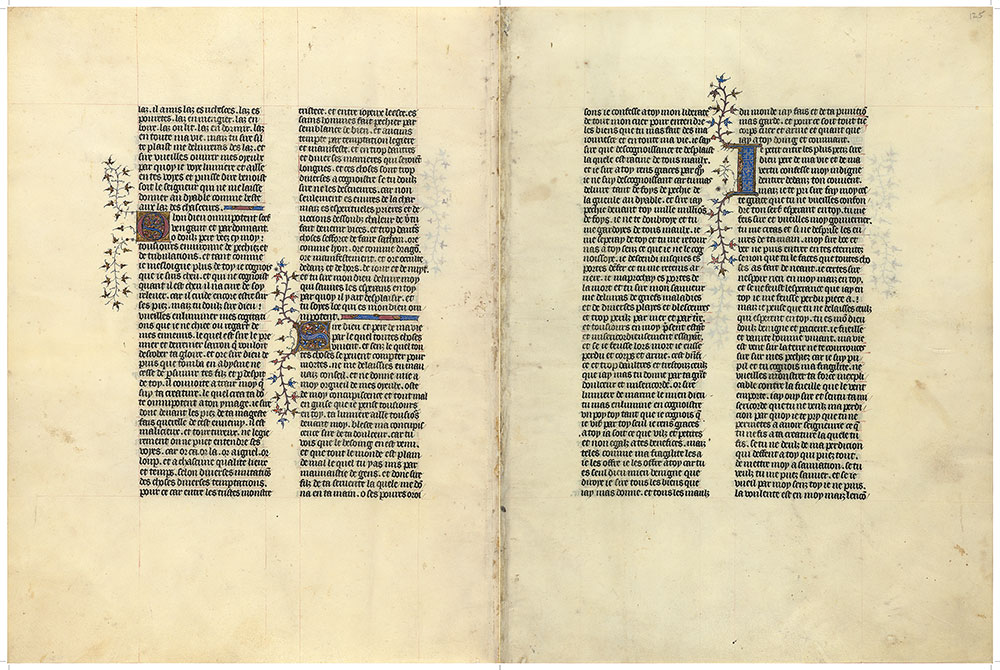
Livre de la chasse
Bequest of Clara S. Peck, 1983
Image courtesy of Faksimile Verlag Luzern
MS M.1044, fols. 125v–126r

Livre de la chasse
Bequest of Clara S. Peck, 1983
Image courtesy of Faksimile Verlag Luzern
MS M.1044, fols. 126v–127r
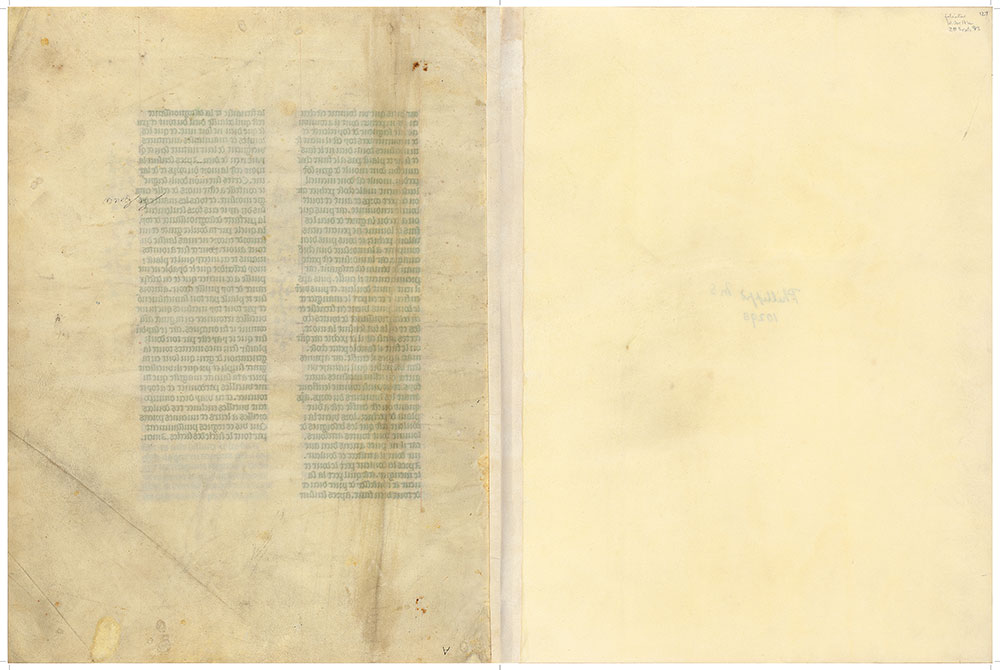
Livre de la chasse
Bequest of Clara S. Peck, 1983
Image courtesy of Faksimile Verlag Luzern